
- •Table of Contents
- •Literature Search Criteria and Guidelines Update Methodology
- •Staging and Prognosis
- •The Role of PET Imaging in Patient Management
- •Interim PET Imaging
- •Principles of Radiation Therapy
- •Treatment Guidelines
- •Diagnosis and Workup
- •Classic Hodgkin Lymphoma
- •Stage I–II
- •NCCN Recommendations for Stage I–II Favorable, Non-Bulky Disease
- •Preference to Treat with Combined Modality Therapy
- •Preference to Treat with Chemotherapy Alone
- •NCCN Recommendations for Stage I–II Unfavorable, Non-Bulky Disease
- •Preference to Treat with Combined Modality Therapy
- •Preference to Treat with Chemotherapy Alone
- •NCCN Recommendations for Stage I–II Unfavorable, Bulky Mediastinal Disease or Adenopathy >10 cm
- •Stage III–IV
- •NCCN Recommendations for Stage III–IV Disease
- •Management of Classic Hodgkin Lymphoma in Older Adults (>60 years)
- •NCCN Recommendations for Older Adults (Age >60 years) with CHL
- •Stage I–II Favorable Disease
- •Stage I–II Unfavorable or Stage III–IV Disease
- •Nodular Lymphocyte-Predominant Hodgkin Lymphoma
- •Follow-up After Completion of Treatment
- •Monitoring for Late Effects
- •Secondary Cancers
- •Cardiovascular Disease
- •Hypothyroidism
- •Myelosuppression
- •Infertility
- •Pulmonary Toxicity
- •Refractory or Relapsed Disease
- •Relapsed or Refractory Classic Hodgkin Lymphoma
- •NCCN Recommendations for Refractory CHL
- •NCCN Recommendations for Relapsed CHL
- •NCCN Recommendations for the Management of Relapsed or Refractory CHL in Older Adults (Aged >60 years)
- •Relapsed or Refractory Nodular Lymphocyte-Predominant Hodgkin Lymphoma
- •NCCN Recommendations for Refractory or Suspected Relapsed NLPHL
- •Summary
- •References
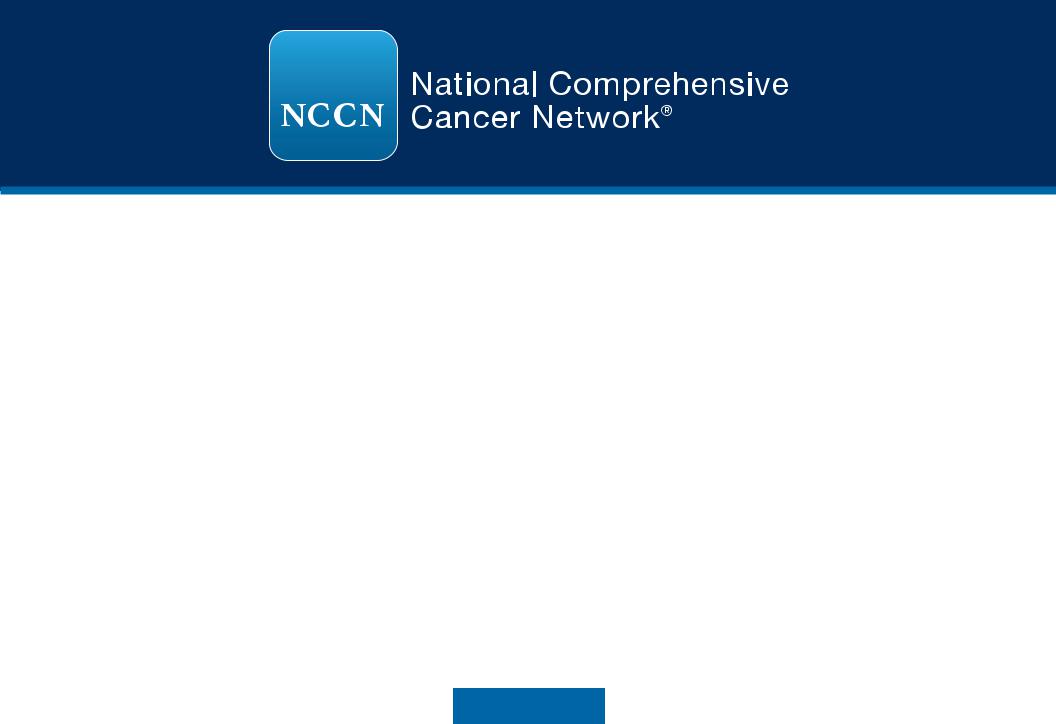
NCCN Clinical Practice Guidelines in Oncology (NCCN Guidelines®)
Hodgkin Lymphoma
Version 3.2021 — March 12, 2021
NCCN.org
NCCN Guidelines for Patients® available at www.nccn.org/patients
Continue
Version 3.2021, 03/12/21 © 2021 National Comprehensive Cancer Network® (NCCN®), All rights reserved. NCCN Guidelines® and this illustration may not be reproduced in any form without the express written permission of NCCN.
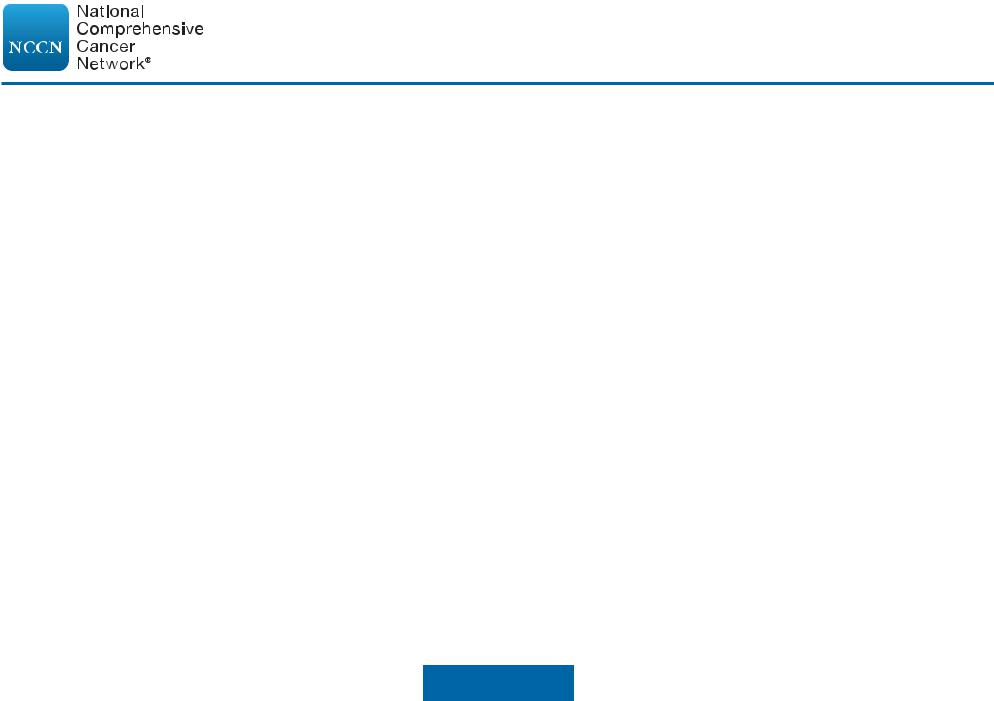
Printed by Ampleeva Olga on 3/26/2021 1:09:47 AM. For personal use only. Not approved for distribution. Copyright © 2021 National Comprehensive Cancer Network, Inc., All Rights Reserved.
NCCN Guidelines Version 3.2021
Hodgkin Lymphoma
NCCN Guidelines Index
Table of Contents
Discussion
*Richard T. Hoppe, MD/Chair §
Stanford Cancer Institute
*Ranjana H. Advani, MD/Vice Chair †
Stanford Cancer Institute
Weiyun Z. Ai, MD, PhD ‡ †
UCSF Helen Diller Family
Comprehensive Cancer Center
Richard F. Ambinder, MD, PhD †
The Sidney Kimmel Comprehensive
Cancer Center at John Hopkins
Philippe Armand, MD, PhD ‡
Dana-Farber/Brigham and Women’s
Cancer Center
Celeste M. Bello, MD, MSPH †
Moffitt Cancer Center
Cecil M. Benitez, MD, PhD ¥
Stanford Cancer Institute
Kirsten M. Boughan, MD ‡ ξ
Case Comprehensive Cancer Center/
University Hospitals Seidman Cancer
Center and Cleveland Clinic Taussig
Cancer Institute
Weina Chen, MD, PhD ≠
UT Southwestern Simmons
Comprehensive Cancer Center
Bouthaina Dabaja, MD §
The University of Texas
MD Anderson Cancer Center
Leo I. Gordon, MD ‡
Robert H. Lurie Comprehensive Cancer
Center of Northwestern University
Neil Hansen, MD ф
Fred & Pamela Buffett Cancer Center
Francisco J. Hernandez-Ilizaliturri, MD †
Roswell Park Comprehensive
Cancer Center
NCCN Guidelines Panel Disclosures
Alex F. Herrera, MD ‡ ξ
City of Hope
National Medical Center
Ephraim P. Hochberg, MD †
Massachusetts General Hospital
Cancer Center
Jiayi Huang, MD §
Siteman Cancer Center at Barnes-
Jewish Hospital and Washington
University School of Medicine
Patrick B. Johnston, MD, PhD † Þ
Mayo Clinic Cancer Center
Mark S. Kaminski, MD †
University of Michigan
Rogel Cancer Center
Christopher R. Kelsey, MD §
Duke Cancer Institute
Vaishalee P. Kenkre, MD ‡
University of Wisconsin
Carbone Cancer Center
Nadia Khan, MD †
Fox Chase Cancer Center
Ryan C. Lynch, MD † ‡
Fred Hutchinson Cancer Research
Center/Seattle Cancer Care Alliance
Kami Maddocks, MD ‡
The Ohio State University Comprehensive
Cancer CenterJames Cancer Hospital
and Solove Research Institute
Jonathan McConathy, MD, PhD f
O'Neal Comprehensive
Cancer Center at UAB
Continue
Monika Metzger, MD € ‡
St. Jude Children’s Research Hospital/
The University of Tennessee
Health Science Center
David Morgan, MD † ‡ ξ
Vanderbilt-Ingram Cancer Center
Carolyn Mulroney, MD † ‡ ξ
UC San Diego Moores Cancer Center
Sheeja T. Pullarkat, MD ≠
UCLA Jonsson Comprehensive Cancer Center
Rachel Rabinovitch, MD §
University of Colorado Cancer Center
Karen C. Rosenspire, MD, PhD ф
Abramson Cancer Center at the University of
Pennsylvania
Stuart Seropian, MD † Þ
Yale Cancer Center/
Smilow Cancer Hospital
Randa Tao, MD §
Huntsman Cancer Institute
at the University of Utah
Jane N. Winter, MD ‡ †
Robert H. Lurie Comprehensive Cancer
Center of Northwestern University
Joachim Yahalom, MD §
Memorial Sloan Kettering Cancer Center
NCCN
Jennifer Burns
Mallory Campbell, PhD
x Bone marrow |
f Nuclear medicine |
transplantation |
≠ Pathology |
ф Diagnostic radiology |
¥ Patient advocacy |
‡ Hematology/ |
€ Pediatric oncology |
Hematology oncology |
§ Radiation oncology |
Þ Internal medicine |
* Discussion writing |
† Medical oncology |
committee member |
Version 3.2021, 03/12/21 © 2021 National Comprehensive Cancer Network® (NCCN®), All rights reserved. NCCN Guidelines® and this illustration may not be reproduced in any form without the express written permission of NCCN.

Printed by Ampleeva Olga on 3/26/2021 1:09:47 AM. For personal use only. Not approved for distribution. Copyright © 2021 National Comprehensive Cancer Network, Inc., All Rights Reserved.
NCCN Guidelines Version 3.2021
Hodgkin Lymphoma
NCCN Guidelines Index
Table of Contents
Discussion
NCCN Hodgkin Lymphoma Panel Members
Summary of Guidelines Updates
Diagnosis and Workup (HODG-1)
Clinical Staging for Classic Hodgkin Lymphoma (HODG-2)
Primary Treatment of Classic Hodgkin Lymphoma (CHL):
•CS I–II Favorable (I/IIA, non-bulky) (HODG-3)
•CS I–II Unfavorable (I/IIB, B-symptoms or bulky mediastinal disease or >10 cm adenopathy) (HODG-4)
•CS III–IV (HODG-5)
Primary Treatment of Nodular Lymphocyte-Predominant Hodgkin Lymphoma (NLPHL):
•CS IA–IV (HODG-8)
Follow-up After Completion of Treatment and Monitoring for Late Effects (HODG-9)
Refractory CHL (HODG-11) Suspected Relapse of CHL (HODG-12)
Refractory or Suspected Relapse of NLPHL (HODG-13) Principles of FDG-PET/CT (HODG-A)
Principles of Unfavorable Risk Factors Unfavorable Risk Factors for Stage I–II CHL (HODG-B) Principles of Systemic Therapy (HODG-C)
Principles of Radiation Therapy (HODG-D)
•General Principles (HODG-D 1 of 11)
•RT Dose Constraints for Lymphoma (HODG-D, 3 of 11) Management of CHL in Older Adults (Age >60) (HODG-E) Staging (ST-1)
Clinical Trials: NCCN believes that the best management for any patient with cancer is in a clinical trial.
Participation in clinical trials is especially encouraged.
To find clinical trials online at NCCN
Member Institutions, click here: nccn. org/clinical_trials/member_institutions. aspx.
NCCN Categories of Evidence and Consensus: All recommendations
are category 2A unless otherwise indicated.
See NCCN Categories of Evidence and Consensus.
NCCN Categories of Preference:
All recommendations are considered appropriate.
See NCCN Categories of Preference.
The NCCN Guidelines® are a statement of evidence and consensus of the authors regarding their views of currently accepted approaches to treatment. Any clinician seeking to apply or consult the NCCN Guidelines is expected to use independent medical judgment in the context of individual clinical circumstances to determine any patient’s care or treatment. The National Comprehensive Cancer Network® (NCCN®) makes no representations or warranties of any kind regarding their content, use or application and disclaims any responsibility for their application or use in any way. The NCCN Guidelines are copyrighted by National Comprehensive Cancer Network®. All rights reserved. The NCCN Guidelines and the illustrations herein may not be reproduced in any form without the express written permission of NCCN. ©2021.
Version 3.2021, 03/12/21 © 2021 National Comprehensive Cancer Network® (NCCN®), All rights reserved. NCCN Guidelines® and this illustration may not be reproduced in any form without the express written permission of NCCN.

Printed by Ampleeva Olga on 3/26/2021 1:09:47 AM. For personal use only. Not approved for distribution. Copyright © 2021 National Comprehensive Cancer Network, Inc., All Rights Reserved.
NCCN Guidelines Version 3.2021
Hodgkin Lymphoma
NCCN Guidelines Index
Table of Contents
Discussion
Updates in Version 3.2021 of the NCCN Guidelines for Hodgkin Lymphoma from Version 2.2021 include:
HODG-D (3 of 11)
• New section added: RT Dose Constraints for Lymphoma
HODG-D (9 of 11)
• References have been updated.
Version 3.2021, 03/12/21 © 2021 National Comprehensive Cancer Network® (NCCN®), All rights reserved. NCCN Guidelines® and this illustration may not be reproduced in any form without the express written permission of NCCN.
Continued
UPDATES

Printed by Ampleeva Olga on 3/26/2021 1:09:47 AM. For personal use only. Not approved for distribution. Copyright © 2021 National Comprehensive Cancer Network, Inc., All Rights Reserved.
NCCN Guidelines Version 3.2021
Hodgkin Lymphoma
NCCN Guidelines Index
Table of Contents
Discussion
Updates in Version 2.2021 of the NCCN Guidelines for Hodgkin Lymphoma from Version 1.2021 include:
HODG-5
•Footnote o added: The degree of abnormality of a Deauville 4 score is quite variable and may influence further therapy. (eg, If only focally positive, it may be feasible to continue with 2 more cycles of ABVD and then repeat the PET scan. For a scan that remains positive throughout the area(s) of initial disease the consensus is to escalate therapy (with consideration of biopsy, especially if an easily accessible site).
Updates in Version 1.2021 of the NCCN Guidelines for Hodgkin Lymphoma from Version 2.2020 include:
General
• Algorithms for early-stage classic HL have been combined and significantly revised:
CS I-II Favorable (I/IIA, non-bulky)
CS I-II Unfavorable (I/IIB or bulky mediastinal disease or >10 cm adenopathy)
• Important considerations added:
Selection of treatment (combined modality therapy or chemotherapy alone) should be based upon patient age, sex, family history of cancer or cardiac disease, comorbid conditions, and sites of involvement (especially within mediastinum or axilla).
In general, treatment with combined modality therapy provides for a better PFS/FFP, but no difference in overall survival.
Most patients will benefit from multidisciplinary input prior to final treatment decisions.
HODG-1
• Diagnostic CT (contrast-enhanced) moved from "essential" to "useful in selected cases"
• Useful in selected cases
7th bullet modified: Adequate bone marrow biopsy if there are unexplained cytopenias other than anemia (eg, thrombocytopenia or neutropenia) cytopenias and negative PET
8th bullet modified: Evaluation of ejection fraction if doxorubicin anthracycline-based chemotherapy is indicated
9th bullet modified: MRI to select sites, with contrast unless contraindicated
• Footnotes modified:
a: Fine-needle aspiration (FNA) alone, in distinction from a core biopsy, is generally insufficient for diagnosis. except in unusual circumstances when in combination with immunohistochemistry it is judged adequate by a hematopathologist or cytopathologist.
b: "... EBER is recommedned at initial diagnosis. An expanded panel of markers (eg, EBER MUM-1,BOB-1, OCT-2) may be required. See NCCN Guidelines for B-Cell Lymphomas. For
NLPHL, immunoarchitectural pattern should be specified as typical vs. variant.
c: Imaging should be obtained in accordance with the American College of Radiology (ACR) practice guidelines. CT is considered diagnostic if it is enhanced with oraland/or IV-contrast.
d: See Principles of FDG-PET/CT (HODG-A). PET/CT should be obtained in accordance with American College of Radiology (ACR) practice guidelines. PET/CT should be done...
Version 3.2021, 03/12/21 © 2021 National Comprehensive Cancer Network® (NCCN®), All rights reserved. NCCN Guidelines® and this illustration may not be reproduced in any form without the express written permission of NCCN.
Continued
UPDATES

Printed by Ampleeva Olga on 3/26/2021 1:09:47 AM. For personal use only. Not approved for distribution. Copyright © 2021 National Comprehensive Cancer Network, Inc., All Rights Reserved.
NCCN Guidelines Version 3.2021
Hodgkin Lymphoma
Updates in Version 1.2021 of the NCCN Guidelines for Hodgkin Lymphoma from Version 2.2020 include:
HODG-2
• Table significantly modified.
• Columns removed: Number of Nodal Sites; Erythrocyte Sedimentation Rate (ESR) (at diagnosis)
• Footnote removed: E-lesions are defined by the HD10 study as localized involvement of extralymphatic tissue (by continuous growth from an involved lymph node or in close anatomic relation) that is treatable by irradiation. (Engert A, et al. N Engl J Med 2010;363:640-652.)
HODG-3 and HODG-4
• References have been added throughout the algorithms. See HODG-7A for references. (Also applies to HODG-5/6/7)
• Footnote added: The degree of abnormality of a Deauville 4 score is quite variable and may influence further therapy. (eg, If only focally positive, it may be feasible to continue with 2 more cycles of ABVD and then repeat the PET scan. For a scan that remains positive throughout the area(s) of initial disease the consensus is to escalate therapy (with consideration of biopsy, especially if an easily accessible site). (Also on HODG-4)
• Footnote added: A Deauville 5 score should prompt re-biopsy, especially if a readily accessible site, which would then inform subsequent therapy. If a biopsy is not performed, treatment should be escalated. (Also on HODG-4/5/6/7)
• Footnotes removed:
Other recommended primary therapy regimens include: Stanford V x 8 weeks + 30 Gy ISRT (Advani RH, et al. Ann Oncol 2013;24:1044-1048.)
Other recommended primary therapy regimens include: Stanford V x 12 weeks + 30 Gy ISRT (Gordon LI, et al. J Clin Oncol 2013;31:684-691.); If GHSG HD14 unfavorable (see HODG-B): Escalated BEACOPP x 2 cycles followed by ABVD x 2 cycles + 30 Gy ISRT (von Tresckow B, et al. J Clin Oncol 2012;30:907-913.)
Other recommended regimens: Stanford V x 12 weeks + ISRT in select patients where reduced cumulative doses of doxorubicin and/or bleomycin are desired. (Gordon LI, et al. J Clin Oncol 2013;31:684-691.); or Escalated BEACOPP x 2 cycles followed by ABVD x 2 cycles + 30 Gy ISRT (if GHSG HD14 unfavorable, see HODG-B. Patients with B symptoms in combination with bulky or extranodal disease were excluded and treated according to the algorithm for stage III–IV disease (HODG-9).)(von Tresckow B, et al. J Clin Oncol 2012;30:907-913)
Version 3.2021, 03/12/21 © 2021 National Comprehensive Cancer Network® (NCCN®), All rights reserved. NCCN Guidelines® and this illustration may not be reproduced in any form without the express written permission of NCCN.

Printed by Ampleeva Olga on 3/26/2021 1:09:47 AM. For personal use only. Not approved for distribution. Copyright © 2021 National Comprehensive Cancer Network, Inc., All Rights Reserved.
NCCN Guidelines Version 3.2021
Hodgkin Lymphoma
NCCN Guidelines Index
Table of Contents
Discussion
Updates in Version 1.2021 of the NCCN Guidelines for Hodgkin Lymphoma from Version 2.2020 include:
HODG-10 |
HODG-A |
|
||
• Bullet removed: Screening for secondary cancers as clinically |
• Interpretation |
|
||
indicated (See NCCN Guidelines for Survivorship). |
4th bullet modified: The final report for any PET/CT examination to |
|||
HODG-11 |
define response should include the Deauville 5-point scale score, |
|||
which is a visual score. |
|
|||
• Deauville 5, modified maintenance therapy: If response, |
|
|||
5th bullet modified: A second opinion/overread is encouraged of |
||||
consider transplant (autologous or allogeneic) stem cell |
||||
scans that are not initially interpreted by qualified individuals, when |
||||
transplant if response to secondary therapy |
||||
there is a discrepancy between the clinical presentation and radiology |
||||
• Footnote removed: Allotransplant is an option in select patients |
||||
report, and when no appropriate Deauville score has been provided. |
||||
as a category 3 recommendation. |
||||
• Footnote added: The role of maintenance brentuximab vedotin |
HODG-A (2 of 2) |
|
||
has not been well-defined in patients who received brentuximab |
• Table moved from former HODG-E. |
|
||
vedotin prior to maintenance therapy. |
• Added column to define negative and positive scores. |
|
||
• Footnote removed: Moskowitz CH, Nademanee A, Masszi T, |
• 4 modified: Uptake moderately higher than liver and visually above |
|||
et al. 1. Brentuximab vedotin as consolidation therapy after |
adjacent background activity |
|
||
autologous stem-cell transplantation in patients with Hodgkin's |
• Footnote added: Watchful waiting, biopsy, or additional imaging tests |
|||
lymphoma at risk of relapse or progression (AETHERA): a |
may be appropriate depending on clinical circumstances. Obtaining a |
|||
randomised, double-blind, placebo-controlled, phase 3 trial. |
second opinion/overread of the imaging may be beneficial |
|
||
Lancet 2015;385:1853-1862. |
HODG-B (2 of 2) |
|
||
HODG-12 |
• Table expanded to include infradiaphragmatic nodal regions. |
|
||
• Initial stage IA-IIA (no prior RT with failure in initial sites) |
HODG-C (1 of 5) |
|
||
Second-line therapy modified for patients who received |
|
|||
• Bullet modified: The most common variants of chemotherapy used at |
||||
abbreviated chemotherapy (3–4 cycles) without RT: |
||||
NCCN Member Institutions include ABVD and Stanford V. |
|
|||
◊ Option removed: RT alone in highly selected cases. |
|
|||
• Stanford V reference removed. |
|
|||
◊ Option modified: Second-line systemic therapy followed by |
|
|||
• Escalated BEACOPP reference added: Casasnovas RO, Bouabdallah |
||||
HDT/ASCR ± ISRT |
||||
R, Brice P, et al. PET-adapted treatment for newly diagnosed advanced |
||||
Second-line therapy modified for patients who received full- |
||||
Hodgkin lymphoma (AHL2011): a randomised, multicentre, non- |
||||
course chemotherapy: Second-line systemic therapy + RT or |
||||
inferiority, phase 3 study. Lancet Oncol 2019;20:202-215. |
|
|||
followed by HDT/ASCR ± ISRT |
|
|||
HODG-C (3 of 5) |
|
|||
• All others |
|
|||
Second-line therapy modified: Second-line systemic therapy |
• CHL, second-line option added: Pembrolizumab (for patients not |
|||
followed by HDT/ASCR ± ISRT |
candidates for transplant) |
|
||
• Footnote modified: Strongly consider radiation therapy for |
• NLPHL, second-line options added: |
|
||
selected sites that have not been previously irradiated. |
In a |
R-Bendamustine |
|
|
radiation-naive patient, TLI may be an appropriate component of |
R-CHOP (if not previously used) |
|
||
HDT. |
R-ABVD (if not previously used) |
|
||
• Footnote removed: For patients not considered suitable for |
R-CVP (if not previously used) |
|
||
more aggressive therapy, radiation therapy can be used alone |
|
|
||
as a second-line therapy and conventional involved-field or |
|
|
||
extended-field treatment is indicated. |
|
|
||
|
|
|
Continued |
|
Version 3.2021, 03/12/21 © 2021 National Comprehensive Cancer Network® (NCCN®), All rights reserved. NCCN Guidelines® and this illustration may not be reproduced in any form without the express written permission of NCCN. |
UPDATES |
|||

Printed by Ampleeva Olga on 3/26/2021 1:09:47 AM. For personal use only. Not approved for distribution. Copyright © 2021 National Comprehensive Cancer Network, Inc., All Rights Reserved.
NCCN Guidelines Version 3.2021
Hodgkin Lymphoma
NCCN Guidelines Index
Table of Contents
Discussion
Updates in Version 1.2021 of the NCCN Guidelines for Hodgkin Lymphoma from Version 2.2020 include:
HODG-C (5 of 5)
• References added.
HODG-E (1 of 2)
• Stage I–II Favorable Disease
Option removed: VEPEMB ± ISRT
• Stage I–II Unfavorable or Stage III–IV DiseaseOption removed: PVAG ± ISRT
Option removed: VEPEMB ± ISRT
• Footnote modified: Bleomycin should be used with caution as it may not be tolerated in older adults, and it should not be used beyond two cycles.
• ISRT doses have been removed, and a replaced with a footnote: See Principles of Radiation Therapy (HODG-E).
Version 3.2021, 03/12/21 © 2021 National Comprehensive Cancer Network® (NCCN®), All rights reserved. NCCN Guidelines® and this illustration may not be reproduced in any form without the express written permission of NCCN.
UPDATES
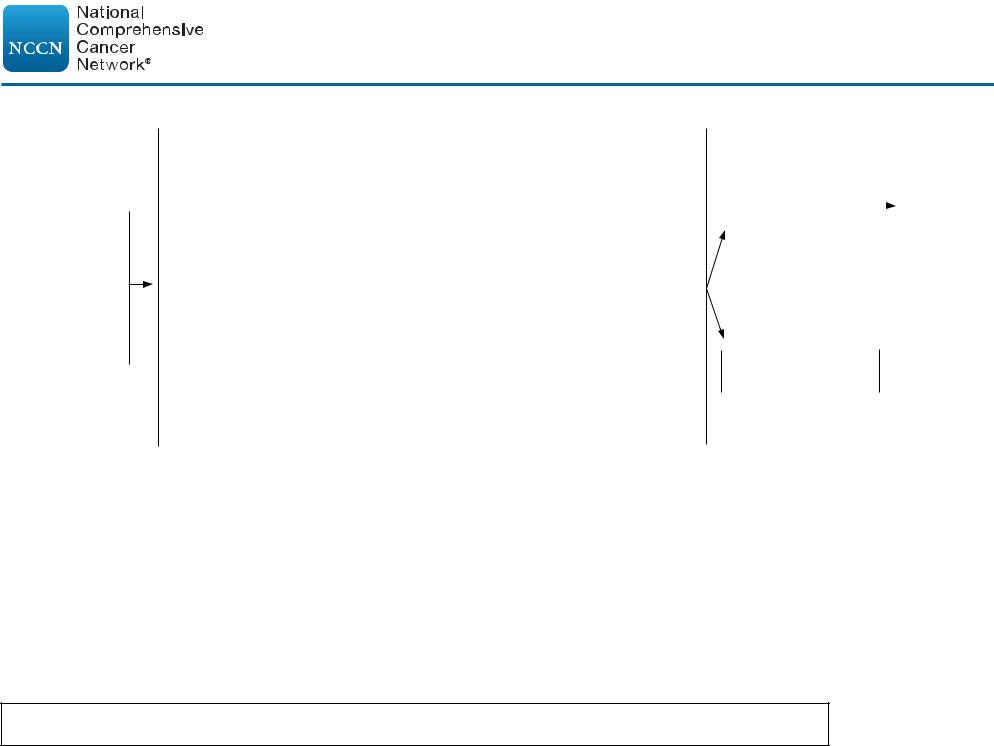
Printed by Ampleeva Olga on 3/26/2021 1:09:47 AM. For personal use only. Not approved for distribution. Copyright © 2021 National Comprehensive Cancer Network, Inc., All Rights Reserved.
NCCN Guidelines Version 3.2021
Hodgkin Lymphoma
NCCN Guidelines Index
Table of Contents
Discussion
DIAGNOSIS/WORKUP |
CLINICAL PRESENTATION |
•Excisional biopsy (recommended)
•Core needle biopsy may be adequate if diagnostica
•Immunohistochemistry evaluationb
Essential:
•H&P including: B symptoms (unexplained fever >38°C; drenching night sweats; or weight loss >10% of body weight within 6 mo of diagnosis), alcohol intolerance, pruritus, fatigue, performance status, examination of lymphoid regions, spleen, liver
•CBC, differential, platelets
•Erythrocyte sedimentation rate (ESR)
•Comprehensive metabolic panel, lactate dehydrogenase (LDH), and liver function test (LFT)
•Pregnancy test for women of childbearing age
•PET/CT scanc (skull base to midthigh or vertex to feet in selected cases)
•Counseling: Fertility, smoking cessation, psychosocial (See NCCN Guidelines for Supportive Care)
Useful in selected cases:
•Fertility preservationd
•Pulmonary function tests (PFTs incl. diffusing capacity [DLCO])e if ABVD or escalated BEACOPP are being used
•Pneumococcal, H-flu, meningococcal vaccines, if splenic RT contemplated
•HIV and hepatitis B/C testing (encouraged)
•Diagnostic CTf (contrast-enhanced)
•Chest x-ray (encouraged, especially if large mediastinal mass)
•Adequate bone marrow biopsy if there are unexplained cytopenias other than anemia (eg, thrombocytopenia or neutropenia) and negative PETg
•Evaluation of ejection fraction if anthracycline-based chemotherapy is indicated
•MRI to select sites, with contrast unless contraindicated
•PET/MRI (skull base to mid-thigh) without contrast
Classic Hodgkin |
|
See HODG-2 |
lymphoma (CHL)h |
|
|
|
|
Nodular lymphocyte-
predominant Hodgkin  See HODG-8 lymphoma (NLPHL)
See HODG-8 lymphoma (NLPHL)
aFine-needle aspiration (FNA) alone, in distinction from a core biopsy, is generally insufficient for diagnosis.
bTypical immunophenotype for CHL: CD15+, CD30+, PAX-5+ (weak);
CD3-, CD20- (majority), CD45-, CD79a-. Typical immunophenotype for NLPHL: CD20+, CD45+, CD79a+, BCL6+, PAX-5+; CD3-, CD15-, CD30-
(Swerdlow SH, Campo E, Harris NL, et al; WHO classification of tumours of haematopoietic and lymphoid tissues. Lyon, France: IARC; 2017). EBER is recommedned at initial diagnosis. An expanded panel of markers (eg, MUM-1,BOB-1, OCT-2) may be required, especially if equivocal diagnosis. See NCCN Guidelines for B-Cell Lymphomas. For NLPHL, immunoarchitectural pattern should be specified as typical vs. variant.
cSee Principles of FDG-PET/CT (HODG-A). PET/CT should be done with patient on a flat table with arms up, if possible. In cases of PET positivity where sites of disease are inconsistent with usual presentation of Hodgkin lymphoma or if an unusual disease presentation (ie, HIV),
additional clinical evaluation may be required to stage patient. See (ST-1).
dFertility preservation options include: semen cryopreservation, IVF, or ovarian tissue or oocyte cryopreservation.
eIn general, a DLCO threshold of ≥60% is acceptable for use of bleomycin.
fImaging should be obtained in accordance with the American College of Radiology (ACR) practice guidelines. CT is considered diagnostic if it is enhanced with oral and/or IV contrast. CT component of a conventional PET/CT is often
not IV contrast-enhanced. Although the diagnostic CT will often be neck/chest/ abdomen/pelvis, at minimum include the areas identified as abnormal on PET/CT.
gIn most instances, if the PET/CT displays a homogeneous pattern of marrow uptake (thought to be secondary to cytokine release) bone marrow involvement is not assumed. If there are multifocal (three or more) skeletal PET/CT lesions, marrow may be assumed to be involved. In general, bone marrow biopsies are no longer indicated.
hCHL includes nodular sclerosis (NSHL), mixed cellularity (MCHL), lymphocytedepleted (LDHL), and lymphocyte-rich (LRHL) subtypes. If grey-zone, see NCCN Guidelines for B-Cell Lymphomas.
Note: All recommendations are category 2A unless otherwise indicated.
Clinical Trials: NCCN believes that the best management of any patient with cancer is in a clinical trial. Participation in clinical trials is especially encouraged.
Version 3.2021, 03/12/21 © 2021 National Comprehensive Cancer Network® (NCCN®), All rights reserved. NCCN Guidelines® and this illustration may not be reproduced in any form without the express written permission of NCCN.
HODG-1

Printed by Ampleeva Olga on 3/26/2021 1:09:47 AM. For personal use only. Not approved for distribution. Copyright © 2021 National Comprehensive Cancer Network, Inc., All Rights Reserved.
NCCN Guidelines Version 3.2021
Hodgkin Lymphoma (Age ≥18 years)
NCCN Guidelines Index
Table of Contents
Discussion
CLINICAL STAGING/RISK CLASSIFICATION OF CLASSIC HODGKIN LYMPHOMA (CHL)i
Clinical Stage |
Bulky Mediastinal Diseasei |
Guidelines Page |
|
or |
|||
|
>10 cm Adenopathy |
|
|
I/IIA |
No |
Favorable Disease (HODG-3) |
|
|
|
||
Yes |
Unfavorable Disease (HODG-4) |
||
|
|||
|
|
|
|
IB/IIB |
Yes/No |
Unfavorable Disease (HODG-4) |
|
|
|
|
|
III–IV |
Yes/No |
HODG-5 |
|
|
|
|
•Selection of treatment (combined modality therapy or chemotherapy alone) should be based upon patient age, sex, family history of cancer or cardiac disease, comorbid conditions, and sites of involvement (especially within mediastinum or axilla).
•Most patients will benefit from multidisciplinary input prior to final treatment decisions.
iFor definitions of bulky disease and lymph node regions, see HODG-B.
Note: All recommendations are category 2A unless otherwise indicated.
Clinical Trials: NCCN believes that the best management of any patient with cancer is in a clinical trial. Participation in clinical trials is especially encouraged.
Version 3.2021, 03/12/21 © 2021 National Comprehensive Cancer Network® (NCCN®), All rights reserved. NCCN Guidelines® and this illustration may not be reproduced in any form without the express written permission of NCCN.
HODG-2
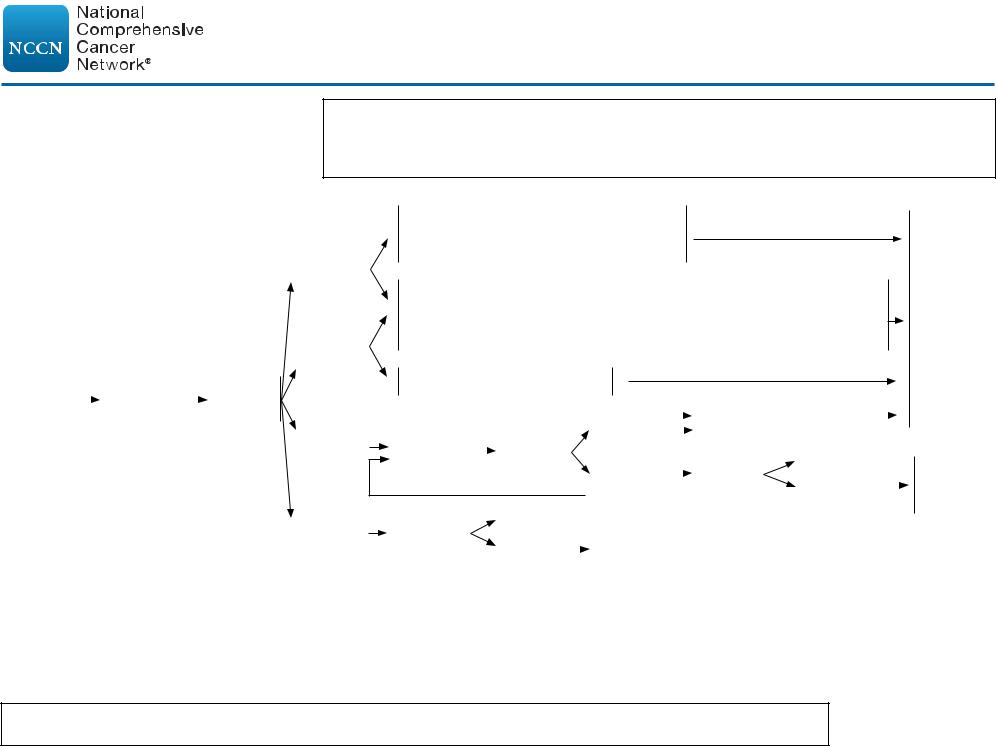
Printed by Ampleeva Olga on 3/26/2021 1:09:47 AM. For personal use only. Not approved for distribution. Copyright © 2021 National Comprehensive Cancer Network, Inc., All Rights Reserved.
NCCN Guidelines Version 3.2021
Hodgkin Lymphoma (Age ≥18 years)
NCCN Guidelines Index
Table of Contents
Discussion
CLINICAL PRESENTATION:
Stage I/IIA Favorable (Non-Bulky) CHLh,k
Important Considerations:
•Selection of treatment (combined modality therapy or chemotherapy alone) should be based upon patient age, sex, family history of cancer or cardiac disease, comorbid conditions, and sites of involvement (especially within mediastinum or axilla).
•In general, treatment with combined modality therapy provides for a better PFS/FFP, but no difference in overall survival.
•Most patients will benefit from multidisciplinary input prior to final treatment decisions.
PRIMARY TREATMENT
Deauville 1–2n
Deauville 3n
Stage I/IIA |
|
|
ABVD x |
|
|
Restage |
|
|
|
|
|||
|
|
|
|
|||
Favorable |
|
|
|
|
||
|
|
2 cyclesl |
|
|
with |
|
(Non-bulky) |
|
|
|
|
||
|
|
(category 1) |
|
|
PET/CTm |
|
CHLj,k |
|
|
|
|
|
|
Deauville 4n,o
Deauville 5n,p
h CHL includes NSHL, MCHL, LDHL, and LRHL subtypes. If grey-zone, see NCCN Guidelines for B-Cell Lymphomas.
k Individualized treatment may be necessary for older patients and patients with concomitant disease. See Management of Classic Hodgkin Lymphoma in Older Adults (HODG-E).
l See Principles of Systemic Therapy (HODG-C).
m An integrated PET/CT or a PET with a diagnostic CT is recommended. See Principles of FDG-PET/CT (HODG-A).
n See PET 5-Point Scale (Deauville Criteria) (HODG-A, 2 of 2).
ADDITIONAL THERAPY
Chemotherapy alone
ABVD x 2 cycles (per H10F, CALGB)q,1,2 or
ABVD x 1 cycle (per RAPID)3
Combined modality therapy
ISRT 20 Gyr (per GHSG HD10/16; if ESR <50, no e-lesions, <3 nodal sites per GHSG favorable criteria)4,5
or
ABVD x 1 cycle + ISRT 30 Gyr (per RAPID, H10F)2,3
Chemotherapy alone
AVD x 4 cycles (per RATHL)6
|
|
|
|
|
|
Deauville |
|
|
ISRT 30 Gyr (adapted |
|
|
|
||
ABVD x 2 |
|
|
|
Restage |
|
1–3n |
|
|
from RAPID, H10)2,3 |
|
|
|||
|
|
|
|
|
|
|||||||||
|
with |
|
|
|
|
|
|
|
|
|
|
|||
|
|
|
|
|
|
|
|
|
|
|
||||
cyclesl,q |
|
|
|
|
|
|
Negative |
|
|
|
|
|||
|
PET/CTm |
|
Deauville |
|
|
Biopsyp |
|
|
|
|||||
|
|
|
|
|
|
|
||||||||
Biopsyp |
|
Negative |
|
4–5n,o,p |
|
|
Positive |
|
|
|
|
|||
|
|
|
|
|
|
|
|
|
||||||
|
|
|
|
|
|
|
|
|
|
|
||||
|
|
|
|
|
|
|
|
|
|
|
||||
|
Positive |
|
See Refractory Disease (HODG-11) |
|
|
|||||||||
|
|
|
|
|
|
|
||||||||
See Follow-up (HODG-9)
See Refractory Disease (HODG-11)
oThe degree of abnormality of a Deauville 4 score is quite variable and may influence further therapy. (eg, If only focally positive, it may be feasible to continue with 2 more cycles of ABVD and then repeat the PET scan.) For a scan that remains positive throughout the area(s) of initial disease the consensus is to escalate therapy (with consideration of biopsy, especially if an easily accessible site).
pA Deauville 5 score should prompt re-biopsy, especially if a readily accessible site, which would then inform subsequent therapy. If a biopsy is not performed, treatment should be escalated.
qConsider PFTs after 4 cycles of ABVD.
rISRT fields are generally smaller than IFRT fields. See Principles of Radiation Therapy (HODG-D).
Note: All recommendations are category 2A unless otherwise indicated.
Clinical Trials: NCCN believes that the best management of any patient with cancer is in a clinical trial. Participation in clinical trials is especially encouraged.
REFERENCES
Version 3.2021, 03/12/21 © 2021 National Comprehensive Cancer Network® (NCCN®), All rights reserved. NCCN Guidelines® and this illustration may not be reproduced in any form without the express written permission of NCCN.
HODG-3
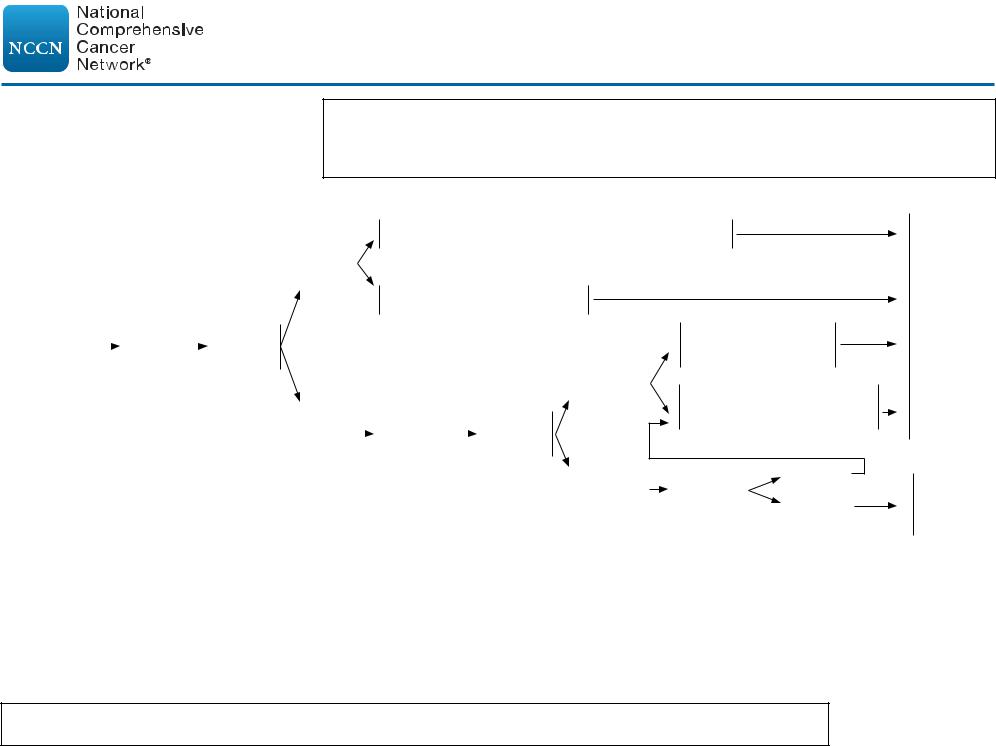
Printed by Ampleeva Olga on 3/26/2021 1:09:47 AM. For personal use only. Not approved for distribution. Copyright © 2021 National Comprehensive Cancer Network, Inc., All Rights Reserved.
NCCN Guidelines Version 3.2021
Hodgkin Lymphoma (Age ≥18 years)
NCCN Guidelines Index
Table of Contents
Discussion
CLINICAL PRESENTATION: Stage I/IIB Unfavorable CHLh,k (B-symptoms or bulky mediastinal disease or >10 cm adenopathy)
Important Considerations:
•Selection of treatment (combined modality therapy or chemotherapy alone) should be based upon patient age, sex, family history of cancer or cardiac disease, comorbid conditions, and sites of involvement (especially within mediastinum or axilla).
•In general, treatment with combined modality therapy provides for a better PFS/FFP, but no difference in overall survival.
•Most patients will benefit from multidisciplinary input prior to final treatment decisions.
PRIMARY TREATMENTk
Stage I/IIB |
|
|
|
|
|
|
|
|
|
|
|
|
|
|
|
Unfavorable |
|
|
|
|
|
|
|
CHLs |
|
|
|
|
|
|
Restage |
|
|
|
|
|
|
||
(B-symptoms |
|
|
ABVD x |
|
|
|
|
|
|
|
|
|
|||
|
|
|
|
|
with |
||
or bulky |
|
|
2 cyclesl |
|
|
|
|
|
|
|
|
||||
|
|
|
|
|
PET/CTm |
||
mediastinal |
|
|
|
|
|
|
|
|
|
|
|
|
|
|
|
disease |
|
|
|
|
|
|
|
or >10 cm |
|
|
|
|
|
|
|
adenopathy) |
|
|
|
|
|
|
|
ADDITIONAL THERAPY
Combined modality therapy
ABVD x 2 cyclesq + ISRT 30 Gyr (adapted: H10U)2
Deauville 1–3n
Chemotherapy alone
AVD x 4 cycles (per RATHL)6
Deauville 1–3n
Deauville |
|
|
|
Escalated |
|
|
|
|
|
Restage |
|
|
|
||||||||
|
BEACOPP |
|
|
|
|
|
with |
|||
4–5n,o,p |
|
|
|
|
|
|
||||
|
x 2 cycles |
|
|
|
|
|
PET/CTm |
|||
Deauville 4–5n,o,p
Chemotherapy alone Escalated BEACOPP x 2 cycles
Combined modality therapy ISRT 30 Gyr (adapted: HD11, HD14, H10U)2,7,8
Biopsyp |
Negative |
|
Positive |
||
|
See Follow-up (HODG-9)
See Refractory Disease (HODG-11)
h CHL includes NSHL, MCHL, LDHL, and LRHL subtypes. If |
o The degree of abnormality of a Deauville 4 score is quite variable and may influence further therapy. |
(eg, If only focally positive, it may be feasible to continue with 2 more cycles of ABVD and then |
|
grey-zone, see NCCN Guidelines for B-Cell Lymphomas. |
repeat the PET scan.) For a scan that remains positive throughout the area(s) of initial disease the |
k Individualized treatment may be necessary for older patients |
consensus is to escalate therapy (with consideration of biopsy, especially if an easily accessible site). |
and patients with concomitant disease. See Management of |
p A Deauville 5 score should prompt re-biopsy, especially if a readily accessible site, which would then |
Classic Hodgkin Lymphoma in Older Adults (HODG-E). |
inform subsequent therapy. If a biopsy is not performed, treatment should be escalated. |
l See Principles of Systemic Therapy (HODG-C). |
q Consider PFTs after 4 cycles of ABVD. |
m An integrated PET/CT or a PET with a diagnostic CT is |
r ISRT fields are generally smaller than IFRT fields. See Principles of Radiation Therapy (HODG-D). |
recommended. See Principles of FDG-PET/CT (HODG-A). |
s NCCN Unfavorable Factors include bulky mediastinal or >10 cm disease, B symptoms, ESR ≥50, |
n See PET 5-Point Scale (Deauville Criteria) (HODG-A, 2 of 2). |
and >3 sites of disease (see HODG-B). |
REFERENCES
Note: All recommendations are category 2A unless otherwise indicated.
Clinical Trials: NCCN believes that the best management of any patient with cancer is in a clinical trial. Participation in clinical trials is especially encouraged.
Version 3.2021, 03/12/21 © 2021 National Comprehensive Cancer Network® (NCCN®), All rights reserved. NCCN Guidelines® and this illustration may not be reproduced in any form without the express written permission of NCCN.
HODG-4
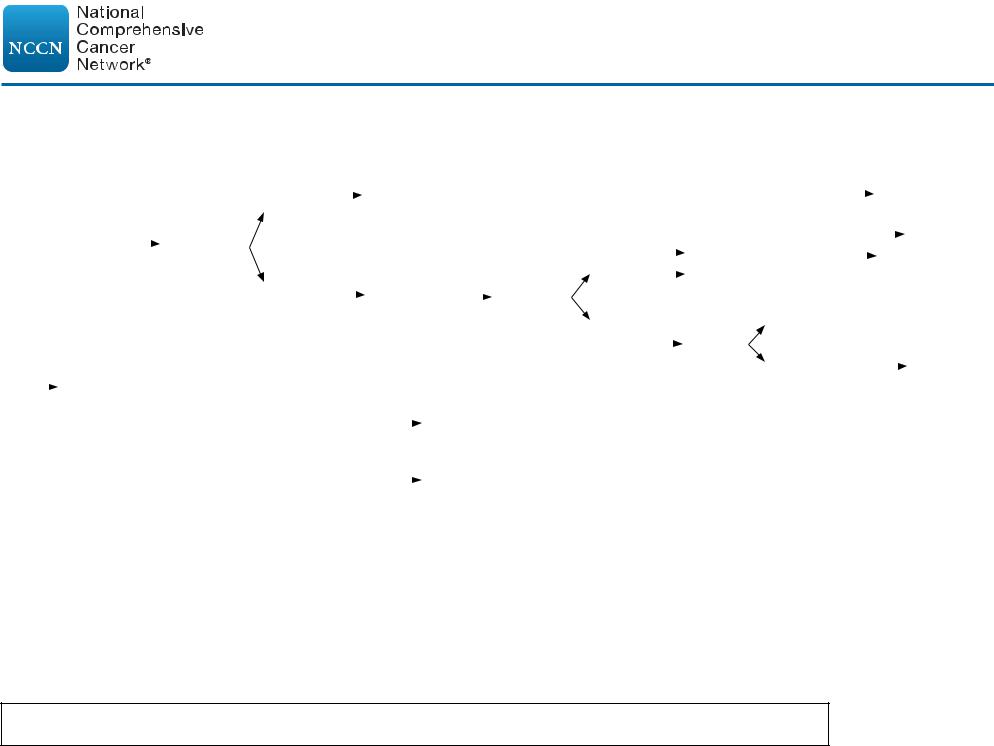
Printed by Ampleeva Olga on 3/26/2021 1:09:47 AM. For personal use only. Not approved for distribution. Copyright © 2021 National Comprehensive Cancer Network, Inc., All Rights Reserved.
NCCN Guidelines Version 3.2021
Hodgkin Lymphoma (Age ≥18 years)
NCCN Guidelines Index
Table of Contents
Discussion
CLINICAL PRESENTATION:
Stage III–IV CHLh,k
PRIMARY TREATMENTk |
|
|
|
|
|
|
|
|
|
|
|
|
|
|
|
|
|
|
|
|
|
|
|
|
|
|
|
||||||||||||
|
|
|
|
|
|
|
Deauville |
|
|
|
|
AVD x 4 cyclesy (per RATHL)6 |
|
|
|
|
|
|
|
|
|
|
|
|
|
|
|
|
|
||||||||||
|
|
|
|
|
|
|
|
|
|
|
|
|
|
|
|
|
|
|
|
|
|
|
|
|
|||||||||||||||
|
|
|
|
|
|
|
|
|
|
|
|
|
|
|
|
|
|
|
|
|
|
|
|
|
|
||||||||||||||
|
|
|
|
|
|
|
1–3n |
|
|
|
|
|
|
|
|
|
|
|
|
|
|
|
|
|
|
|
|
|
|
|
|
|
|
See |
|||||
|
|
|
ABVDl,t x |
|
|
Restage |
|
|
|
|
|
|
|
|
|
|
|
|
|
|
|
|
|
|
|
|
|
|
|
|
|
|
|
|
|
|
|
|
|
|
|
|
|
|
|
|
|
|
|
|
|
|
|
|
|
|
|
|
|
|
|
|
|
|
Escalated |
|
|
|
|
|
|
|
Follow-up |
||||||
|
|
|
2 cycles |
|
|
with |
|
|
|
|
|
|
|
|
|
|
|
|
|
|
Deauville |
|
|
|
|
|
|
(HODG-9) |
|||||||||||
|
|
|
|
|
|
|
|
|
|
|
|
|
|
|
|||||||||||||||||||||||||
|
|
|
(preferred) |
|
|
PET/CTm,x |
|
|
|
|
|
|
|
|
|
|
|
|
|
|
1–3n |
|
|
|
BEACOPP x 1 cycley |
|
|
|
|
|
|
|
|
||||||
|
|
|
|
|
|
|
|
|
|
|
|
|
|
|
|
|
|
|
|
|
|
|
|
|
|
|
|
|
|||||||||||
|
|
|
|
|
|
|
Deauville |
Escalated |
|
|
|
Restage |
|
|
|
|
|
|
|
|
(per RATHL)6 |
|
|
|
|
|
|
||||||||||||
|
|
|
|
|
|
|
BEACOPP |
|
|
|
|
|
|
|
|
|
|
|
|
|
|
|
|
|
|
|
|
||||||||||||
|
|
|
|
|
|
|
|
|
|
|
|
|
|
|
|
|
|
|
|
|
|||||||||||||||||||
|
|
|
|
|
|
|
4-5n,o,p |
|
|
x 3 cyclesl,u |
|
|
|
with |
|
|
|
|
|
|
|
|
|
|
|
|
|
|
|
|
|
||||||||
|
|
|
|
|
|
|
|
|
|
|
|
|
|
|
|
|
|
|
|
|
|
|
|
|
|||||||||||||||
|
|
|
|
|
|
|
|
|
|
|
|
|
|
|
|
|
|
|
|
|
|
|
|
||||||||||||||||
|
|
|
or |
|
|
|
|
|
|
|
|
|
(per RATHL)6 |
|
|
|
PET/CTm |
|
Deauville |
|
|
|
|
|
Negative |
|
|
|
|
|
|
||||||||
|
|
|
|
|
|
|
|
|
|
|
|
|
|
|
|
|
|
|
|
|
|
|
|
|
|
|
|
|
|||||||||||
|
|
|
|
|
|
|
|
|
|
|
|
|
|
|
|
|
|
|
|
|
|
|
|
|
|
|
Biopsyp |
|
|
|
See |
||||||||
|
|
|
|
|
|
|
|
|
|
|
|
|
|
|
|
|
|
|
|
|
|
|
|
|
|
|
|
|
|
||||||||||
|
|
|
|
|
|
|
|
|
|
|
|
|
|
|
|
|
|
|
|
|
|
|
|
|
|
|
|
|
|||||||||||
|
|
|
|
|
|
|
|
|
|
|
|
|
|
|
|
|
|
|
|
|
|
|
|
4–5n,o,p |
|
Positive |
|
|
|
|
|
|
|
|
Refractory |
||||
Stage |
|
|
|
|
|
|
|
|
|
|
|
|
|
|
|
|
|
|
|
|
|
|
|
|
|
|
|
|
|
|
|
|
|
Disease |
|||||
|
|
|
|
|
|
|
|
|
|
|
|
|
|
|
|
|
|
|
|
|
|
|
|
|
|
|
|
|
|
|
|
|
|||||||
|
|
|
|
|
|
|
|
|
|
|
|
|
|
|
|
|
|
|
|
|
|
|
|
|
|
|
|
|
|
|
|
|
|
|
|
||||
|
|
|
|
|
|
|
|
|
|
|
|
|
|
|
|
|
|
|
|
|
|
|
|
|
|
|
|
|
|
|
|
|
|
|
|
(HODG-11) |
|||
III–IV |
|
|
Useful in certain circumstances: |
|
|
|
|
|
|
|
|
|
|
|
|
|
|
|
|
|
|
|
|
|
|
|
|
|
|
||||||||||
|
|
|
|
|
|
|
|
|
|
|
|
|
|
|
|
|
|
|
|
|
|
|
|
|
|
|
|||||||||||||
|
|
|
Escalated BEACOPPl,u |
|
|
|
|
|
|
|
See HODG-6 |
|
|
|
|
|
|
|
|
|
|
|
|
|
|
|
|
||||||||||||
|
|
|
|
|
|
|
|
|
|
|
|
|
|
|
|
|
|
|
|
|
|
|
|
|
|||||||||||||||
|
|
|
(in select patients if IPS ≥4,v age <60) |
|
|
|
|
|
|
|
|
|
|
|
|
|
|
|
|
|
|
|
|
|
|
|
|
|
|
|
|||||||||
|
|
|
or |
|
|
|
|
|
|
|
|
|
|
|
|
|
|
|
|
|
|
|
|
|
|
|
|
|
|
|
|
|
|
|
|
|
|
|
|
|
|
|
Brentuximab vedotin + AVDl,w (category 2B) |
|
|
See HODG-7 |
|
|
|
|
|
|
|
|
|
|
|
|
|
|
|
|
|||||||||||||||||
|
|
|
|
|
|
|
|
|
|
|
|
|
|
|
|
|
|
|
|
||||||||||||||||||||
|
|
|
(category 2A in select patients; eg, no known |
|
|
|
|
|
|
|
|
|
|
|
|
|
|
|
|
|
|
|
|
||||||||||||||||
|
|
|
|
|
|
|
|
|
|
|
|
|
|
|
|
|
|
|
|
|
|
|
|||||||||||||||||
|
|
|
neuropathy, IPS ≥4v or bleomycin contraindicated) |
|
|
|
|
|
|
|
|
|
p A Deauville 5 score should prompt re-biopsy, especially if a |
||||||||||||||||||||||||||
h CHL includes NSHL, MCHL, LDHL, and LRHL subtypes. If grey-zone, see NCCN Guidelines for |
readily accessible site, which would then inform subsequent |
||||||||||||||||||||||||||||||||||||||
therapy. If a biopsy is not performed, treatment should be |
|||||||||||||||||||||||||||||||||||||||
B-Cell Lymphomas. |
|
|
|
|
|
|
|
|
|
|
|
|
|
|
|
|
|
|
|
|
escalated. |
|
|
|
|
|
|
|
|
|
|
|
|||||||
k Individualized treatment may be necessary for older patients and patients with concomitant disease. |
t ABVD is preferred based on the toxicity profile and quality of data. |
||||||||||||||||||||||||||||||||||||||
See Management of Classic Hodgkin Lymphoma in Older Adults (HODG-E). |
|
|
|
|
|
u Escalated BEACOPP is only an option for those aged <60 years. |
|||||||||||||||||||||||||||||||||
l See Principles of Systemic Therapy (HODG-C). |
|
|
|
|
|
|
|
|
|
|
|
v See International Prognostic Score (IPS) (HODG-B). |
|||||||||||||||||||||||||||
m An integrated PET/CT or a PET with a diagnostic CT is recommended. See Principles of FDG-PET/ |
w All cycles include growth factor support. See NCCN Guidelines |
||||||||||||||||||||||||||||||||||||||
CT (HODG-A). |
|
|
|
|
|
|
|
|
|
|
|
|
|
|
|
|
|
|
|
|
for Hematopoietic Growth Factors. |
|
|
|
|
||||||||||||||
n See PET 5-Point Scale (Deauville Criteria) (HODG-A, 2 of 2). |
|
|
|
|
|
|
|
|
|
|
|
x The value of interim PET imaging is unclear for many clinical |
|||||||||||||||||||||||||||
o The degree of abnormality of a Deauville 4 score is quite variable and may influence further therapy. |
scenarios. All measures of response should be considered in the |
||||||||||||||||||||||||||||||||||||||
(eg, If only focally positive, it may be feasible to continue with 2 more cycles of ABVD and then |
context of management decisions. |
|
|
|
|
||||||||||||||||||||||||||||||||||
repeat the PET scan.) For a scan that remains positive throughout the area(s) of initial disease the |
y Consider ISRT to initially bulky or PET-positive sites. See |
||||||||||||||||||||||||||||||||||||||
consensus is to escalate therapy (with consideration of biopsy, especially if an easily accessible site). |
Principles of Radiation Therapy (HODG-D). |
|
|
|
|
||||||||||||||||||||||||||||||||||
REFERENCES
Note: All recommendations are category 2A unless otherwise indicated.
Clinical Trials: NCCN believes that the best management of any patient with cancer is in a clinical trial. Participation in clinical trials is especially encouraged.
Version 3.2021, 03/12/21 © 2021 National Comprehensive Cancer Network® (NCCN®), All rights reserved. NCCN Guidelines® and this illustration may not be reproduced in any form without the express written permission of NCCN.
HODG-5

Printed by Ampleeva Olga on 3/26/2021 1:09:47 AM. For personal use only. Not approved for distribution. Copyright © 2021 National Comprehensive Cancer Network, Inc., All Rights Reserved.
NCCN Guidelines Version 3.2021
Hodgkin Lymphoma (Age ≥18 years)
NCCN Guidelines Index
Table of Contents
Discussion
CLINICAL PRESENTATION:
Stage III–IV CHLh
PRIMARY TREATMENTk (continued from HODG-5)
Deauville 1–3n
Escalated BEACOPP x 2 cyclesy (total 4) (per HD18)9 or
A(B)VD x 4 cyclesy,z (adapted: RATHL, AHL2011)6,10
Escalated |
|
|
|
|
|
|
|
|
|
|
|
|
|
|
|
|
|
|
|
|
|
|
|
|
|
|
|
|
|
|
|
|
|
|
|
|
|
|
|
|
|
||
BEACOPP x 2 |
|
|
|
|
Restage |
|
|
|
|
|
|
|
|
|
|
|
|
|
|
|
|
|
|
|
|
|
|
|
|
|
|
|
|
|
|
|
|
|
|
||||
cyclesl,v |
|
|
|
|
|
|
|
|
|
|
|
|
|
|
Deauville |
|
|
Escalated BEACOPP |
|||
|
|
|
|
|
|
|
|
|
|
|
|
|
|
|
|
||||||
|
|
|
|
with |
|
|
|
|
|
Escalated |
|
|
|
|
|
|
|||||
(in select |
|
|
|
|
|
|
|
|
|
|
|
1–3n |
|
|
x 2 cycles (total 6) |
||||||
|
|
|
|
|
|
|
|
|
|||||||||||||
patients if IPS |
|
|
|
|
PET/CTm |
|
|
|
|
|
BEACOPP |
|
Restage |
|
|
|
|
|
|
||
|
|
|
|
|
|
|
Negative |
|
|
x 2 cycles |
|
|
|
with |
|
|
|
|
|
|
|
≥4, age <60) |
|
|
|
|
|
|
|
|
|
|
|
|
|
|
|
|
|
|
|||
|
|
|
|
|
|
|
|
|
|
|
|
|
|||||||||
|
|
|
|
|
|
|
|
|
|
|
(total 4) (per |
|
PET/CTm |
|
|
|
|
|
|
||
|
|
|
|
|
|
|
|
|
|
|
|
|
|
|
|
Negative |
|||||
|
|
|
|
|
|
|
|
|
|
|
AHL2011)10 |
|
|
|
|
Deauville |
|
|
|
||
|
|
|
|
|
|
Deauville |
|
|
|
|
|
|
|
|
|
Biopsyp |
|||||
|
|
|
|
|
|
|
Biopsyp |
|
|
|
|
|
|
|
4–5n,p |
|
|
|
Positive |
||
|
|
|
|
|
|
|
|
|
|
|
|
|
|
|
|
|
|||||
|
|
|
|
|
|
4–5n,p |
|
|
|
|
|
|
|
|
|
|
|
|
|
||
Positive
See Follow-up (HODG-9)
See Refractory Disease  (HODG-11)
(HODG-11)
h CHL includes NSHL, MCHL, LDHL, and LRHL subtypes. If grey-zone, see |
|
NCCN Guidelines for B-Cell Lymphomas. |
p A Deauville 5 score may prompt re-biopsy, especially if a readily |
k Individualized treatment may be necessary for older patients and patients with |
|
concomitant disease. See Management of Classic Hodgkin Lymphoma in Older |
accessible site, which would then inform subsequent therapy. If |
Adults (HODG-E). |
a biopsy is not performed, treatment should be escalated. |
l See Principles of Systemic Therapy (HODG-C). |
v See International Prognostic Score (IPS) (HODG-B). |
m An integrated PET/CT or a PET with a diagnostic CT is recommended. See |
y Consider ISRT to initially bulky or PET-positive sites. See |
Principles of FDG-PET/CT (HODG-A). |
Principles of Radiation Therapy (HODG-D). |
n See PET 5-Point Scale (Deauville Criteria) (HODG-A, 2 of 2). |
z Bleomycin is optional. |
REFERENCES
Note: All recommendations are category 2A unless otherwise indicated.
Clinical Trials: NCCN believes that the best management of any patient with cancer is in a clinical trial. Participation in clinical trials is especially encouraged.
Version 3.2021, 03/12/21 © 2021 National Comprehensive Cancer Network® (NCCN®), All rights reserved. NCCN Guidelines® and this illustration may not be reproduced in any form without the express written permission of NCCN.
HODG-6
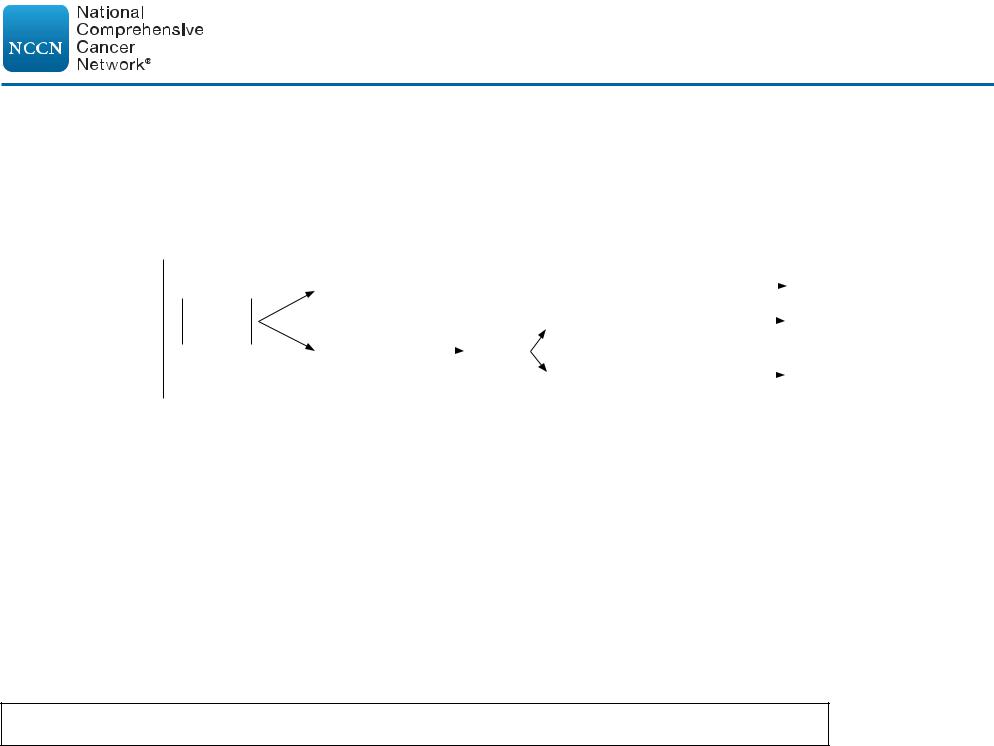
Printed by Ampleeva Olga on 3/26/2021 1:09:47 AM. For personal use only. Not approved for distribution. Copyright © 2021 National Comprehensive Cancer Network, Inc., All Rights Reserved.
NCCN Guidelines Version 3.2021
Hodgkin Lymphoma (Age ≥18 years)
NCCN Guidelines Index
Table of Contents
Discussion
CLINICAL PRESENTATION:
Stage III–IV CHLh
PRIMARY TREATMENTk (continued from HODG-5)
Brentuximab vedotin + AVD x 6 cyclesl,w,aa (per ECHELON-1)11 (category 2B) (category 2A in select patients; eg, no known neuropathy, IPS ≥4v or bleomycin contraindicated)
Restage  with PET/CTm
with PET/CTm
Deauville 1–3n,y |
|
|
|
|
|
|
See Follow-up (HODG-9) |
|
|
Negative |
|
|
|
||
|
|
|
|
|
|
||
Deauville 4–5n,p,y |
|
|
|
|
|
||
|
|
|
|||||
|
Biopsyp |
|
See Refractory |
||||
|
|
||||||
|
|
|
Positive |
|
|
|
|
|
|
|
|
|
|
Disease (HODG-11) |
|
|
|
|
|
|
|||
|
|
|
|
|
|
|
|
h CHL includes NSHL, MCHL, LDHL, and LRHL subtypes. If grey-zone, see NCCN Guidelines for B-Cell Lymphomas.
k Individualized treatment may be necessary for older patients and patients with concomitant disease. See Management of Classic Hodgkin Lymphoma in Older Adults (HODG-E).
l See Principles of Systemic Therapy (HODG-C).
m An integrated PET/CT or a PET with a diagnostic CT is recommended. See Principles of FDG-PET/CT (HODG-A).
p A Deauville 5 score may prompt re-biopsy, especially if a readily accessible site, which would then inform subsequent therapy. If a biopsy is not performed, treatment should be escalated.
n See PET 5-Point Scale (Deauville Criteria) (HODG-A, 2 of 2).
v See International Prognostic Score (IPS) (HODG-B).
w All cycles include growth factor support. See NCCN Guidelines for Hematopoietic Growth Factors.
y Consider ISRT to initially bulky or PET-positive sites. See Principles of Radiation Therapy (HODG-D).
aa If performing an interim PET/CT before completion of 6 cycles, and PET is positive (Deauville 5), conduct a biopsy; if biopsy positive, change therapy.
Note: All recommendations are category 2A unless otherwise indicated.
Clinical Trials: NCCN believes that the best management of any patient with cancer is in a clinical trial. Participation in clinical trials is especially encouraged.
REFERENCES
Version 3.2021, 03/12/21 © 2021 National Comprehensive Cancer Network® (NCCN®), All rights reserved. NCCN Guidelines® and this illustration may not be reproduced in any form without the express written permission of NCCN.
HODG-7

Printed by Ampleeva Olga on 3/26/2021 1:09:47 AM. For personal use only. Not approved for distribution. Copyright © 2021 National Comprehensive Cancer Network, Inc., All Rights Reserved.
NCCN Guidelines Version 3.2021
Hodgkin Lymphoma (Age ≥18 years)
NCCN Guidelines Index
Table of Contents
Discussion
CLASSIC HODGKIN LYMPHOMA
PRIMARY TREATMENT REFERENCES
1 CALGB 50604: Straus DJ, Jung SH, Pitcher B, et al. CALGB 50604: risk-adapted treatment of nonbulky early-stage Hodgkin lymphoma based on interim PET. Blood 2018;132(10):1013-1021.
2 EORTC/LYSA/FIL H10: André MPE, Girinsky T, Federico M, et al. Early positron emission tomography response-adapted treatment in stage I and II Hodgkin lymphoma: Final results of the randomized EORTC/LYSA/FIL H10 trial. J Clin Oncol 2017;35(16):1786-1794.
3 RAPID study: Radford J, Illidge T, Counsell N, et al. Results of a trial of PET-directed therapy for early-stage Hodgkin's lymphoma. N Engl J Med 2015;372(17):1598-
1607.
4 GHSG HD10: Engert A, Plütschow A, Eich HT, et al. Reduced treatment intensity in patients with early-stage Hodgkin's lymphoma. N Engl J Med 2010;363(7):640652.
5 GHSG H16: Fuchs M, Goergen H, Kobe C, et al. Positron emission tomography-guided treatment in early-stage favorable Hodgkin lymphoma: Final results of the international, randomized phase III HD16 trial by the German Hodgkin Study Group. J Clin Oncol 2019;37(31):2835-2845.
6 RATHL study: Johnson P, Federico M, Kirkwood A, et al. Adapted treatment guided by interim PET-CT scan in advanced Hodgkin's lymphoma. N Engl J Med
2016;374(25):2419-2429.
7 HD11: Eich HT, Diehl V, Görgen H, et al. Intensified chemotherapy and dose-reduced involved-field radiotherapy in patients with early unfavorable Hodgkin's lymphoma: final analysis of the German Hodgkin Study Group HD11 trial. J Clin Oncol 2010;28(27):4199-4206.
8 HD14: von Tresckow B, Plütschow A, Fuchs M, et al. Dose-intensification in early unfavorable Hodgkin's lymphoma: final analysis of the German Hodgkin Study Group HD14 trial. J Clin Oncol 2012;30(9):907-913.
9 GHSG HD18: Borchmann P, Goergen H, Kobe C, et al. PET-guided treatment in patients with advanced-stage Hodgkin's lymphoma (HD18): final results of an openlabel, international, randomised phase 3 trial by the German Hodgkin Study Group. Lancet 2018;390(10114):2790-2802.
10 AHL2011: Casasnovas RO, Bouabdallah R, Brice P, et al. PET-adapted treatment for newly diagnosed advanced Hodgkin lymphoma (AHL2011): a randomised, multicentre, non-inferiority, phase 3 study. Lancet Oncol 2019;20:202-215.
11 ECHELON-1: Connors JM, Jurczak W, Straus DJ, et al. Brentuximab vedotin with chemotherapy for stage III or IV Hodgkin's lymphoma [published correction appears in N Engl J Med 2018 Mar 1;378(9):878] N Engl J Med 2018;378(4):331-344.
Note: All recommendations are category 2A unless otherwise indicated.
Clinical Trials: NCCN believes that the best management of any patient with cancer is in a clinical trial. Participation in clinical trials is especially encouraged.
Version 3.2021, 03/12/21 © 2021 National Comprehensive Cancer Network® (NCCN®), All rights reserved. NCCN Guidelines® and this illustration may not be reproduced in any form without the express written permission of NCCN.
HODG-7A
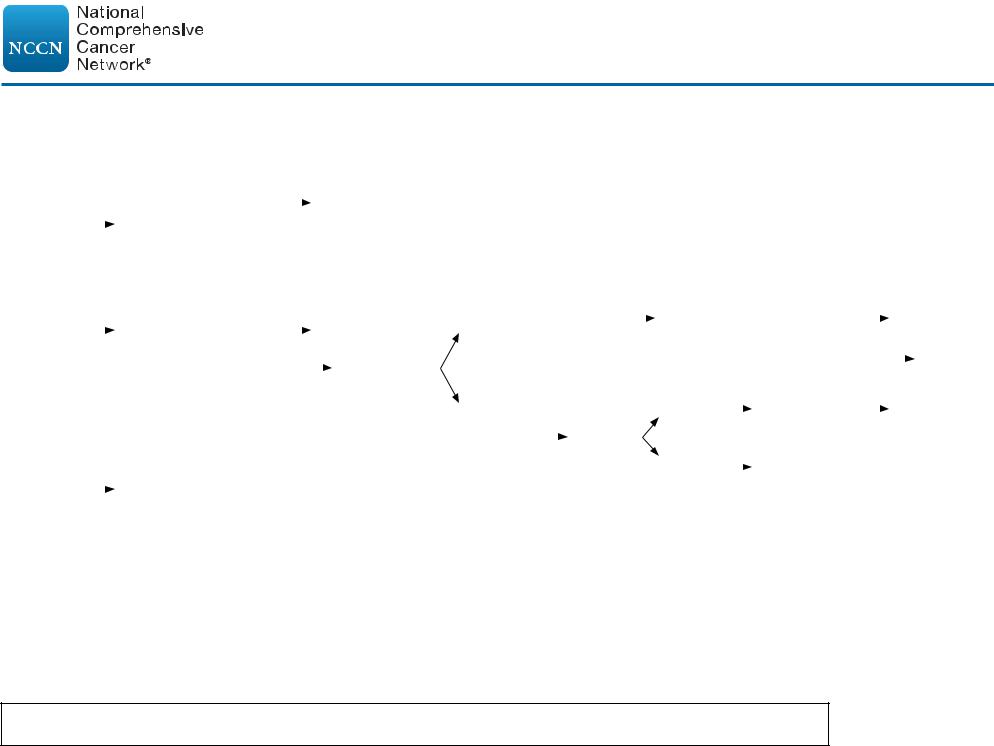
Printed by Ampleeva Olga on 3/26/2021 1:09:47 AM. For personal use only. Not approved for distribution. Copyright © 2021 National Comprehensive Cancer Network, Inc., All Rights Reserved.
NCCN Guidelines Version 3.2021
Hodgkin Lymphoma (Age ≥18 years)
NCCN Guidelines Index
Table of Contents
Discussion
CLINICAL PRESENTATION:
Nodular Lymphocyte-Predominant
Hodgkin Lymphomabb
PRIMARY TREATMENT
|
|
|
|
|
|
|
|
ISRTdd (preferred |
|
|
|
|
|
|
|
|
|
|
|
|
|
|
|
|
|
|
|
|
|
|
|
|
|
|
|
|||
|
|
|
|
|
|
|
|
|
|
|
|
|
|
|
|
|
|
|
|
|
|
|
|
|
|
|
|
|
|
|
|
|
|
|
||||
CS IA, IIA |
|
|
|
|
|
|
for stage IA or |
|
|
|
|
|
|
|
|
|
|
|
|
|
|
|
|
|
|
|
|
|
|
|
|
|
|
|
|
|
|
|
|
|
|
|
|
|
|
|
|
|
|
|
|
|
|
|
|
|
|
|
|
|
|
|
|
|
|
|
|
|
|
|
|
|
|
|
|||
|
|
|
|
|
contiguous stage IIA) |
|
|
|
|
|
|
|
|
|
|
|
|
|
|
|
|
|
|
|
|
|
|
|
|
|
|
|
||||||
(Non-bulky) |
|
|
|
|
|
or |
|
|
|
|
|
|
|
|
|
|
|
|
|
|
|
|
|
|
|
|
|
|
|
|
|
|
|
|
|
|
||
|
|
|
|
|
|
|
|
|
|
|
|
|
|
|
|
|
|
|
|
|
|
|
|
|
|
|
|
|
|
|||||||||
|
|
|
|
|
|
|
|
|
|
|
|
|
|
|
|
|
|
|
|
|
|
|
|
|
|
|
|
|
|
|
|
|
|
|
|
|
|
|
CS IB,cc IIB |
|
|
|
|
Observeee |
|
|
|
|
|
|
|
|
|
|
|
|
|
|
|
|
|
|
|
|
Observe, if asymptomatic |
|
|
|
|
|
|
||||||
|
|
|
|
|
|
|
|
|
|
|
|
|
|
|
|
|
|
|
|
|
|
|
|
|
|
|
|
|
|
|||||||||
|
|
|
|
|
|
|
|
|
|
|
|
|
|
|
|
|
|
|
|
|
|
|
|
|
|
|
|
|
|
|
||||||||
|
|
|
|
|
|
|
|
|
|
|
|
|
|
|
|
|
|
|
|
|
|
|
|
|
|
|
|
|
|
|
||||||||
or |
|
|
|
|
Chemotherapy |
ff,gg |
|
|
|
|
|
|
|
|
|
|
Response |
|
|
|
|
|
|
|
|
|
|
|
|
|
|
|||||||
CS IA (Bulky)/ |
|
|
|
|
|
|
|
|
|
|
|
|
|
|
|
|
|
|
|
|
|
|
|
or |
|
|
|
|
|
|
|
|
||||||
|
|
|
|
|
|
|
|
|
|
|
|
|
|
|
|
|
|
|
|
|
|
|
|
|
|
|
||||||||||||
CS IIA (Bulky |
|
|
|
|
+ Rituximab |
|
|
|
|
|
|
|
|
|
|
|
|
|
|
|
|
|
|
|
|
ISRTdd (if no prior RT) |
|
|
|
|
|
See |
||||||
|
|
|
|
|
|
|
|
|
|
|
|
|
|
|
|
|
|
|
|
|
|
|
|
|
|
|
|
|
||||||||||
|
|
|
|
|
|
|
|
|
|
|
|
|
|
|
|
|
|
|
|
|
|
|
|
|
|
|
|
|
||||||||||
|
|
|
|
+ ISRThh |
|
|
|
|
|
|
|
|
|
|
|
|
|
|
|
|
|
|
|
|
|
|
|
|
|
|
|
|
|
|||||
or non- |
|
|
|
|
|
|
|
|
|
|
|
|
Re-evaluation |
|
|
|
|
|
|
|
|
|
|
|
|
|
|
|
|
|
|
Follow-up |
||||||
|
|
|
|
|
|
|
|
|
|
|
|
|
|
|
|
|
|
|
|
|
|
|
|
|||||||||||||||
|
|
|
|
|
|
|
|
|
|
|
|
|
|
|
|
|
|
|
|
|
|
|
||||||||||||||||
contiguouscc) |
|
|
|
|
Based on clinical |
|
with PET/CT |
|
|
|
|
|
|
|
|
|
|
|
|
Observe, if |
|
|
|
|
(HODG-9) |
|||||||||||||
|
|
|
|
|
|
|
|
|
|
|
|
|
||||||||||||||||||||||||||
|
|
|
|
|
|
|
|
|
||||||||||||||||||||||||||||||
|
|
|
|
|
|
|
|
|
|
|
|
|
|
|
|
|
|
|
|
|
|
|
|
|
|
|
|
|
|
|||||||||
|
|
|
|
|
|
|
|
|
|
|
|
|
|
|
|
|
|
|
|
|
|
|
|
|
|
|
|
|
|
|||||||||
|
|
|
|
|
|
|
|
judgment, options include: |
|
|
|
|
|
|
|
|
|
|
|
|
|
|
Negative |
|
|
|
|
|
|
|||||||||
|
|
|
|
|
|
|
|
|
|
|
|
|
|
|
|
|
|
|
|
|
|
|
|
|
|
|
||||||||||||
|
|
|
|
|
|
|
|
Chemotherapyff + |
|
|
|
|
|
Stable or |
|
|
Biopsyii |
|
|
|
|
|
asymptomatic |
|
|
|
||||||||||||
|
|
|
|
|
|
|
|
|
|
|
|
|
|
|
||||||||||||||||||||||||
|
|
|
|
|
|
|
|
Rituximab ± ISRTdd |
|
|
|
|
|
progressive |
|
|
|
|
|
|
|
|
|
|
|
|
|
|
|
|
||||||||
|
|
|
|
|
|
|
|
|
|
|
|
|
|
|
|
|
|
|
|
|
|
|||||||||||||||||
|
|
|
|
|
|
|
|
or |
|
|
|
|
|
|
|
|
|
|
|
disease |
|
|
|
|
|
Positive |
|
|
See Refractory Disease or |
|||||||||
|
|
|
|
|
|
|
|
|
|
|
|
|
|
|
|
|
|
|
|
|
|
|
|
|||||||||||||||
|
|
|
|
|
|
|
|
Rituximab |
|
|
|
|
|
|
|
|
|
|
|
|
|
|
|
|
|
|
|
|
|
|
Suspected Relapse (HODG-13) |
|||||||
|
|
|
|
|
|
|
|
|
|
|
|
|
|
|
|
|
|
|
|
|
|
|
|
|
|
|
|
|
|
|||||||||
CS III–IV |
|
|
|
|
or |
|
|
|
|
|
|
|
|
|
|
|
|
|
|
|
|
|
|
|
|
|
|
|
|
|
|
|
|
|
|
|||
|
|
|
|
|
|
|
|
|
|
|
|
|
|
|
|
|
|
|
|
|
|
|
|
|
|
|
|
|
|
|
|
|||||||
|
|
|
|
|
|
|
|
Local RT (palliation of |
|
|
|
|
|
|
|
|
|
|
|
|
|
|
|
|
|
|
|
|
|
|
|
|
||||||
|
|
|
|
|
|
|
|
locally symptomatic |
|
|
|
|
|
|
|
|
|
|
|
|
|
|
|
|
|
|
|
|
|
|
|
|
||||||
|
|
|
|
|
|
|
|
disease)hh |
|
|
|
|
|
|
|
|
|
|
|
|
|
|
|
|
|
|
dd ISRT fields are generally smaller than IFRT fields. See |
|||||||||||
|
|
|
|
|
|
|
|
or |
|
|
|
|
|
|
|
|
|
|
|
|
|
|
|
|
|
|
Principles of Radiation Therapy (HODG-D). |
|
|
|
||||||||
|
|
|
|
|
|
|
|
Observe, if asymptomatic |
|
|
|
|
|
|
|
|
|
|
|
|
ee Observation may be an option for stage IA patients with |
|||||||||||||||||
|
|
|
|
|
|
|
|
|
|
|
|
|
|
|
|
|
|
|
|
|||||||||||||||||||
bb NLPHL has a different natural history and response to therapy than CHL, especially stages I–II. |
a completely excised solitary lymph node. See Follow-up |
|||||||||||||||||||||||||||||||||||||
(HODG-9). |
|
|
|
|
|
|
|
|
||||||||||||||||||||||||||||||
For that reason, separate guidelines are presented for NLPHL. Patients who present with bulky |
|
ff See Principles of Systemic Therapy (HODG-C 2 of 4). |
||||||||||||||||||||||||||||||||||||
disease, subdiaphragmatic disease, or splenic involvement have a high risk for initial or later |
|
gg Generally a brief course of chemotherapy (3–4 months) |
||||||||||||||||||||||||||||||||||||
transformation to large cell lymphoma. Data suggest outcomes differ for typical immunoarchitectural |
would be given with radiation therapy. |
|
|
|
||||||||||||||||||||||||||||||||||
patterns (A/B) versus variant patterns (C/D/E/F). (Swerdlow SH, Campo E, Harris NL, et al; WHO |
hh See Principles of Radiation Therapy (HODG-D). |
|||||||||||||||||||||||||||||||||||||
classification of tumours of haematopoietic and lymphoid tissues. Lyon, France: IARC; 2017). |
|
ii Recommend biopsy for sites of progressive disease, |
||||||||||||||||||||||||||||||||||||
cc For select patients with CS IB, or CS IIA non-contiguous disease, ISRT alone may be an option. |
especially subdiaphragmatic sites, to rule out transformation. |
|||||||||||||||||||||||||||||||||||||
Note: All recommendations are category 2A unless otherwise indicated.
Clinical Trials: NCCN believes that the best management of any patient with cancer is in a clinical trial. Participation in clinical trials is especially encouraged.
Version 3.2021, 03/12/21 © 2021 National Comprehensive Cancer Network® (NCCN®), All rights reserved. NCCN Guidelines® and this illustration may not be reproduced in any form without the express written permission of NCCN.
HODG-8

Printed by Ampleeva Olga on 3/26/2021 1:09:47 AM. For personal use only. Not approved for distribution. Copyright © 2021 National Comprehensive Cancer Network, Inc., All Rights Reserved.
NCCN Guidelines Version 3.2021
Hodgkin Lymphoma (Age ≥18 years)
NCCN Guidelines Index
Table of Contents
Discussion
FOLLOW-UP AFTER COMPLETION OF TREATMENT AND MONITORING FOR LATE EFFECTS
•Complete response should be documented including reversion of PET to "negative" within 3 months following completion of therapy.
•It is recommended that the patient be provided with a treatment summary at the completion of his/her therapy, including details of radiation therapy (RT), organs at risk (OARs), and cumulative anthracycline dosage given.
•Follow-up with an oncologist is recommended and should be coordinated with the primary care physician (PCP), especially during the first 5 years after treatment to detect recurrence, and then annually due to the risk of late complications including second cancers and cardiovascular disease (see NCCN Guidelines for Survivorship).jj,kk Late relapse or transformation to large cell lymphoma may occur in NLPHL.
•The frequency and types of tests may vary depending on clinical circumstances: age and stage at diagnosis, social habits, treatment modality, etc. There are few data to support specific recommendations; these represent the range of practice at NCCN Member Institutions.
Follow-up After Completion of Treatment Up to 5 Years
•Interim H&P: Every 3–6 mo for 1–2 y, then every 6–12 mo until year 3, then annually
•Annual influenza vaccine and other vaccines as clinically indicated (see NCCN Guidelines for Survivorship)
•Laboratory studies:ll
CBC, platelets, ESR (if elevated at time of initial diagnosis), chemistry profile as clinically indicated.
Thyroid-stimulating hormone (TSH) at least annually if RT to neck.
•Neck/chest/abdomen/pelvis CT scan with contrast no more often than every 6 months for the first 2 y following completion of therapy, or as clinically indicated. PET/CT only if last PET was Deauville 4–5, to confirm complete response.
•Counseling: Reproduction, health habits, psychosocial, cardiovascular, breast self-exam, skin cancer risk, end-of-treatment discussion.
•Surveillance PET should not be done routinely due to risk for false positives. Management decisions should not be based on PET scan alone; clinical or pathologic correlation is needed.
jjMauch P, Ng A, Aleman B, et al. Report from the Rockefeller Foundation-Sponsored International Workshop on reducing mortality and improving quality of life in long-term survivors of Hodgkin's disease: July 9-16, 2003, Bellagio, Italy. Eur J Haematol Suppl 2005;(66):68-76. kkAppropriate medical management should be instituted for any abnormalities.
llLynch RC, Sundaram V, Desai M, et al. Utility of routine surveillance laboratory testing in detecting relapse in patients with classic Hodgkin lymphoma in first remission: Results from a large single-institution study. JCO Oncol Pract 2020;16:e902-e911.
Suspected Relapse CHL (HODG-12) or NLPHL (HODG-13)
Follow-Up and Monitoring After 5 Years (HODG-10)
Note: All recommendations are category 2A unless otherwise indicated.
Clinical Trials: NCCN believes that the best management of any patient with cancer is in a clinical trial. Participation in clinical trials is especially encouraged.
Version 3.2021, 03/12/21 © 2021 National Comprehensive Cancer Network® (NCCN®), All rights reserved. NCCN Guidelines® and this illustration may not be reproduced in any form without the express written permission of NCCN.
HODG-9

Printed by Ampleeva Olga on 3/26/2021 1:09:47 AM. For personal use only. Not approved for distribution. Copyright © 2021 National Comprehensive Cancer Network, Inc., All Rights Reserved.
NCCN Guidelines Version 3.2021
Hodgkin Lymphoma (Age ≥18 years)
NCCN Guidelines Index
Table of Contents
Discussion
FOLLOW-UP AFTER COMPLETION OF TREATMENT AND MONITORING FOR LATE EFFECTS
Follow-up and Monitoring After 5 Yearsjj,kk
• Interim H&P: Annually
Annual blood pressure, aggressive management of cardiovascular risk factors.
Pneumococcal, meningococcal, and Haemophilus influenzae type b revaccination after 5–7 y, if patient treated with splenic RT or previous splenectomy (according to CDC recommendations).
Annual influenza vaccine and other vaccines as clinically indicated (see NCCN Guidelines for Survivorship).
• Cardiovascular symptoms may emerge at a young age.
Consider stress test/ECHO at 10-y intervals after treatment is completed.Consider carotid ultrasound at 10-y intervals if neck irradiation.
• Laboratory studies:
CBC, platelets, chemistry profile annually
TSH at least annually if RT to neckBiannual lipids
Annual fasting glucose
•Annual breast screening: Initiate 8–10 y post-therapy, or at age 40, whichever comes first, if chest or axillary radiation. The NCCN Hodgkin
Lymphoma Guidelines Panel recommends breast MRI in addition to mammography for women who received irradiation to the chest between ages 10–30 y, which is consistent with the American Cancer Society (ACS) Guidelines. Consider referral to a breast specialist.
•Perform other routine surveillance tests for cervical, colorectal, endometrial, lung, and prostate cancer as per the NCCN Guidelines for Detection, Prevention, and Risk Reduction and the ACS Cancer Screening Guidelines.
•Counseling: Reproduction, health habits, psychosocial, cardiovascular, breast self-exam, and skin cancer risk.
•Treatment summary and consideration of transfer to PCP.
•Consider a referral to a survivorship clinic.
jjMauch P, Ng A, Aleman B, et al. Report from the Rockefeller Foundation-Sponsored International Workshop on reducing mortality and improving quality of life in longterm survivors of Hodgkin's disease: July 9-16, 2003, Bellagio, Italy. Eur J Haematol Suppl 2005;(66):68-76.
kkAppropriate medical management should be instituted for any abnormalities.
Note: All recommendations are category 2A unless otherwise indicated.
Clinical Trials: NCCN believes that the best management of any patient with cancer is in a clinical trial. Participation in clinical trials is especially encouraged.
Version 3.2021, 03/12/21 © 2021 National Comprehensive Cancer Network® (NCCN®), All rights reserved. NCCN Guidelines® and this illustration may not be reproduced in any form without the express written permission of NCCN.
HODG-10

Printed by Ampleeva Olga on 3/26/2021 1:09:47 AM. For personal use only. Not approved for distribution. Copyright © 2021 National Comprehensive Cancer Network, Inc., All Rights Reserved.
NCCN Guidelines Version 3.2021
Hodgkin Lymphoma (Age ≥18 years)
NCCN Guidelines Index
Table of Contents
Discussion
REFRACTORY |
SECOND-LINE |
|
ADDITIONAL THERAPY |
||||
CHL |
THERAPYmm |
|
(Refractory/Relapsed Disease) |
||||
|
|
|
|
High-dose therapy and |
|
|
|
|
|
|
|
|
|||
|
|
|
|
autologous stem cell |
|
|
|
|
Deauville |
|
|
rescue (HDT/ASCRnn |
|
|
|
|
1–3n |
|
|
± RToo,pp) (category 1) |
|
|
|
|
|
||||||
|
|
|
|
or |
|
|
|
|
|
|
|
Observe ± RToo,pp (if HDT/ |
|||
|
|
|
|
ASCR contraindicated) |
|||
MAINTENANCE THERAPY
Observe or
Brentuximab vedotin for 1 y for patients with high riskrr of relapsess
|
|
|
|
|
|
|
|
|
|
|
|
|
|
|
|
HDT/ASCRnn ± RToo,pp |
|
|
|
|
|
Brentuximab vedotin |
|
|
|
||||
|
|
|
|
|
|
|
|
|
|
|
|
|
|
|
|
|
|
|
|
|
|
||||||||
|
|
|
|
|
|
|
|
|
|
|
|
|
|
|
|
|
|
|
|
|
for 1 y for patients with |
|
|
|
|
|
|||
|
|
|
|
|
|
|
|
|
|
|
|
|
|
|
|
||||||||||||||
|
|
|
|
|
|
|
|
|
|
|
|
|
|
|
|
|
|
|
|
|
|
|
|||||||
Biopsy- |
|
|
|
|
|
|
|
|
|
|
|
|
|
|
|
or |
|
|
|
|
|
high riskrr of relapsess |
|
|
|
||||
|
|
|
|
|
Second-line |
|
|
|
Restage |
|
|
|
|
|
|
|
|
|
|
|
|
|
|
|
|
|
|||
|
|
|
|
|
|
|
|
|
|
|
|
|
|
|
|
|
|
|
|
|
|||||||||
proven |
|
|
|
|
|
|
|
|
|
|
Deauville 4n |
|
|
RTpp |
|
|
|
|
|
|
|
|
|
|
|
|
|
||
|
|
|
|
|
systemic |
|
|
|
with |
|
|
|
|
|
|
|
|
|
|
|
|
|
|
|
|
|
|||
refractory |
|
|
|
|
|
|
|
|
|
|
|
|
|
|
|
|
|
|
|
|
|
|
|
|
|
||||
|
|
|
|
|
|
|
|
|
|
|
|
|
|
|
|
|
|
|
|
|
|
|
|||||||
|
|
|
|
|
therapymm |
|
|
|
PET/CTm |
|
|
|
|
|
|
|
|
|
|
|
|
|
|
|
|
|
|
|
|
disease |
|
|
|
|
|
|
|
|
|
|
|
|
|
or |
|
|
|
|
|
|
|
|
|
|
|
|
|||
|
|
|
|
|
|
|
|
|
|
|
|
|
|
|
|
|
|
|
|
|
|
|
|
|
|
|
|||
|
|
|
|
|
|
|
|
|
|
|
|
|
|
|
|
|
|
|
|
|
|
|
|
||||||
|
|
|
|
|
|
|
|
|
|
|
|
|
|
|
|
Subsequent systemic therapymm,qq ± RToo,pp |
|
|
|
|
|
|
|||||||
|
|
|
|
|
|
|
|
|
|
|
|
|
|
|
|
|
|
|
|
|
|
||||||||
|
|
|
|
|
|
|
|
|
|
|
|
|
|
|
|
RTpp |
|
|
|
|
If response, |
|
|
||||||
|
|
|
|
|
|
|
|
|
|
|
|
|
|
|
|
|
|
|
|
|
|
||||||||
|
|
|
|
|
|
|
|
|
|
|
|
|
|
|
|
|
|
|
|
|
|
||||||||
|
|
|
|
|
|
|
|
|
|
|
|
|
Deauville 5n |
|
|
or |
|
|
|
|
|
||||||||
|
|
|
|
|
|
|
|
|
|
|
|
|
|
|
|
|
|
|
consider transplant |
|
|
||||||||
|
|
|
|
|
|
|
|
|
|
|
|
|
|
|
Subsequent systemic |
|
|
|
|
|
|
||||||||
|
|
|
|
|
|
|
|
|
|
|
|
|
|
|
|||||||||||||||
|
|
|
|
|
|
|
|
|
|
|
|
|
|
|
|
|
|
|
|
(autologous or allogeneic) |
|
|
|||||||
|
|
|
|
|
|
|
|
|
|
|
|
|
|
|
|
therapymm,qq ± RToo,pp |
|
|
|
|
|
||||||||
|
|
|
|
|
|
|
|
|
|
|
|
|
|
|
|
|
|
|
|
|
|
|
|
|
|
|
|
||
See Follow-up (HODG-9)
m An integrated PET/CT or a PET with a diagnostic CT is recommended. See Principles of FDG-PET/CT (HODG-A).
n See PET 5-Point Scale (Deauville Criteria) (HODG-A, 2 of 2). mm See Principles of Systemic Therapy for Relapsed or Refractory
Disease (HODG-C 3 of 4).
nn Strongly consider radiation therapy for selected sites that have not been previously irradiated. In a radiation-naive patient, TLI may be an appropriate component of HDT.
oo Conventional-dose chemotherapy may precede high-dose therapy. Timing of RT may vary.
ppSee Principles of Radiation Therapy (HODG-D).
qqSubsequent systemic therapy options include second-line therapy options that were not previously used. (See HODG-C, 3 of 4).
rrPatients with 2 or more of the following risk factors are considered high risk: Remission duration less than 1 year, extranodal involvement, PET+ response at time of transplant, B symptoms, and/or >1 salvage/subsequent therapy regimen.
ssThe role of maintenance brentuximab vedotin has not been well-defined in patients who received brentuximab vedotin prior to maintenance therapy.
Note: All recommendations are category 2A unless otherwise indicated.
Clinical Trials: NCCN believes that the best management of any patient with cancer is in a clinical trial. Participation in clinical trials is especially encouraged.
Version 3.2021, 03/12/21 © 2021 National Comprehensive Cancer Network® (NCCN®), All rights reserved. NCCN Guidelines® and this illustration may not be reproduced in any form without the express written permission of NCCN.
HODG-11
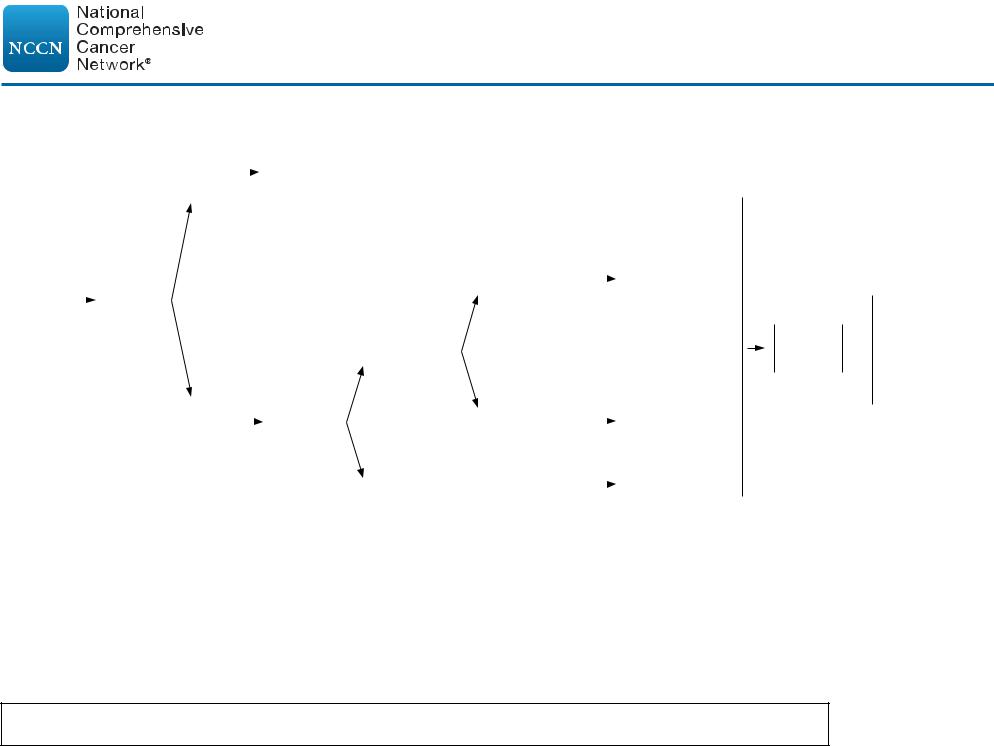
Printed by Ampleeva Olga on 3/26/2021 1:09:47 AM. For personal use only. Not approved for distribution. Copyright © 2021 National Comprehensive Cancer Network, Inc., All Rights Reserved.
NCCN Guidelines Version 3.2021
Hodgkin Lymphoma (Age ≥18 years)
NCCN Guidelines Index
Table of Contents
Discussion
CHL
SUSPECTED RELAPSE
Negative |
|
Observe with short-interval |
|
follow-up (See HODG-9) |
|
|
|
Repeat |
|
|
|
|
|
|
|
|
|
|
|
|
|
|
|
PET/CT or |
|
Rebiopsy |
|
|
|
||
diagnostic |
|
|
|
Initial stage |
|||
|
|
|
|
|
|
||
CT |
|
|
|
|
|
|
IA–IIA (no |
|
|
|
|
|
|
||
|
|
|
|
|
|
|
prior RT |
|
|
|
|
|
|
|
with failure |
|
|
|
|
|
|
|
in initial |
|
|
|
|
|
Restaging |
|
sites) |
|
|
|
|
|
|
||
|
|
Positive |
|
|
(same |
|
|
|
|
|
|
as initial |
|
|
|
|
|
|
|
|
workup) |
|
|
|
|
|
|
|
|
|
All others |
SECOND-LINE THERAPYuu
|
|
|
|
|
|
|
|
Second-line |
|
|
|
|
|
|
|
|
|
|
|
|
|
Patients who |
|
|
|
systemic |
|
|
|
|
|
|
|
therapymm + RT |
|
|
|
|
|
received |
|
|
|
|
|
|
|
|
|
|
|
or |
|
|
|
|
|
abbreviated |
|
|
|
|
|
|
|
|
|
|
|
Second-line |
|
|
|
|
|
chemotherapy |
|
|
|
|
|
|
|
|
|
|
|
systemic |
|
|
|
|
|
(3–4 cycles) |
|
|
|
|
|
|
|
|
|
|
|
therapymm |
|
|
|
|
|
without RT |
|
|
|
|
|
|
|
|
|
|
|
followed by |
|
|
|
|
|
|
||||
|
|
|
|
|
|
|
|
|
|
|
|
|
|
|
|
|
HDT/ASCRnn,tt |
|
|
|
|
Patients who |
|
|
|
± ISRTr,oo |
|
|
|
|
|
|
|
||
|
|
|
|
|
|
|
Second-line |
|
|
|
|
|
|
|
|
||
|
|
|
|
|||||
|
|
|
|
received |
|
|
|
|
|
|
|
|
full-course |
|
|
|
systemic |
|
|
|
||||||
|
|
|
|
chemotherapy |
|
|
|
therapymm,vv |
|
|
|
|
|
|
|
|
followed by |
|
|
|
|
|
|
|
|
HDT/ASCRnn,tt |
|
|
|
|
|
|
|
|
± ISRTr,oo |
|
|
|
|
|
|
|
Restage with PET/CTm
Subsequent therapyqq (See additional  therapy options for refractory/ relapsed disease on HODG-11)
therapy options for refractory/ relapsed disease on HODG-11)
m An integrated PET/CT or a PET with a diagnostic CT is recommended. See Principles of FDG-PET/CT (HODG-A).
r ISRT fields are generally smaller than IFRT fields. See Principles of Radiation Therapy (HODG-D).
mmSee Principles of Systemic Therapy for Relapsed or Refractory Disease (HODG-C 3 of 4).
nnStrongly consider radiation therapy for selected sites that have not been previously irradiated.
ooConventional-dose chemotherapy may precede high-dose therapy. Timing of RT may vary.
qq Subsequent therapy options include second-line therapy options that were not previously used. (See HODG-C, 3 of 4).
ttAllotransplant is an option in select patients as a category 3 recommendation.
uuThere are no data to support a superior outcome with any of the treatment modalities. Individualized treatment is recommended.
vvFor select patients with long disease-free interval and other favorable features, selection of chemotherapy should be individualized.
Note: All recommendations are category 2A unless otherwise indicated.
Clinical Trials: NCCN believes that the best management of any patient with cancer is in a clinical trial. Participation in clinical trials is especially encouraged.
Version 3.2021, 03/12/21 © 2021 National Comprehensive Cancer Network® (NCCN®), All rights reserved. NCCN Guidelines® and this illustration may not be reproduced in any form without the express written permission of NCCN.
HODG-12
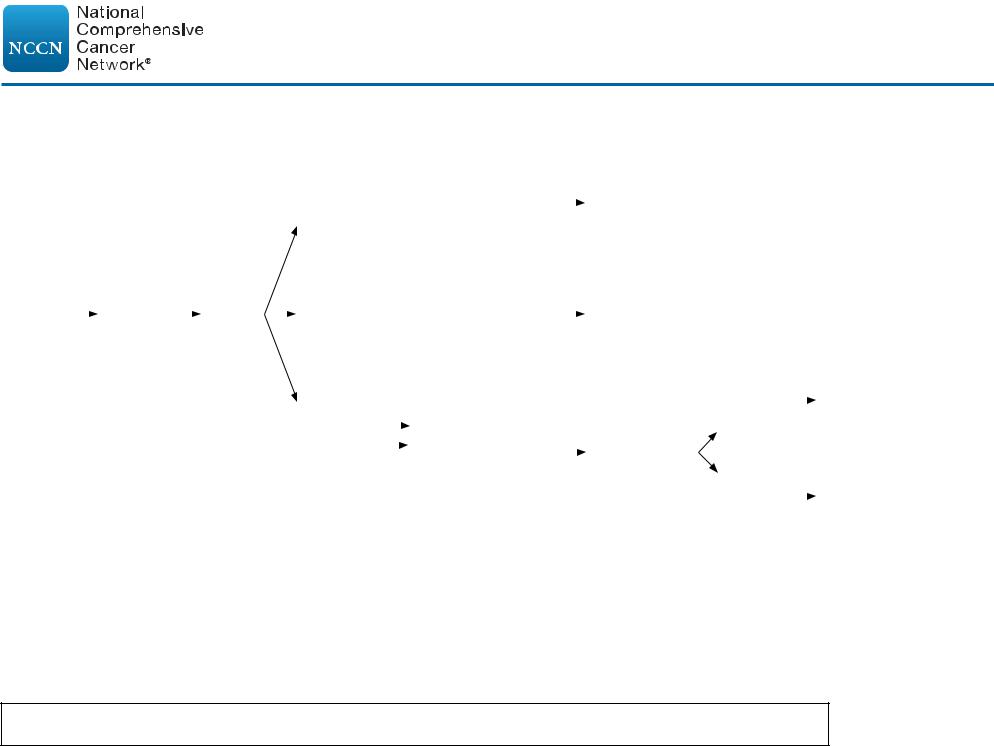
Printed by Ampleeva Olga on 3/26/2021 1:09:47 AM. For personal use only. Not approved for distribution. Copyright © 2021 National Comprehensive Cancer Network, Inc., All Rights Reserved.
NCCN Guidelines Version 3.2021
Hodgkin Lymphoma (Age ≥18 years)
NCCN Guidelines Index
Table of Contents
Discussion
NLPHL |
|
|
|
|
REFRACTORY OR SUSPECTED RELAPSE |
SECOND-LINE THERAPYuu |
|||
|
||||
Aggressive B-cell lymphoma |
|
|
See NCCN Guidelines for B-Cell Lymphomas for |
|
|
|
|||
|
|
relapsed disease (Diffuse large B-cell lymphoma) |
||
|
||||
|
|
|
|
|
Refractory |
|
|
Repeat |
|
|
|
|
|
|
|
|
|
|
|
|
|
|
|
|
|
|
|
|
|
|
|
|
|
|
|
|
|
|
|
|
|
|
|
|
|
|
|
|
|
|
|
|
|
|
|
|
|
|
||
disease |
|
|
|
|
|
|
|
|
|
|
|
|
|
|
|
|
|
|
|
|
|
|
|
|
|
|
|
or |
|
|
PET/CT or |
|
|
Biopsy |
|
Biopsy negative |
|
|
|
|
|
See Follow-up (HODG-9) |
|
|
|
||||||||||
|
|
|
|
|
|
|
|
|
|
|
|
||||||||||||||||
Suspected |
|
|
diagnostic |
|
|
|
|
|
|
|
|
|
|
|
|
|
|
|
|
|
|
|
|
|
|
|
|
relapseww |
|
|
CT |
|
|
|
|
|
|
|
|
|
Observe |
|
|
|
|
|
Clinical |
Observe if asymptomatic |
|||||||
|
|
|
|
|
|
|
|
|
|
|
|
|
|
|
|
||||||||||||
|
|
|
|
|
|
|
|
|
|
|
|
|
|
|
|
|
|
||||||||||
|
|
|
|
|
|
|
|
|
|
|
|
|
|
|
|
|
|
||||||||||
|
|
|
|
|
|
|
|
|
|
|
|
|
or |
|
|
|
|
|
|||||||||
|
|
|
|
|
|
|
|
NLPHL |
|
|
|
|
Rituximabxx |
|
|
|
|
|
response |
|
|
|
|
(See HODG-9) |
|||
|
|
|
|
|
|
|
|
|
|
|
|
or |
|
|
|
Reevaluation |
|
|
|
|
|
|
|
|
|
||
|
|
|
|
|
|
|
|
|
|
|
|
|
|
|
|
|
|
|
|
|
|
|
|||||
|
|
|
|
|
|
|
|
|
|
|
|
|
Second-line |
|
|
|
|
|
|
|
|
|
|
|
|
||
|
|
|
|
|
|
|
|
|
|
|
|
|
mm |
|
|
with PET/CT |
|
|
|
|
|
|
|
|
|
||
|
|
|
|
|
|
|
|
|
|
|
|
|
|
|
|
|
|
|
|
|
|
|
|
||||
|
|
|
|
|
|
|
|
|
|
|
|
|
systemic therapy |
|
|
|
|
|
|
|
|
See Refractory Disease |
|||||
|
|
|
|
|
|
|
|
|
|
|
|
|
|
|
|
after treatment |
|
|
|
|
|
|
|||||
|
|
|
|
|
|
|
|
|
|
|
|
|
and/or |
|
|
|
|
||||||||||
|
|
|
|
|
|
|
|
|
|
|
|
|
|
|
|
|
|
Progressive |
(HODG-11) |
||||||||
|
|
|
|
|
|
|
|
|
|
|
|
|
ISRTr |
|
|
|
|
|
or |
|
|
||||||
|
|
|
|
|
|
|
|
|
|
|
|
|
|
|
|
|
|
|
|
diseaseyy |
|
|
|
|
|||
|
|
|
|
|
|
|
|
|
|
|
|
|
|
|
|
|
|
|
|
|
|
|
|
|
See second-line |
|
|
|
|
|
|
|
|
|
|
|
|
|
|
|
|
|
|
|
|
|
|
|
|
|
|
|
systemic therapymm,qq |
|
|
|
|
|
|
|
|
|
|
|
|
|
|
|
|
|
|
|
|
|
|
|
|
|
|
|
|
||
r ISRT fields are generally smaller than IFRT fields. See Principles of Radiation Therapy (HODG-D). mm See Principles of Systemic Therapy for Relapsed or Refractory Disease (HODG-C 3 of 4).
qq Subsequent therapy options include second-line therapy options that were not previously used. (See HODG-C, 3 of 4).
uu There are no data to support a superior outcome with any of the treatment modalities. Individualized treatment is recommended.
wwAt relapse, patient should be considered for re-biopsy because of risk for transformation, especially if intraabdominal or splenic disease. Some patients with NLPHL have a chronic indolent course that may not require aggressive re-treatment. These asymptomatic patients may be observed.
xxIn some patients treated with rituximab alone, maintenance rituximab may be considered for 2 years.
yyConsider rebiopsy to rule out transformation.
Note: All recommendations are category 2A unless otherwise indicated.
Clinical Trials: NCCN believes that the best management of any patient with cancer is in a clinical trial. Participation in clinical trials is especially encouraged.
Version 3.2021, 03/12/21 © 2021 National Comprehensive Cancer Network® (NCCN®), All rights reserved. NCCN Guidelines® and this illustration may not be reproduced in any form without the express written permission of NCCN.
HODG-13

Printed by Ampleeva Olga on 3/26/2021 1:09:47 AM. For personal use only. Not approved for distribution. Copyright © 2021 National Comprehensive Cancer Network, Inc., All Rights Reserved.
NCCN Guidelines Version 3.2021
Hodgkin Lymphoma (Age ≥18 years)
NCCN Guidelines Index
Table of Contents
Discussion
PRINCIPLES OF FDG-PET/CT
Technique
•For FDG-PET/CT performed in the setting of staging or response assessment in Hodgkin lymphoma, image acquisition should be obtained in accordance with the American College of Radiology (ACR) practice parameter guidelines1 or the Society of Nuclear Medicine and Molecular Imaging (SNMMI), which adopted the European Association of Nuclear Medicine (EANM) procedure guidelines for tumor imaging: version 2.0
(with the exception that the "SUV max" is used in the United States as the quantitative measurement).2
•FDG-PET/CT scans obtained outside of these parameters (for example in outdated mobile tomographs) can result in both false-negative and false-positive tests, and lead to inappropriate patient management. In these cases, consideration should be made for repeating the study on an acceptable PET/CT tomograph.
Timing
•Initial staging FDG-PET/CT for patients with lymphoma should be obtained no longer than one month prior to the initiation of therapy.
•The initial study should include a contrast-enhanced diagnostic CT if it is expected that radiation therapy may be a component of initial treatment.
Interpretation
•The panel supports the ACR1 and SNMMI2 recommendation for PET/CT interpretation, including the requirement that PET/CT examinations should be performed under the supervision of and interpreted by a physician with the following qualifications:
Board certification in radiology or diagnostic radiology, nuclear radiology, or nuclear medicine
OR
Completion of a formal Accreditation Council for Graduate Medical Education (ACGME)-approved general nuclear medicine program in addition to 1,000 hours of clinical training in general nuclear medicine, 20 hours of continuing medical education (CME) in PET, and at least 150 oncologic PET/CT examinations interpreted or multi-read during the previous 3 years.1
•Continuing experience/education should include interpretation of a minimum of 150 PET/CT exams in 3 years (multi-read is acceptable) and completion of 150 hours (including 75 hours of Category 1 CME) during the preceding 3 years pertinent to the physician’s practice patterns, including PET imaging.1
•The interpreting radiology or nuclear medicine physician should have adequate training and CME/experience in interpreting PET/CT for patients with lymphoma including the use of the Deauville 5-point scoring system.
•The final report for any PET/CT examination to define response should include the Deauville 5-point scale score, which is a visual score.
•A second opinion/overread is encouraged of scans that are not initially interpreted by qualified individuals, when there is a discrepancy between the clinical presentation and radiology report, and/or when no appropriate Deauville score has been provided.
1American College of Radiology. ACR-SPR Practice Parameters for Performing FDG-PET/CT in Oncology. 2016. Available at: https://www.acr.org/-/media/ACR/Files/ Practice-Parameters/FDG-PET-CT.pdf?la=en. Accessed January 24, 2020.
2Boellaard R, Delgado-Bolton R, Oyen WJG, et al. FDG PET/CT: EANM procedure guidelines for tumour imaging: version 2.0. Eur J Nucl Med Mol Imaging 2015;42:328-354.
Note: All recommendations are category 2A unless otherwise indicated.
Clinical Trials: NCCN believes that the best management of any patient with cancer is in a clinical trial. Participation in clinical trials is especially encouraged.
Version 3.2021, 03/12/21 © 2021 National Comprehensive Cancer Network® (NCCN®), All rights reserved. NCCN Guidelines® and this illustration may not be reproduced in any form without the express written permission of NCCN.
HODG-A
1 OF 2

Printed by Ampleeva Olga on 3/26/2021 1:09:47 AM. For personal use only. Not approved for distribution. Copyright © 2021 National Comprehensive Cancer Network, Inc., All Rights Reserved.
NCCN Guidelines Version 3.2021
Hodgkin Lymphoma (Age ≥18 years)
NCCN Guidelines Index
Table of Contents
Discussion
PET 5-POINT SCALE (DEAUVILLE CRITERIA)
Score |
|
PET/CT Scan Result |
|
|
|
|
|
|
|
1 |
No uptake |
|
|
|
|
Negative |
|
2 |
Uptake ≤ mediastinum |
|
|
|
|
|
|
3 |
Uptake > mediastinum but ≤ liver |
|
|
|
|
|
|
4 |
Uptake moderately higher than liver and |
|
|
visually above adjacent background activity |
|
|
|
|
|
Positive |
|
5 |
Uptake markedly higher than liver and/or new |
|
lesions |
||
|
|
|
|
|
|
Xa |
New areas of uptake unlikely to be related to |
|
|
lymphoma |
|
|
|
|
|
Adapted with kind permission from Springer International Publishing: Barrington SF, Mikhaeel NG, Kostakoglu L, et al. Role of imaging in the staging and response assessment of lymphoma: consensus of the International Conference on Malignant Lymphomas Imaging Working Group. J Clin Oncol 2014;32(27):3048-3058.
aWatchful waiting, biopsy, or additional imaging tests may be appropriate depending on clinical circumstances. Obtaining a second opinion/overread of the imaging may be beneficial.
Note: All recommendations are category 2A unless otherwise indicated.
Clinical Trials: NCCN believes that the best management of any patient with cancer is in a clinical trial. Participation in clinical trials is especially encouraged.
Version 3.2021, 03/12/21 © 2021 National Comprehensive Cancer Network® (NCCN®), All rights reserved. NCCN Guidelines® and this illustration may not be reproduced in any form without the express written permission of NCCN.
HODG-A
2 OF 2

Printed by Ampleeva Olga on 3/26/2021 1:09:47 AM. For personal use only. Not approved for distribution. Copyright © 2021 National Comprehensive Cancer Network, Inc., All Rights Reserved.
NCCN Guidelines Version 3.2021
Hodgkin Lymphoma (Age ≥18 years)
NCCN Guidelines Index
Table of Contents
Discussion
PRINCIPLES OF UNFAVORABLE RISK FACTORS
Unfavorable Risk Factors for Stage I–II Classic Hodgkin Lymphoma
Risk Factor |
GHSG |
|
|
EORTC |
NCCN |
Age |
|
|
|
≥50 |
|
Histology |
|
|
|
|
|
ESR and B symptoms |
>50 if A; >30 if B |
|
>50 if A; >30 if B |
≥50 or any B symptoms |
|
Mediastinal mass |
MMR > 0.33 |
|
|
MTR > 0.35 |
MMR > 0.33 |
# Nodal sites |
>2* |
|
|
>3* |
>3 |
E lesion |
any |
|
|
|
|
Bulky |
|
|
|
|
>10 cm |
GHSG = German Hodgkin Study Group |
MMR = Mediastinal mass ratio, maximum width of mass/maximum intrathoracic diameter |
||||
EORTC = European Organization for the |
MTR |
= Mediastinal thoracic ratio, maximum width of mediastinal mass/intrathoracic |
|||
Research and Treatment of Cancer |
diameter at T5-6 |
|
|||
International Prognostic Score (IPS) 1 point per factor (advanced disease)†
•Albumin <4 g/dL
•Hemoglobin <10.5 g/dL
•Male
•Age ≥45 years
•Stage IV disease
•Leukocytosis (white blood cell count at least 15,000/mm3)
•Lymphocytopenia (lymphocyte count less than 8% of white blood cell count, and/or lymphocyte count less than 600/mm3)
†From: Hasenclever D, Diehl V. A prognostic score for advanced Hodgkin’s disease: International Prognostic Factors Project on Advanced Hodgkin’s
Disease. N Engl J Med 1998;339:1506-1514. Copyright © 1998
Massachusetts Medical Society. Adapted with permission.
Note: All recommendations are category 2A unless otherwise indicated.
Clinical Trials: NCCN believes that the best management of any patient with cancer is in a clinical trial. Participation in clinical trials is especially encouraged.
Version 3.2021, 03/12/21 © 2021 National Comprehensive Cancer Network® (NCCN®), All rights reserved. NCCN Guidelines® and this illustration may not be reproduced in any form without the express written permission of NCCN.
HODG-B
1 OF 2
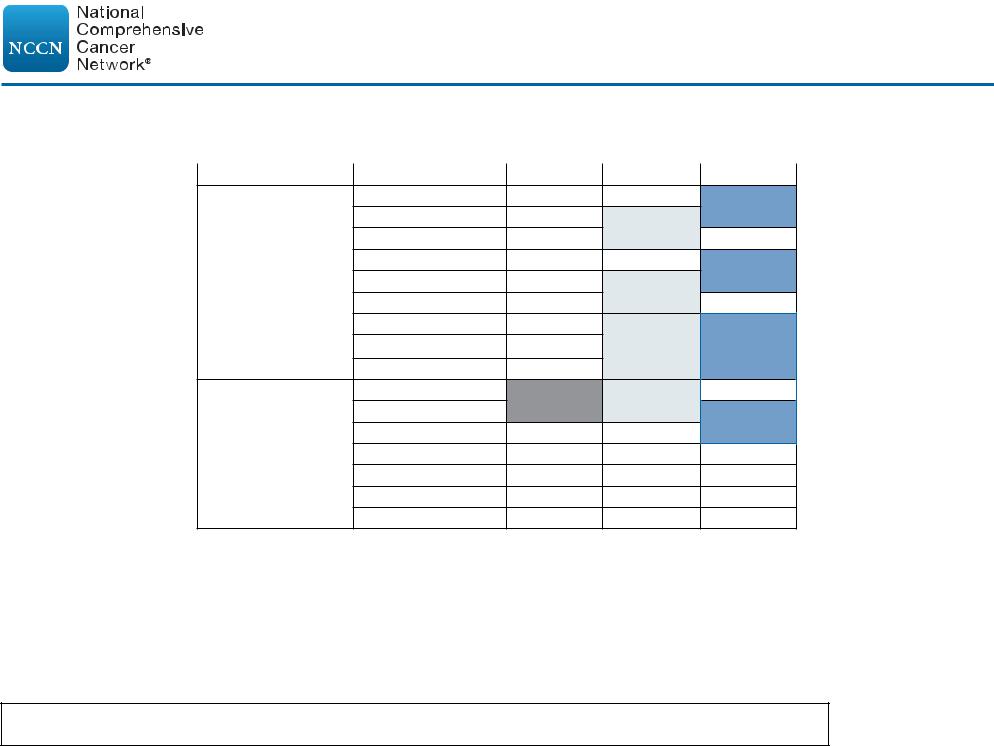
Printed by Ampleeva Olga on 3/26/2021 1:09:47 AM. For personal use only. Not approved for distribution. Copyright © 2021 National Comprehensive Cancer Network, Inc., All Rights Reserved.
NCCN Guidelines Version 3.2021
Hodgkin Lymphoma (Age ≥18 years)
NCCN Guidelines Index
Table of Contents
Discussion
PRINCIPLES OF UNFAVORABLE RISK FACTORS
Definitions of Lymph Node Regions*
Ann Arbor |
EORTC |
GHSG |
R Cervical/SCL
R ICL/Subpectoral
R Axilla
L Cervical/SCL
Supradiaphragmatic L ICL/Subpectoral
Nodal Regions
L Axilla
Mediastinum
R Hilum
L Hilum
Celiac/Spleen hilar
Paraortic
Mesenteric
Infradiaphragmatic R Iliac
Nodal Regions
L Iliac
R Inguinal/Femoral
L Inguinal/Femoral
*Note that the EORTC includes the infraclavicular/subpectoral area with the axilla while the GHSG includes it with the cervical. Both EORTC and GHSG combine the mediastinum and bilateral hila as a single region.
Note: All recommendations are category 2A unless otherwise indicated.
Clinical Trials: NCCN believes that the best management of any patient with cancer is in a clinical trial. Participation in clinical trials is especially encouraged.
Version 3.2021, 03/12/21 © 2021 National Comprehensive Cancer Network® (NCCN®), All rights reserved. NCCN Guidelines® and this illustration may not be reproduced in any form without the express written permission of NCCN.
HODG-B
2 OF 2

Printed by Ampleeva Olga on 3/26/2021 1:09:47 AM. For personal use only. Not approved for distribution. Copyright © 2021 National Comprehensive Cancer Network, Inc., All Rights Reserved.
NCCN Guidelines Version 3.2021
Hodgkin Lymphoma (Age ≥18 years)
NCCN Guidelines Index
Table of Contents
Discussion
PRINCIPLES OF SYSTEMIC THERAPY
Primary Systemic Therapy Regimens
Classic Hodgkin Lymphoma
• The most common variant of chemotherapy used at NCCN Member Institutions is ABVD.
• Routine use of growth factors is not recommended with ABVD.
• Leukopenia is not a factor for delay of treatment or reduction of dose intensity (except for escalated BEACOPP).
Regimens and References
ABVD (doxorubicin, bleomycin, vinblastine, and dacarbazine) ± ISRT
Engert A, Plutschow A, Eich HT, et al. Reduced treatment intensity in patients with early-stage Hodgkin’s lymphoma. N Engl J Med 2010;363:640-652.
Radford J, Illidge T, Counsell N, et al. Results of a trial of PET-directed therapy for early-stage Hodgkin's lymphoma. N Engl J Med 2015;372:1598-1607.
Andre MPE, Girinsky T, Federico M, et al. Early positron emission tomography response-adapted treatment in stage I and II Hodgkin lymphoma: Final results of the randomized EORTC/LYSA/FIL H10 trial. J Clin Oncol 2017;35:1786-1794.
Eich HT, Diehl V, Gorgen H, et al. Intensified chemotherapy and dose-reduced involved-field radiotherapy in patients with early unfavorable Hodgkin’s lymphoma: final analysis of the German Hodgkin Study Group HD 11 trial. J Clin Oncol 2010;28:4199-4206.
Straus DJ, Jung SH, Pitcher B, et al. CALGB 50604: risk-adapted treatment of nonbulky early-stage Hodgkin lymphoma based on interim PET. Blood 2018;132:1013-1021.
ABVD followed by escalated BEACOPP (bleomycin, etoposide, doxorubicin, cyclophosphamide, vincristine, procarbazine, and prednisone) ± ISRT
Straus DJ, Jung SH, Pitcher B, et al. CALGB 50604: risk-adapted treatment of nonbulky early-stage Hodgkin lymphoma based on interim PET. Blood 2018;132:1013-1021.
Escalated BEACOPP
Engert A, Haverkamp H, Cobe C, et al. Reduced-intensity chemotherapy and PET-guided radiotherapy in patients with advanced stage Hodgkin's lymphoma (HD15 trial): a randomised, open-label, phase 3 non-inferiority trial. Lancet 2012;379(9828):1791-1799.
Casasnovas RO, Bouabdallah R, Brice P, et al. PET-adapted treatment for newly diagnosed advanced Hodgkin lymphoma (AHL2011): a randomised, multicentre, noninferiority, phase 3 study. Lancet Oncol 2019;20:202-215.
Escalated BEACOPP followed by ABVD with ISRT
von Tresckow B, Plutschow A, Fuchs M, et al. Dose-intensification in early unfavorable Hodgkin’s lymphoma: final analysis of the German Hodgkin Study Group HD14 trial. J
Clin Oncol 2012:30:907-913.
Brentuximab vedotin + AVD (doxorubicin, vinblastine, and dacarbazine)
Connors JM, Jurczak W, Straus DJ, et al. Brentuximab vedotin with chemotherapy for stage III or IV Hodgkin's lymphoma. N Engl J Med 2018;378(4):331-344.
See Principles of Systemic Therapy for NLPHL (HODG-C 2 of 4)
See Principles of Systemic Therapy for Relapsed or Refractory Disease (HODG-C 3 of 4)
Note: All recommendations are category 2A unless otherwise indicated.
Clinical Trials: NCCN believes that the best management of any patient with cancer is in a clinical trial. Participation in clinical trials is especially encouraged.
Version 3.2021, 03/12/21 © 2021 National Comprehensive Cancer Network® (NCCN®), All rights reserved. NCCN Guidelines® and this illustration may not be reproduced in any form without the express written permission of NCCN.
HODG-C
1 OF 5

Printed by Ampleeva Olga on 3/26/2021 1:09:47 AM. For personal use only. Not approved for distribution. Copyright © 2021 National Comprehensive Cancer Network, Inc., All Rights Reserved.
NCCN Guidelines Version 3.2021
Hodgkin Lymphoma (Age ≥18 years)
NCCN Guidelines Index
Table of Contents
Discussion
PRINCIPLES OF SYSTEMIC THERAPY
Primary Systemic Therapy Regimens
Nodular Lymphocyte-Predominant Hodgkin Lymphoma
• The most common chemotherapies used at NCCN Member Institutions for NLPHL are listed below.a
Regimens and References
ABVD (doxorubicin, bleomycin, vinblastine, dacarbazine) + rituximab
Savage KJ, Skinnider B, Al-Mansour M, et al. Treating limited stage nodular lymphocyte predominant Hodgkin lymphoma similarly to classical Hodgkin lymphoma with
ABVD may improve outcome. Blood 2011;118:4585-4590.
Canellos GP, Mauch P. What is the appropriate systemic chemotherapy for lymphocyte-predominant Hodgkin's Lymphoma? J Clin Oncol 2010;28:e8.
CHOP (cyclophosphamide, doxorubicin, vincristine, prednisone) + rituximab
Fanale MA, Cheah CY, Rich A, et al. Encouraging activity for R-CHOP in advanced stage nodular lymphocyte-predominant Hodgkin lymphoma. Blood 2017;130:472477.
CVP (cyclophosphamide, vinblastine, prednisolone) + rituximab
Shankar A, Hall GW, Gorde Grosjean S, et al. Treatment outcome after low intensity chemotherapy [CVP] in children and adolescents with early stage nodular lymphocyte predominant Hodgkin's lymphoma an Anglo French collaborative report. Eur J Cancer 2012;48:1700 1706.
Rituximab
Advani RH, Hoppe RT. How I treat nodular lymphocyte predominant Hodgkin lymphoma. Blood 2013;122:4182-4188.
Advani RH, Horning SJ, Hoppe RT, et al. Mature results of a phase II study of rituximab therapy for nodular lymphocyte-predominant Hodgkin lymphoma. J Clin Oncol
2014;32:912-918.
Schulz H, Rehwald U, Morschhauser F, et al. Rituximab in relapsed lymphocyte-predominant Hodgkin lymphoma: long-term results of a phase 2 trial by the German
Hodgkin Lymphoma Study Group (GHSG). Blood 2008;111(1):109-111.
Eichenauer DA, Fuchs M, Pluetschow A, et al. Phase 2 study of rituximab in newly diagnosed stage IA nodular lymphocyte-predominant Hodgkin lymphoma: a report from the German Hodgkin Study Group. Blood 2011;118:4363-4365.
Eichenauer DA, Plutschow A, Fuchs M, et al. Long-term course of patients with stage IA nodular lymphocyte-predominant Hodgkin lymphoma: A report from the German Hodgkin Study Group. J Clin Oncol 2015;33:2857-2862.
aOngoing clinical trials will help to clarify the role of a watch-and-wait strategy or systemic therapy, including anthracycline (epirubicin or doxorubicin), bleomycin, and vinblastine-based chemotherapy or antibody-based approaches, in the treatment of these patients.
Note: All recommendations are category 2A unless otherwise indicated.
Clinical Trials: NCCN believes that the best management of any patient with cancer is in a clinical trial. Participation in clinical trials is especially encouraged.
Version 3.2021, 03/12/21 © 2021 National Comprehensive Cancer Network® (NCCN®), All rights reserved. NCCN Guidelines® and this illustration may not be reproduced in any form without the express written permission of NCCN.
HODG-C
2 OF 5

Printed by Ampleeva Olga on 3/26/2021 1:09:47 AM. For personal use only. Not approved for distribution. Copyright © 2021 National Comprehensive Cancer Network, Inc., All Rights Reserved.
NCCN Guidelines Version 3.2021
Hodgkin Lymphoma (Age ≥18 years)
NCCN Guidelines Index
Table of Contents
Discussion
PRINCIPLES OF SYSTEMIC THERAPY
RELAPSED OR REFRACTORY DISEASE
Relapsed/Refractory Disease |
|
|
|
|
|
Second-Line Optionsb (in alphabetical order) |
Subsequent Optionsb,c (in alphabetical order) |
||
CHL |
• Brentuximab vedotin1 |
|
• Bendamustine13 |
|
|
• Brentuximab vedotin + bendamustine2 |
• Bendamustine + carboplatin + etoposide14 |
||
|
• Brentuximab vedotin + nivolumab3 |
• C-MOPP (cyclophosphamide, vincristine, procarbazine, prednisone) |
||
|
• DHAP (dexamethasone, cisplatin, high-dose cytarabine)4,5 |
• Everolimus15 |
||
|
• ESHAP (etoposide, methylprednisolone, high-dose cytarabine, |
• GCD (gemcitabine, carboplatin, dexamethasone)16,17 |
||
|
cisplatin)6,7,8 |
|
• GEMOX (gemcitabine, oxaliplatin)18 |
|
|
• Gemcitabine/bendamustine/vinorelbine9 |
• Lenalidomide19 |
||
|
• GVD (gemcitabine, vinorelbine, liposomal doxorubicin)10 |
• MINE (etoposide, ifosfamide, mesna, mitoxantrone)20 |
||
|
• ICE (ifosfamide, carboplatin, etoposide)5,11 |
• Mini-BEAM (carmustine, cytarabine, etoposide, melphalan)21,22 |
||
|
• IGEV (ifosfamide, gemcitabine, vinorelbine)12 |
• Nivolumab23,24 (see indications below) |
||
|
• Pembrolizumab25,26 (for patients not candidates for transplant) |
• Pembrolizumab25,26 (see indications below) |
||
NLPHLc |
• R (rituximab) + DHAP4,5 |
• If not previously used: |
|
|
|
• R + ESHAP6,7,8 |
R-CHOP28 |
|
|
|
• R + ICE5,11 |
R-ABVD29 |
|
|
|
• R + IGEV12 |
R-CVP30 |
|
|
|
• R-Bendamustine27 |
|
|
|
General Guidelines for Checkpoint Inhibitors (CPI) for Relapsed/Refractory CHLd,e
• CPI are recommended for any patients with CHL that has relapsed or progressed after autologous HSCT ± brentuximab vedotin.31
• CPI are also an option for patients with relapsed/refractory CHL who are transplant-ineligible based on comorbidity or failure of second-line chemotherapy.
• Post-allogeneic transplant, patients can receive either nivolumab or pembrolizumab. There are limited data regarding the use of CPI following allogeneic transplantation; CPI should be used with caution before allogeneic transplantation due to increased risk of GVHD (graft- versus-host disease) and other immunologic complications.
bChoice depends on prior therapies and prior toxicities. There are no preferred second-line or subsequent therapy options. cSubsequent systemic therapy options include second-line therapy options that were not previously used.
dNational Institutes of Health. Nivolumab package insert. Available at: https://dailymed.nlm.nih.gov/dailymed/drugInfo.cfm?setid=f570b9c4-6846-4de2-abfa-
4d0a4ae4e394. Accessed December 20, 2017. |
|
|
eNational Institutes of Health. Pembrolizumab package insert. Available at: https://dailymed.nlm.nih.gov/dailymed/drugInfo.cfm?setid=9333c79b-d487-4538-a9f0- |
||
71b91a02b287. Accessed December 20, 2017. |
References |
|
|
||
Note: All recommendations are category 2A unless otherwise indicated. |
||
|
||
Clinical Trials: NCCN believes that the best management of any patient with cancer is in a clinical trial. Participation in clinical trials is especially encouraged. |
HODG-C |
|
|
||
Version 3.2021, 03/12/21 © 2021 National Comprehensive Cancer Network® (NCCN®), All rights reserved. NCCN Guidelines® and this illustration may not be reproduced in any form without the express written permission of NCCN. |
3 OF 5 |
|

Printed by Ampleeva Olga on 3/26/2021 1:09:47 AM. For personal use only. Not approved for distribution. Copyright © 2021 National Comprehensive Cancer Network, Inc., All Rights Reserved.
NCCN Guidelines Version 3.2021
Hodgkin Lymphoma (Age ≥18 years)
NCCN Guidelines Index
Table of Contents
Discussion
PRINCIPLES OF SYSTEMIC THERAPY FOR RELAPSED OR REFRACTORY DISEASE
References
1 Younes A, Gopal AK, Smith SE, et al. Results of a pivotal phase II study of brentuximab vedotin for patients with relapsed or refractory Hodgkin's lymphoma.
J Clin Oncol 2012;30:2183-2189.
2 O'Connor OA, Lue JK, Sawas A, et al. Brentuximab vedotin plus bendamustine in relapsed or refractory Hodgkin's lymphoma: an international, multicentre, single-arm, phase 1-2 trial. Lancet Oncol 2018;19:257-266.
3 Herrera AF, Moskowitz AJ, Bartlett NL, et al. Interim results of brentuximab vedotin in combination with nivolumab in patients with relapsed or refractory
Hodgkin lymphoma. Blood 2018;131:1183-1194.
4 Josting A, Rudolph C, Reiser M, et al. Time-intensified dexamethasone/cisplatin/ cytarabine: an effective salvage therapy with low toxicity in patients with relapsed and refractory Hodgkin's disease. Ann Oncol 2002;13(10):1628-1635.
5 Abali H, Urün Y, Oksüzoğlu B, Budakoğlu B, et al. Comparison of ICE
(ifosfamide-carboplatin-etoposide) versus DHAP (cytosine arabinoside-cisplatin- dexamethasone) as salvage chemotherapy in patients with relapsed or refractory lymphoma. Cancer Invest 2008;26(4):401-406.
6 Aparicio J, Segura A, Garcera S, et al. ESHAP is an active regimen for relapsing
Hodgkin's disease. Ann Oncol 1999;10(5):593-595.
7 Fernández de Larrea C, Martínez C, et al. Salvage chemotherapy with alternating MINE-ESHAP regimen in relapsed or refractory Hodgkin's lymphoma followed by autologous stem cell transplantation. Ann Oncol 2010;21(6):12111216.
8 Labrador J, Cabrero-Calvo M, Perez-Lopez E, et al. ESHAP as salvage therapy for relapsed or refractory Hodgkin's lymphoma.Ann Hematol 2014;93:1745-1753.
9 Santoro A, Mazza R, Pulsoni A, et al. Bendamustine in combination with gemcitabine and vinorelbine is an effective regimen as induction chemotherapy before autologous stem-cell transplantation for relapsed or refractory
Hodgkin lymphoma: final results of a multicenter phase II study. J Clin Oncol
2016;34:3293-3299.
10 Bartlett N, Niedzwiecki D, Johnson J, et al. Gemcitabine, vinorelbine, and pegylated liposomal doxorubicin (GVD), a salvage regimen in relapsed
Hodgkin's lymphoma: CALGB 59804. Ann Oncol 2007;18(6):1071-1079.
11 Moskowitz CH, Nimer SD, Zelenetz AD, et al. A 2-step comprehensive highdose chemoradiotherapy second-line program for relapsed and refractory Hodgkin disease: analysis by intent to treat and development of a prognostic model. Blood 2001;97(3):616-623.
12Santoro A, Magagnoli M, Spina M, et al. Ifosfamide, gemcitabine, and vinorelbine: a new induction regimen for refractory and relapsed Hodgkin's lymphoma. Haematologica 2007;92(1):35-41.
13Moskowitz AJ, Hamlin PA, Perales M-A, et al. Phase II study of bendamustine in relapsed and refractory Hodgkin lymphoma. J Clin Oncol 2013;31:456-460.
14Budde LE, Wu D, Martin DB, et al. Bendamustine with rituximab, etoposide and carboplatin (T(R)EC) in relapsed or refractory aggressive lymphoma: a prospective multicentre phase 1/2 clinical trial. Br J Haematol 2018;183:601-607.
15Johnston PB, Inwards DJ, Colgan JP, et al; A Phase II trial of the oral mTOR inhibitor everolimus in relapsed Hodgkin lymphoma. Am J Hematol 2010;85(5):320-324.
16Crump M, Kuruvilla J, Couban S, et al. Randomized comparison of gemcitabine, dexamethasone, and cisplatin versus dexamethasone, cytarabine, and cisplatin chemotherapy before autologous stem-cell transplantation for relapsed and refractory aggressive lymphomas: NCIC-
CTG LY.12. J Clin Oncol 2014;32:3490-3496.
17Gopal AK, Press OW, Shustov AR, et al. Efficacy and safety of gemicitabine, carboplatin, dexamethasone, and rituximab in patients with relapsed/refractory lymphoma: a prospective multi-center phase II study by
Puget Sound Oncology Consortium. Leuk Lymphoma 2010;51:1523-1529.
18Gutierrez A, Rodriguez J, Martinez-Serra J, et al. Gemcitabine and oxaliplatinum: an effective regimen in patients with refractory and relapsing
Hodgkin lymphoma. Onco Targets Ther 2014;7:2093-2100.
19Fehniger TA, Larson S, Trinkaus K, et al; A phase 2 multicenter study of lenalidomide in relapsed or refractory classical Hodgkin lymphoma. Blood
2011;118(19):5119-25.
20Rodriguez MA, Cabanillas FC, Hagemeister FB, et al. A phase II trial of mesna/ifosfamide, mitoxantrone and etoposide for refractory lymphoms.
Ann Oncol 1995;6(6):609-611.
21Colwill R, Crump M, Couture F, et al. Mini-BEAM as salvage therapy for relapsed or refractory Hodgkin's disease before intensive therapy and autologous bone marrow transplantation. J Clin Oncol 1995;13:396-402.
Note: All recommendations are category 2A unless otherwise indicated.
Clinical Trials: NCCN believes that the best management of any patient with cancer is in a clinical trial. Participation in clinical trials is especially encouraged.
Version 3.2021, 03/12/21 © 2021 National Comprehensive Cancer Network® (NCCN®), All rights reserved. NCCN Guidelines® and this illustration may not be reproduced in any form without the express written permission of NCCN.
HODG-C
4 OF 5

Printed by Ampleeva Olga on 3/26/2021 1:09:47 AM. For personal use only. Not approved for distribution. Copyright © 2021 National Comprehensive Cancer Network, Inc., All Rights Reserved.
NCCN Guidelines Version 3.2021
Hodgkin Lymphoma (Age ≥18 years)
NCCN Guidelines Index
Table of Contents
Discussion
PRINCIPLES OF SYSTEMIC THERAPY FOR RELAPSED OR REFRACTORY DISEASE
References
22Martín A, Fernández-Jiménez MC, Caballero MD, et al. Long-term follow-up in patients treated with Mini-BEAM as salvage therapy for relapsed or refractory Hodgkin's disease. Br J Haematol 2001;113(1):161-171.
23Ansell SM, Lesokhin AM, Borrello I, et al. PD-1 blockade with nivolumab in relapsed or refractory Hodgkin’s lymphoma. N Engl J Med 2015;372:311-319.
24Timmerman J, Armand P, Lesokhin AM, et al. Nivolumab in patients with relapsed or refractory lymphoid malignancies and classical Hodgkin lymphoma:
Updated results of a phase 1 study (CA 209-039) [abstract]. Hematol Oncol 2015;33:Abstract 010.
25Chen R, Zinzani PL, Fanale MA, et al. Phase II study of the efficacy and safety of pembrolizumab for relapsed/refractory classic Hodgkin lymphoma. J Clin
Oncol 2017;35(19):2125-2132.
26Kuruvilla J, Ramchandren R, Santoro A, et al. KEYNOTE-204: Randomized, open-label, phase III study of pembrolizumab (pembro) versus brentuximab vedotin (BV) in relapsed or refractory classic Hodgkin lymphoma (R/R cHL). Journal of Clinical Oncology 2020;38:8005-8005.
27Prusila REI, Haapasaari KM, Marin K, et al. R-Bendamustine in the treatment of nodular lymphocyte-predominant Hodgkin lymphoma. Acta Oncol 2018;57:1265-1267.
28Fanale MA, Cheah CY, Rich A, et al. Encouraging activity for R-CHOP in advanced stage nodular lymphocyte-predominant Hodgkin lymphoma. Blood 2017;130:472477.
29Advani RH, Hoppe RT. How I treat nodular lymphocyte predominant Hodgkin lymphoma. Blood 2013;122 (26):4182-4188.
30Shankar A, Hall GW, Gorde-Grosjean S, et al. Treatment outcome after low intensity chemotherapy [CVP] in children and adolescents with early stage nodular lymphocyte predominant Hodgkin's lymphoma - an Anglo-French collaborative report. Eur J Cancer 2012;48:1700-1706.
31Moskowitz CH, Nademanee A, Masszi T, et al. Brentuximab vedotin as consolidation therapy after autologous stem-cell transplantation in patients with Hodgkin's lymphoma at risk of relapse or progression (AETHERA): a randomised, double-blind, placebo-controlled, phase 3 trial. Lancet 2015;385:1853-1862.
Note: All recommendations are category 2A unless otherwise indicated.
Clinical Trials: NCCN believes that the best management of any patient with cancer is in a clinical trial. Participation in clinical trials is especially encouraged.
Version 3.2021, 03/12/21 © 2021 National Comprehensive Cancer Network® (NCCN®), All rights reserved. NCCN Guidelines® and this illustration may not be reproduced in any form without the express written permission of NCCN.
HODG-C
5 OF 5

Printed by Ampleeva Olga on 3/26/2021 1:09:47 AM. For personal use only. Not approved for distribution. Copyright © 2021 National Comprehensive Cancer Network, Inc., All Rights Reserved.
NCCN Guidelines Version 3.2021
Hodgkin Lymphoma (Age ≥18 years)
NCCN Guidelines Index
Table of Contents
Discussion
PRINCIPLES OF RADIATION THERAPY
General Principles
•Treatment with photons, electrons, or protons may all be appropriate, depending on clinical circumstances.
•Advanced RT technologies such as intensity-modulated RT (IMRT)/volumetric modulated arc therapy (VMAT), breath hold or respiratory gating, and/or image-guided RT (IGRT), or proton therapy may offer significant and clinically relevant advantages in specific instances to spare important OARs such as the heart
(including coronary arteries, valves, and left ventricle), lungs, kidneys, spinal cord, esophagus, carotid artery, bone marrow, breasts, stomach, muscle/soft tissue, and salivary glands and decrease the risk for late, normal tissue damage while still achieving the primary goal of local tumor control. For optimal mediastinal treatment planning, organs/tissues to be contoured should include the lungs, heart, coronary arteries, and left ventricle.
•The demonstration of significant dose-sparing for these OARs reflects best clinical practice, as it reduces the risk of late complications from normal tissue damage. Achieving highly conformal dose distributions is especially important for patients who are being treated with curative intent or who have long life expectancies following therapy.
•In mediastinal Hodgkin lymphoma, the use of 4D-CT for simulation and the adoption of strategies to deal with respiratory motion and minimize dose to OARs are essential, especially deep inspiration breath-hold techniques, respiratory gating, and image-guided RT during treatment delivery. Breath-hold techniques have been shown to decrease incidental dose to the heart and lungs in many disease presentations.
•Although the advantages of these techniques include tightly conformal doses and steep gradients next to normal tissues, the "low-dose bath" to normal structures such as the breasts must be considered
in choosing the final radiation therapy technique. In any case, target definition and delineation and treatment delivery verification require careful monitoring to avoid the risk of tumor geographic miss and subsequent decrease in tumor control. Initial diagnostic imaging with contrast-enhanced CT, MRI, PET, ultrasound, and other imaging
modalities facilitate target definition. Image guidance may be required to provide assurance of accurate daily delivery.
•Randomized studies to test these concepts are unlikely to be done since these techniques are designed to decrease late effects, which take 10+ years to develop. In light of that, the modalities and techniques that are found to best reduce the doses to the OARs in a clinically meaningful way without compromising target coverage should be considered.
Involved-Site Radiation Therapy (ISRT) Dose
• Combined Modality Therapy
Non-bulky disease (stage I–II): 20a–30 Gy (if treated with ABVD); 1.5–2.0 Gy per fractionNon-bulky disease (stage IB–IIB): 30 Gy; 1.5–2.0 Gy per fraction
Bulky disease sites (all stages): 30–36 Gy; 1.5–2.0 Gy per fractionSites of partial response to chemotherapy: 36–45 Gy
• ISRT Alone (uncommon, except for NLPHL)
Involved regions: 30–36 Gy (the dose of 30 Gy is mainly used for NLPHL); 1.5–2.0 Gy per fraction
Uninvolved regions: 25–30 Gy; 1.5–2.0 Gy per fraction. ISRT for NLPHL includes extension to clinically relevant initially uninvolved nodes.
• Palliative RT: 4–30 Gy
a A dose of 20 Gy following ABVD x 2 is sufficient if the patient has non-bulky stage I–IIA disease with an ESR <50, no extralymphatic lesions, and only one or two lymph
node regions involved. See HODG-B for definition of nodal sites according to GHSG. |
References |
|
|
||
Note: All recommendations are category 2A unless otherwise indicated. |
||
|
||
Clinical Trials: NCCN believes that the best management of any patient with cancer is in a clinical trial. Participation in clinical trials is especially encouraged. |
HODG-D |
|
|
||
Version 3.2021, 03/12/21 © 2021 National Comprehensive Cancer Network® (NCCN®), All rights reserved. NCCN Guidelines® and this illustration may not be reproduced in any form without the express written permission of NCCN. |
1 OF 11 |

Printed by Ampleeva Olga on 3/26/2021 1:09:47 AM. For personal use only. Not approved for distribution. Copyright © 2021 National Comprehensive Cancer Network, Inc., All Rights Reserved.
NCCN Guidelines Version 3.2021
Hodgkin Lymphoma (Age ≥18 years)
NCCN Guidelines Index
Table of Contents
Discussion
PRINCIPLES OF RADIATION THERAPY
Volumes
• ISRT is recommended as the appropriate field for Hodgkin lymphoma.
Planning for ISRT requires modern CT-based simulation and treatment planning capabilities.
Incorporating other modern imaging such as PET and MRI often enhances treatment volume determination.
• ISRT targets the site of the originally involved lymph node(s).
The volume encompasses the original or suspected extent of disease prior to chemotherapy or surgery. However, it spares adjacent uninvolved organs (eg, lungs, bone, muscle, kidney) when lymphadenopathy regresses following chemotherapy.
• The pre-chemotherapy or pre-biopsy gross tumor volume (GTV) provides the basis for determining the clinical target volume (CTV).
Concerns for questionable subclinical disease and uncertainties in original imaging accuracy or localization may lead to expansion of the
CTV and are determined individually using clinical judgment.
• For NLPHL, often treated with RT alone, treatment should extend beyond the PET-positive or CT-enlarged nodes.
The CTV definition for treating NLPHL with RT alone will be greater than that employed for CHL with similar disease distribution being treated with combined modality therapy.
•Possible movement of the target by respiration as determined by 4D-CT or fluoroscopy (internal target volume, ITV) should also influence the final CTV.
•The planning target volume (PTV) is an additional expansion of the CTV that accounts only for setup variations and may differ by site and immobilization technique.
See ICRU definitions: Gregoire V, Mackie TR. State of the art on dose prescription, reporting and recording in Intensity-Modulated Radiation
Therapy (ICRU report No. 83). Cancer Radiother 2011;15:555-559.
•OARs should be outlined for optimizing treatment plan decisions.
•The treatment plan can be designed using conventional, 3-D conformal, proton therapy, or IMRT techniques using clinical treatment planning considerations of coverage and normal tissue avoidance.
•The treatment of extranodal disease is individualized, but similar principles of GTV/CTV/PTV definition should be applied as for nodal
disease.
Chest wall extension – effort should be made to include regions of initial chest wall extension to definitive doses.
Lung involvement – areas of extension into the lung from mediastinal or hilar disease may be treated with lower doses (~15 Gy) unless the relative volume is small, in which case higher doses may be utilized. Careful consideration of partial lung tolerance is essential. Pulmonary nodular disease is usually not treated following chemotherapy unless residual disease is present.
Pleural or pericardial effusions are not included in the GTV. Nodular pericardial involvement may be included with consideration of cardiac tolerance.
Bone – Areas of osseous disease may be treated with a CTV expansion beyond the GTV defined by imaging. In the presence of vertebral body disease, the entire vertebra is generally treated.
Note: All recommendations are category 2A unless otherwise indicated.
Clinical Trials: NCCN believes that the best management of any patient with cancer is in a clinical trial. Participation in clinical trials is especially encouraged.
Version 3.2021, 03/12/21 © 2021 National Comprehensive Cancer Network® (NCCN®), All rights reserved. NCCN Guidelines® and this illustration may not be reproduced in any form without the express written permission of NCCN.
References
HODG-D 2 OF 11

Printed by Ampleeva Olga on 3/26/2021 1:09:47 AM. For personal use only. Not approved for distribution. Copyright © 2021 National Comprehensive Cancer Network, Inc., All Rights Reserved.
NCCN Guidelines Version 3.2021
Hodgkin Lymphoma (Age ≥18 years)
NCCN Guidelines Index
Table of Contents
Discussion
PRINCIPLES OF RADIATION THERAPY
RT DOSE CONSTRAINT GUIDELINES FOR LYMPHOMAb
|
Organ at Risk |
Dose Recommendation |
Toxicity |
|
|
||
|
|
|
(1.5-2 Gy/fraction) |
|
|
|
|
|
|
Parotid glands |
Ipsilateral: Mean <11 Gy (recommended); |
Xerostomia18,19 |
|
|
|
|
|
<24 Gy (acceptable) |
|
|
|||
|
|
|
Contralateral: ALARAc |
|
|
|
|
|
|
Submandibular glands |
Ipsilateral: Mean <11 Gy (recommended); |
Xerostomia20 |
|
|
|
|
|
<24 Gy (acceptable) |
|
|
|||
|
Head |
|
Contralateral: ALARAc |
|
|
|
|
|
Oral Cavity |
Mean <11 Gy |
Xerostomia, dysgeusia, oral mucositis20 |
|
|||
|
and |
(surrogate for minor salivary glands) |
|
|
|
|
|
|
Neck |
|
|
|
|
|
|
|
Thyroid |
V25 Gy <63.5% |
Hypothyroidism21 |
|
|
||
|
|
|
|
||||
|
|
|
Minimize V30 Gy |
|
|
|
|
|
|
Lacrimal glands |
V20 Gy <80% |
Dry eye syndrome22 |
|
|
|
|
|
Larynx/Pharyngeal constrictors |
Mean <25 Gy |
Laryngeal edema, dysphagia23 |
|
|
|
|
|
Carotids |
Ipsilateral: Avoid hotspots |
Carotid artery atherosclerosis |
|
|
|
|
|
Contralateral: ALARAc |
|
|
|||
|
|
Heart |
Mean <8 Gy (recommended) |
Major adverse cardiac eventsd,24-27 |
|
||
|
|
|
Mean <15 Gy (acceptable) |
|
|
|
|
|
|
Aortic and mitral valves |
Dmax <25 Gy |
Valvular heart disease25,28,29 |
|
|
|
|
|
Tricuspid and pulmonic valves |
Dmax <30 Gy |
|
|
||
|
|
|
|
|
|
||
|
Thorax |
Left ventricle |
Mean <8 Gy (recommended) |
Heart failure25,30 |
|
|
|
|
|
Mean <15 Gy (acceptable) |
|
|
|
|
|
|
|
Pericardium |
D100 (heart) <5 Gy |
Pericarditis31 |
|
|
|
|
|
Coronary vessels |
Avoid hotspots |
|
|
|
|
|
|
Lungs |
Mean dose <13.5 Gy |
Pneumonitis32 |
|
|
|
|
|
V20 <30% |
|
|
|||
|
|
|
V5 <55% |
|
|
|
|
|
|
|
d As cardiac toxicity is likely related to dose to specific substructures, it is recommended |
||||
b General Principles of RT Dose Contraints, see HODG-D (5 of 11). |
that these are contoured, constraints applied, and doses recorded. Contouring atlases are |
||||||
c ALARAas low as reasonably achievable. |
available.33,34 |
|
|
References |
|||
Note: All recommendations are category 2A unless otherwise indicated. |
|
|
|
||||
|
|
|
|
|
|||
Clinical Trials: NCCN believes that the best management of any patient with cancer is in a clinical trial. Participation in clinical trials is especially encouraged. |
|
HODG-D |
|||||
|
|
|
|
|
|
||
Version 3.2021, 03/12/21 © 2021 National Comprehensive Cancer Network® (NCCN®), All rights reserved. NCCN Guidelines® and this illustration may not be reproduced in any form without the express written permission of NCCN. |
3 OF 11 |
||||||

Printed by Ampleeva Olga on 3/26/2021 1:09:47 AM. For personal use only. Not approved for distribution. Copyright © 2021 National Comprehensive Cancer Network, Inc., All Rights Reserved.
NCCN Guidelines Version 3.2021
Hodgkin Lymphoma (Age ≥18 years)
NCCN Guidelines Index
Table of Contents
Discussion
PRINCIPLES OF RADIATION THERAPY
RT DOSE CONSTRAINT GUIDELINES FOR LYMPHOMAb
|
Organ at Risk |
Dose Recommendation |
|
Toxicity |
|
|
|||
|
|
|
(1.5-2 Gy/fraction) |
|
|
|
|
|
|
|
|
Liver |
Mean <15 Gy |
|
Hepatic toxicity35,36 |
|
|
||
|
|
V20 |
<30% |
|
|
|
|||
|
|
|
V30 |
<20% |
|
|
|
|
|
|
|
Stomach |
Dmax <45 Gy |
|
Ulceration37 |
|
|
||
|
|
Spleen |
Mean <10 Gy; |
|
Late infections38 |
|
|
||
|
Abdomen |
V5 ≤30% |
|
Lymphopenia39 |
|
|
|||
|
|
V15 |
≤20% |
|
|
|
|
|
|
|
|
Pancreas |
Minimize volume >36 Gy (especially to pancreatic tail) |
Diabetes40 |
|
|
|||
|
|
Small Bowel |
V15 |
<120 cc |
|
Diarrhea37 |
|
|
|
|
|
Dmax <45 Gy |
|
Obstruction, ulceration, fistula37 |
|
|
|||
|
|
Kidneys |
Mean <8 Gy |
|
Renal insufficiency41,42 |
|
|
||
|
|
V10 |
<30% |
|
|
|
|||
|
|
|
V20: <15% (recommended); <25% (acceptable) |
|
|
|
|
||
|
|
Bone marrowe |
V5: ALARAc |
|
43,44 |
|
|
|
|
|
Other |
V10 |
< 50% |
|
Acute cytopenias 45 |
|
|
||
|
|
V25 |
< 25% |
|
Chronic cytopenias |
|
|
||
|
|
Long Bone |
V40 |
< 64% |
|
Fracture46 |
|
|
|
SECONDARY MALIGNANCIESf |
|
|
|
|
|
|
|
||
|
Organ at Risk |
Dose Recommendation |
|
Secondary Malignancy |
|
|
|||
|
|
|
(1.8-2 Gy/fraction) |
|
|
|
|
|
|
|
Breast |
|
Minimize volume >4 Gy |
|
Breast cancer (adenocarcinoma)50 |
|
|
||
|
Esophagus |
|
Minimize volume >30 Gy |
|
Esophagus cancer51 |
|
|
||
|
Stomach |
|
Minimize volume >25 Gy |
|
Stomach cancer52 |
|
|
||
|
Pancreas |
|
Minimize volume >5-10 Gy |
|
Pancreas cancer53 |
|
|
||
b General Principles of RT Dose Contraints, see HODG-D (5 of 11). |
f The linear no-threshold model supports limiting radiation dose to susceptible |
||||||||
c ALARAas low as reasonably achievable. |
|
|
|||||||
e Active bone marrow can be delineated using various imaging modalities and is most |
organs as low as reasonably achievable. The following dose guidelines, |
||||||||
abundant in the pelvic bones, thoracic-lumbar spine, and sacrum.47-49 |
based on published data, may further guide treatment decisions. |
||||||||
|
|
|
|
|
|
|
|
References |
|
Note: All recommendations are category 2A unless otherwise indicated. |
|
|
|
||||||
|
|
|
|
|
|||||
Clinical Trials: NCCN believes that the best management of any patient with cancer is in a clinical trial. Participation in clinical trials is especially encouraged. |
|
HODG-D |
|||||||
|
|
|
|
|
|
|
|
||
Version 3.2021, 03/12/21 © 2021 National Comprehensive Cancer Network® (NCCN®), All rights reserved. NCCN Guidelines® and this illustration may not be reproduced in any form without the express written permission of NCCN. |
|
4 OF 11 |
|||||||

Printed by Ampleeva Olga on 3/26/2021 1:09:47 AM. For personal use only. Not approved for distribution. Copyright © 2021 National Comprehensive Cancer Network, Inc., All Rights Reserved.
NCCN Guidelines Version 3.2021
Hodgkin Lymphoma (Age ≥18 years)
NCCN Guidelines Index
Table of Contents
Discussion
PRINCIPLES OF RADIATION THERAPY
RT DOSE CONSTRAINT GUIDELINES FOR LYMPHOMA
General Principles of RT Dose Constraints
•Patients with hematologic malignancies typically receive far lower doses than patients with epithelial or mesenchymal malignancies and generally have more favorable long-term outcomes. Therefore, more stringent dose constraints, often proportionally reduced from acceptable thresholds in other malignancies, are recommended. Doses to organs at risk should follow principles of ALARA (as low as reasonably achievable). In some scenarios, target coverage may require dose constraints to be exceeded if the organ at risk is within the planning target volume.
•A relatively rare but serious complication of radiation therapy is induction of secondary malignancies. Most studies have shown that increasing dose is associated with increasing risk without a safe threshold dose (linear no-threshold model).54 Therefore, limiting radiation dose to susceptible organs as much as possible is vital. Diseaseand patient-related factors are also contributory (e.g., age, tobacco exposure, etc.).
•In addition to secondary malignancies, cardiac and pulmonary complications after radiation therapy are most concerning and are reviewed further in the following sections.
Heart
•Multiple cardiac complications can develop from mediastinal radiation therapy including pericarditis, arrhythmias, coronary artery disease (CAD), valvular disease, and cardiomyopathy/congestive heart failure.27,55 In addition to radiation factors, the risk of cardiac events is also influenced by chemotherapy administration (e.g., doxorubicin), pre-existing cardiovascular disease, age, and other cardiac risk factors (e.g., diabetes, hypertension, hyperlipidemia).27,56-58 While global heart metrics such mean heart dose are most commonly utilized to assess risk, there is an increasing recognition that radiation dose-fractionation to cardiac substructures must be accounted for. Atlases for radiation oncologists to assist with contouring cardiac substructures are available.59-61
•Because of the long-term survival of thousands of patients with breast cancer and Hodgkin lymphoma (HL), many large cohort studies have been able to explore the relationship of heart radiotherapy dose with cardiac toxicity and death. Mediastinal radiotherapy of lymphomas, relative to breast cancer and other thoracic malignancies, is characterized by radiation exposures to larger volumes of the heart and substructures, albeit to lower doses (20-40 Gy). Common for both breast and lymphoma RT, there is typically a latency of more than 20 years for secondary cardiac disease.27,62-64
•As mentioned previously, most studies have associated cardiac events with either prescribed mediastinal radiation dose or mean heart dose. In both the breast cancer and lymphoma radiotherapy literature, mean heart dose has been related to the risk of cardiac events despite the variable volume of whole heart exposed in these two diseases. The risk appears to be linear, without a clear safe threshold dose, with the risk of heart disease increasing by 4.1–7.4% per 1 Gy of cardiac radiation dose administered.27,62-64 One of the best datasets relating radiation dose to cardiac disease risk in adult patients is a HL case-control study from the Netherlands.27 Patients were treated prior to 1996 mainly using AP/PA fields. Using the metric of mean heart dose as a measure of cardiac toxicity risk, Van Nimwegen et al. demonstrated an excess relative risk of 7.4% per Gy mean heart dose. A statistically significant increased risk of coronary heart disease was demonstrated among patients getting a mean heart dose as low as 5–14 Gy (RR 2.31) compared with a mean heart dose of 0 Gy. This risk was even higher for mean heart dose of 15 Gy or higher (RR 2.83 for 15–19 Gy, 2.9 for 20–24 Gy, and 3.35 for 25–34 Gy). This study also explored different age- of-diagnosis cohorts and generally showed the same radiation dose-response relationships.
Note: All recommendations are category 2A unless otherwise indicated.
Clinical Trials: NCCN believes that the best management of any patient with cancer is in a clinical trial. Participation in clinical trials is especially encouraged.
Version 3.2021, 03/12/21 © 2021 National Comprehensive Cancer Network® (NCCN®), All rights reserved. NCCN Guidelines® and this illustration may not be reproduced in any form without the express written permission of NCCN.
References
HODG-D 5 OF 11

Printed by Ampleeva Olga on 3/26/2021 1:09:47 AM. For personal use only. Not approved for distribution. Copyright © 2021 National Comprehensive Cancer Network, Inc., All Rights Reserved.
NCCN Guidelines Version 3.2021
Hodgkin Lymphoma (Age ≥18 years)
NCCN Guidelines Index
Table of Contents
Discussion
PRINCIPLES OF RADIATION THERAPY
RT DOSE CONSTRAINT GUIDELINES FOR LYMPHOMA
Heart (continued)
•The number of studies evaluating specific dose constraints for cardiac substructures is rather limited. Dutch investigators demonstrated a relationship between heart failure and mean dose to the left ventricle.27 Chemotherapy was a clear confounder in regards to the risk of heart failure. Among patients treated with anthracyclines, the 25-year cumulative risk of heart failure was 11.2% for mean LV dose <15 Gy, 15.9% for 16–20 Gy, and 32.9% for greater than or equal to 21 Gy.
•In regards to valvular disease, increasing mediastinal radiation dose, especially above 30 Gy, has been associated with an elevated risk of valvular dysfunction.27,63 Using a large Dutch cohort of adult patients treated to the mediastinum, Cutter et al. demonstrated 30-year
cumulative risks of valvular heart disease of 3%, 6.4%, 9.3%, and 12.4% for mean valvular dose of <30, 31–35, 36–40, and >40 Gy.28 Valvular heart disease (VHD) was related to aortic valve abnormalities in 71% of patients. Mitral valvular abnormalities, which can also be related
to ischemic heart disease due to papillary muscle dysfunction after myocardial infarction, occurred in 50% (some patients had multiple dysfunctional valves). Tricuspid valvular disease was uncommon and pulmonic valve dysfunction was not reported – perhaps due to right heart dysfunction tending to be less clinically problematic. There was no confounding effect of anthracycline chemotherapy on valvular heart disease risk in this study. In agreement with this Dutch study, the previously mentioned German-Austrian pediatric cohort showed that prescribed mediastinal radiation dose was the only independent risk factor for VHD.29 No cases of VHD were observed for individuals with doses of 20 Gy, while the 25-year cumulative risks among individuals with prescribed doses of 25 Gy, 30 Gy, and 36 Gy were 2%, 1%, and 16%, respectively.
•Radiation dose constraints for coronary arteries is a work in progress. Standard CT-simulation imaging, even with contrast, does not identify the entire coronary tree very well. There are resolution issues, acquisition time issues, and cardiac motion issues. Coronary anatomy is quite variable along with some individual variation with collateral blood flow. Proximal coronary arteries and the mid-trunk of the left anterior descending (LAD) are often visible, since the latter is located in the epicardial fat of the left anterolateral aspect of the global heart structure, apparently with minimal motion artifact. Even with research techniques to merge coronary CT angiograms,65,66 the important branch vessels (diagonals off the LAD; obtuse marginals off the left circumflex (LCx), posterior descending branch of the right coronary artery (RCA)) are not well demonstrated. Nevertheless, there have been studies in breast and lymphoma radiotherapeutic management to contour the major coronary arteries and try to relate coronary dosimetry to risk of CAD. Moignier, et.al. analyzed 33 irradiated HL patients21 without coronary stenosis (controls) and 12 patients with critical coronary stenosis (cases) seen on CT angiography.66 Radiation dose to stenotic coronary segments and normal coronary segments was compared using a logistic regression. In this manner, the risk of stenosis was found to be increased by 4.9% per Gy over the median dose to the control segments. This dataset is too small to be a basis of radiation dose constraints, but does support the general notion of a dose-response effect in the clinical range of lymphoma radiation prescriptions. Another study by
Hahn, et.al. used a sample of 125 HL patients treated with mediastinal RT and analyzed various dosimetry parameters of whole heart and coronary segments, looking for a relationship to cardiac events.67 Multivariable competing risk regression models found that when any adverse cardiac event was the outcome, models using coronary artery variables did not perform better than models using whole heart variables. However, in a sub-analysis of ischemic cardiac events only, the model using coronary artery variables was superior to the whole heart. Major findings for this study were that the V5 Gy for the LAD and the V20 Gy for the LCx had predictive value when looking at ischemic endpoints such as need for coronary revascularization, myocardial infarction, or cardiac death. The modeling analysis was not robust enough to yield specific guidance on dose constraints to specific coronary arteries.
Note: All recommendations are category 2A unless otherwise indicated.
Clinical Trials: NCCN believes that the best management of any patient with cancer is in a clinical trial. Participation in clinical trials is especially encouraged.
Version 3.2021, 03/12/21 © 2021 National Comprehensive Cancer Network® (NCCN®), All rights reserved. NCCN Guidelines® and this illustration may not be reproduced in any form without the express written permission of NCCN.
References
HODG-D 6 OF 11

Printed by Ampleeva Olga on 3/26/2021 1:09:47 AM. For personal use only. Not approved for distribution. Copyright © 2021 National Comprehensive Cancer Network, Inc., All Rights Reserved.
NCCN Guidelines Version 3.2021
Hodgkin Lymphoma (Age ≥18 years)
NCCN Guidelines Index
Table of Contents
Discussion
PRINCIPLES OF RADIATION THERAPY
RT DOSE CONSTRAINT GUIDELINES FOR LYMPHOMA
Heart (continued)
•From the historical use of extended field radiotherapy for HL, whole heart irradiation increases the risk of constrictive pericarditis, especially with doses > 15 Gy. Modern radiotherapy for lymphomas rarely requires whole heart irradiation.
•Patients who survived childhood cancers represent a unique high-risk group. In a French cohort study of pediatric HL survivors, the relative risk of severe cardiac disease at the age of 40 is 1.9 at a cardiac radiation dose of 1–5 Gy and increases to 19.5–75.2 at a dose > 15 Gy for survivors of childhood cancer.24 There are at least two other notable pediatric survivorship study cohorts that provide insights to radiation dose relationship with subsequent cardiovascular disease. Schellong, et.al. reported on 1132 HL survivors treated on the German-Austrian pediatric cooperative group studies from 1978-1995.29 Patients could be binned into mediastinal radiation dose exposures of 36 Gy, 30
Gy, 25 Gy, 20 Gy, and 0 Gy. Cardiac valvular defects were the most frequent late cardiac disease, followed by coronary artery disease, cardiomyopathy, conduction disorders, and pericardial abnormalities. The cumulative incidence of cardiac disease after 25 years correlated with radiation dose with incidence of 21% for 36 Gy, decreasing to 10%, 6%, 5%, and 3% for the lower dose groups, respectively (P<0.001).
Multivariate analysis of several putative risk factors showed that mediastinal dose was the only significant variable predicting for cardiac disease-free survival (P=0.0025). Mulrooney et.al. published the Childhood Cancer Survivor Study (CCSS) analysis of cardiovascular disease risk in pediatric cancer survivors (not just HL) and analyzed the confounding and independent effects of anthracycline and mediastinal radiation prescribed dose showing a dose-response effect for both chemotherapy and radiotherapy.25 In this study of 14,358 patients, doses between 15 Gy and 35 Gy were not well distinguished, but there was a suggestion that 15 Gy might be a threshold dose associated with not only future valvular heart disease but also congestive heart failure and myocardial infarction. Bates, et.al., recently updated the CCSS experience in a 2019 publication of 24,214 5-year survivors, providing further insights into the relationships between radiation and risk of long-term cardiac disease.26 Mean heart doses >10 Gy were associated with increasing cardiac disease risk in a dose-response manner. Volumes of the heart receiving radiation also were correlated with cardiac risk. Children receiving a heart V5 of >50% had a 1.6-fold increased risk of late cardiac disease. Those receiving at least 20 Gy to any part of the heart also were at increased risk.
•While the data regarding cardiac constraints for modern RT of lymphomas is imperfect, we would recommend that one keep the mean heart dose as low as possible, ideally <8 Gy, though in some patients a higher dose will be necessary given lymphoma extent. This also recognizes that lymphoma patients tend to also receive anthracycline chemotherapy, even though cumulative chemotherapy doses in modern practice tend to be lower than historical cohorts. Rarely should mean heart dose exceed 15 Gy, unless patients are being treated in the salvage setting with curative intent where larger RT doses are necessary.26 Ideally, mean left ventricular dose should be kept lower than 8 Gy, though up to 15 Gy may be necessary in some circumstances. Aortic and mitral valve doses should be kept below 25 Gy, and ideally even lower. Tricuspid and pulmonic valves may be less critical OARs and it is recommended that doses be kept below 30 Gy. Constraints to coronary arteries are less well defined but should be as low as possible in terms of dose and volume/length.
Note: All recommendations are category 2A unless otherwise indicated.
Clinical Trials: NCCN believes that the best management of any patient with cancer is in a clinical trial. Participation in clinical trials is especially encouraged.
Version 3.2021, 03/12/21 © 2021 National Comprehensive Cancer Network® (NCCN®), All rights reserved. NCCN Guidelines® and this illustration may not be reproduced in any form without the express written permission of NCCN.
References
HODG-D 7 OF 11

Printed by Ampleeva Olga on 3/26/2021 1:09:47 AM. For personal use only. Not approved for distribution. Copyright © 2021 National Comprehensive Cancer Network, Inc., All Rights Reserved.
NCCN Guidelines Version 3.2021
Hodgkin Lymphoma (Age ≥18 years)
NCCN Guidelines Index
Table of Contents
Discussion
PRINCIPLES OF RADIATION THERAPY
RT DOSE CONSTRAINT GUIDELINES FOR LYMPHOMA
Lungs
•The primary pulmonary toxicity related to mediastinal RT is radiation pneumonitis. Other complications, such as symptomatic fibrosis or bronchopleural fistula, are rarely encountered given the lower doses utilized for lymphoma management. Radiation pneumonitis is a clinical diagnosis consisting of dry cough, dyspnea, and occasionally low-grade fevers. Radiation pneumonitis must be distinguished from other entities including infectious pneumonia, acute bronchitis, pulmonary embolism, etc. Pulmonary complications, including pneumonitis, can arise from systemic modalities also, including bleomycin and immunotherapy.
•The most important risk factor for radiation pneumonitis is lung dose-volume metrics including mean lung dose (MLD), V20, and V5. Such metrics have been associated with pneumonitis risk in both epithelial68 and hematologic malignancies.32 For epithelial malignancies, such as non-small cell lung cancer, guidelines generally recommend MLD <20 Gy and V20 <35%. In most circumstances, given the lower doses used in lymphoma management, much lower doses are generally achievable with careful planning.
•We recommend limiting MLD <13.5 Gy and V20 < 30%, though dose to the lungs in most lymphoma patients can be kept below these thresholds. More pertinent to intensity modulated radiation therapy or volumetric arc techniques, we recommend limiting the V5 <55%.
Note: All recommendations are category 2A unless otherwise indicated.
Clinical Trials: NCCN believes that the best management of any patient with cancer is in a clinical trial. Participation in clinical trials is especially encouraged.
Version 3.2021, 03/12/21 © 2021 National Comprehensive Cancer Network® (NCCN®), All rights reserved. NCCN Guidelines® and this illustration may not be reproduced in any form without the express written permission of NCCN.
References
HODG-D 8 OF 11

Printed by Ampleeva Olga on 3/26/2021 1:09:47 AM. For personal use only. Not approved for distribution. Copyright © 2021 National Comprehensive Cancer Network, Inc., All Rights Reserved.
NCCN Guidelines Version 3.2021
Hodgkin Lymphoma (Age ≥18 years)
NCCN Guidelines Index
Table of Contents
Discussion
PRINCIPLES OF RADIATION THERAPY
REFERENCES
1 Figura N, Flampouri S, Mendenhall NP et al. Importance of baseline PET/CT imaging on radiation field design and relapse rates in patients with Hodgkin lymphoma. Adv Radiat Oncol 2017;2(2):197-203.
2 Filippi AR, Ragona R, Piva C, et al. Optimized volumetric modulated arc therapy versus 3D-CRT for early stage mediastinal Hodgkin lymphoma without axillary involvement: a comparison of second cancers and heart disease risk. Int J Radiat Oncol Biol Phys 2015;92:161-168.
3 Fox AM, Dosoretz AP, Mauch PM, et al. Predictive factors for radiation pneumonitis in Hodgkin lymphoma patients receiving combined-modality therapy. Int J Radiat Oncol Biol Phys 2012;83(1):277-283.
4 Girinsky T, Pichenot C, Beaudre A, et al. Is intensity-modulated radiotherapy better than conventional radiation treatment and three-dimensional conformal radiotherapy for mediastinal masses in patients with Hodgkin's disease,
and is there a role for beam orientation optimization and dose constraints assigned to virtual volumes? Int J Radiat Oncol Biol Phys 2006;64:218-226.
5 Gregoire V, Mackie TR. State of the art on dose prescription, reporting and recording in Intensity-Modulated Radiation Therapy (ICRU report No. 83).
Cancer Radiother 2011;15:555-559.
6 Hoppe BS, Flampouri S, Su Z, et al. Effective dose reduction to cardiac structures using protons compared with 3DCRT and IMRT in mediastinal
Hodgkin lymphoma. Int J Radiat Oncol Biol Phys 2012;84:449-455.
7 Hoppe BS, Hill-Kayser CE, Tseng YD et al. Consolidative proton therapy after chemotherapy for patients with Hodgkin lymphoma. Ann Oncol
2017;28(9):2179-2184.
8 Hoskin PJ, Díez P, Williams M, et al. Recommendations for the use of radiotherapy in nodal lymphoma. Clin Oncol (R Coll Radiol) 2013;25:49-58.
9 Nieder C, Schill S, Kneschaurek P, Molls M. Inflence of different treatment techniques on radiation dose to the LAD coronary artery. Radiat Oncol 2007;2:20.
10 Paumier A, Ghalibafian M, Beaudre A, et al. Involved node radiotherapy and Modern radiation treatment techniques in patients with Hodgkin lymphoma.
Int J Radiat Oncol Biol Phys 2011;80(1):199-205.
11 Paumier A, Ghalibafian M, Gilmore J, et al. Dosimetric benefits of IMRT combined with the deep-inspiration breath-hold technique in patients with mediastinal Hodgkin lymphoma. Int J Radiat Oncol Biol Phys 2012;82(4):1522-1527.
12Petersen PM, Aznar MC, Berthelsen AK, Loft A, Schut DA, Maraldo M, Josipovic M, Klausen TL, Andersen FL, Specht L. Prospective phase III trial of image-guided radiotherapy in Hodgkin lymphoma: Benefit of deep inspiration breath-hold. Acta Oncologica 2015;54:60-66.
13Pinnix CC, Cella L, Andraos TY, et al. Predictors of hypothyroidism in Hodgkin lymphoma survivors after intensity modulated versus 3-dimensional radiation therapy. Int J Radiat Oncol Biol Phys 2018;101(3):530-540.
14Specht L, Yahalom J, Illidge T, et al. Modern radiation therapy for Hodgkin lymphoma: field and dose guidelines from the international lymphoma radiation oncology group (ILROG). Int J Radiat Oncol Biol Phys 2014;89(4):854-862.
15Tseng YD, Cutter DJ, Plastaras JP, et al. Evidence-based review of the
use of proton therapy in lymphoma from the Particle Therapy Cooperative Group (PTCOG) Lymphoma Subcommittee. Int J Radiat Oncol Biol Phys
2017;99(4):825-842.
16van Nimwegen FA, Schaapveld M, Cutter DJ, et al. Radiation dose-response relationship for risk of coronary heart disease in survivors of Hodgkin lymphoma. J Clin Oncol 2016;34:235-243.
17Voong KR, McSpadden, Pinnix CC, et al. Dosimetric advantages of a “butterfly” technique for intensity-modulated radiation therapy for young female patients with mediastinal Hodgkin lymphoma. Radiat Oncol 2014;9:94.
18Li Y, Taylor JM, Ten Haken RK, et al. The impact of dose on parotid salivary recovery in head and neck cancer patients treated with radiation therapy. Int J
Radiat Oncol Biol Phys 2007;67:660-9.
19Xu YG, Qi SN, Wang SL, et al. Dosimetric and clinical outcomes with intensity modulated radiation therapy after chemotherapy for patients with early-stage diffuse large b-cell lymphoma of waldeyer ring. Int J Radiat Oncol Biol Phys
2016;96:379-386.
20Rodrigues NA, Killion L, Hickey G, et al. A prospective study of salivary gland function in lymphoma patients receiving head and neck irradiation. Int J
Radiat Oncol Biol Phys 2009;75:1079-83.
21Pinnix CC, Cella L, Andraos TY, et al. Predictors of hypothyroidism in hodgkin lymphoma survivors after intensity modulated versus 3-dimensional radiation therapy. Int J Radiat Oncol Biol Phys 2018;101:530-540.
22Wang K, Tobillo R, Mavroidis P, et al. Prospective assessment of patientreported dry eye syndrome after whole brain radiation. Int J Radiat Oncol Biol
Phys 2019;105:765-772.
23Sanguineti G, Adapala P, Endres EJ, et al. Dosimetric predictors of laryngeal edema. Int J Radiat Oncol Biol Phys 2007;68:741-9.
Note: All recommendations are category 2A unless otherwise indicated.
Clinical Trials: NCCN believes that the best management of any patient with cancer is in a clinical trial. Participation in clinical trials is especially encouraged.
Version 3.2021, 03/12/21 © 2021 National Comprehensive Cancer Network® (NCCN®), All rights reserved. NCCN Guidelines® and this illustration may not be reproduced in any form without the express written permission of NCCN.
HODG-D 9 OF 11

Printed by Ampleeva Olga on 3/26/2021 1:09:47 AM. For personal use only. Not approved for distribution. Copyright © 2021 National Comprehensive Cancer Network, Inc., All Rights Reserved.
NCCN Guidelines Version 3.2021
Hodgkin Lymphoma (Age ≥18 years)
NCCN Guidelines Index
Table of Contents
Discussion
PRINCIPLES OF RADIATION THERAPY
REFERENCES
24Haddy N, Diallo S, El-Fayech C, et al. Cardiac diseases following childhood cancer treatment: Cohort study. Circulation 2016;133:31-38.
25Mulrooney DA, Yeazel MW, Kawashima T, et al. Cardiac outcomes in a cohort of adult survivors of childhood and adolescent cancer: retrospective analysis of the Childhood Cancer Survivor Study cohort. BMJ 2009;339:b4606.
26Bates JE, Howell RM, Liu Q, et al. Therapy-related cardiac risk in childhood cancer survivors: An analysis of the childhood cancer survivor study. Journal of Clinical Oncology 2019;37:1090-1101.
27Van Nimwegen FA, Schaapveld M, Cutter DJ, et al. Radiation dose-response relationship for risk of coronary heart disease in survivors of Hodgkin lymphoma. Journal of Clinical Oncology 2016; 34:235-243.
28Cutter DJ, Schaapveld M, Darby SC, et al. Risk of valvular heart disease after treatment for Hodgkin lymphoma. J Natl Cancer Inst. 2015 Feb 23;107:djv008.
29Schellong G, Riepenhausen M, Bruch C, et al. Late valvular and other cardiac diseases after different doses of mediastinal radiotherapy for hodgkin disease in children and adolescents: Report from the longitudinal GPOH follow-up project of the German-Austrian DAL-HD studies. Pediatric Blood and Cancer 2010;55:1145-1152.
30Van Nimwegen FA, Ntentas G, Darby SC, et al. Risk of heart failure in survivors of Hodgkin lymphoma: Effects of cardiac exposure to radiation and anthracyclines. Blood 2017;129:2257-2265.
31Carmel RJ, Kaplan HS. Mantle irradiation in Hodgkin's disease. An analysis of technique, tumor eradication, and complications. Cancer 1976;37:2813-25.
32Pinnix CC, Smith GL, Milgrom S, et al. Predictors of radiation pneumonitis in patients receiving intensity modulated radiation therapy for Hodgkin and non-
Hodgkin lymphoma. Int J Radiat Oncol Biol Phys 2015;92:175-82.
33Milo MLH, Offersen BV, Bechmann T, et al. Delineation of whole heart and substructures in thoracic radiation therapy: National guidelines and contouring atlas by the Danish Multidisciplinary Cancer Groups. Radiother Oncol 2020;150:121-127.
34Duane F, Aznar MC, Bartlett F, et al. A cardiac contouring atlas for radiotherapy. Radiother Oncol 2017;122:416-422.
35Kim TH, Kim DY, Park JW, et al. Dose-volumetric parameters predicting radiation-induced hepatic toxicity in unresectable hepatocellular carcinoma patients treated with three-dimensional conformal radiotherapy. Int J Radiat Oncol Biol Phys 2007;67:225-31.
36Cheng JC, Wu JK, Lee PC, et al. Biologic susceptibility of hepatocellular carcinoma patients treated with radiotherapy to radiation-induced liver disease. Int J Radiat Oncol Biol Phys 2004;60:1502-9.
37Kavanagh BD, Pan CC, Dawson LA, et al. Radiation dose-volume effects in the stomach and small bowel. Int J Radiat Oncol Biol Phys 2010;76:S101-7.
38Weil BR, Madenci AL, Liu Q, et al: Late infection-related mortality in asplenic survivors of childhood cancer: a report from the childhood cancer survivor study. Journal of Clinical Oncology 2018;36:1571-1578.
39Chadha AS, Liu G, Chen HC, et al. Does unintentional splenic radiation predict outcomes after pancreatic cancer radiation therapy? Int J Radiat
Oncol Biol Phys 2017;97:323-332.
40van Nimwegen FA, Schaapveld M, Janus CP, et al. Risk of diabetes mellitus in long-term survivors of Hodgkin lymphoma. J Clin Oncol 2014;32:3257-63.
41May KS, Khushalani NI, Chandrasekhar R, et al. Analysis of clinical and dosimetric factors associated with change in renal function in patients with gastrointestinal malignancies after chemoradiation to the abdomen. Int J
Radiat Oncol Biol Phys 2010;76:1193-8.
42Inaba K, Okamoto H, Wakita A, et al. Long-term observations of radiationinduced creatinine clearance reduction and renal parenchymal volume atrophy. Radiother Oncol 2016;120:145-9.
43Mell LK, Kochanski JD, Roeske JC, et al. Dosimetric predictors of acute hematologic toxicity in cervical cancer patients treated with concurrent cisplatin and intensity-modulated pelvic radiotherapy. Int J Radiat Oncol Biol Phys 2006;66:1356-65.
44Mell LK, Schomas DA, Salama JK, et al. Association between bone marrow dosimetric parameters and acute hematologic toxicity in anal cancer patients treated with concurrent chemotherapy and intensity-modulated radiotherapy. Int J Radiat Oncol Biol Phys 2008;70:1431-7.
45McGuire SM, Bhatia SK, Sun W, et al. Using [(18)f]fluorothymidine imaged with positron emission tomography to quantify and reduce hematologic toxicity due to chemoradiation therapy for pelvic cancer patients. Int J Radiat
Oncol Biol Phys 2016;96:228-39.
46Dickie CI, Parent AL, Griffin AM, et al. Bone fractures following external beam radiotherapy and limb-preservation surgery for lower extremity soft tissue sarcoma: relationship to irradiated bone length, volume, tumor location and dose. Int J Radiat Oncol Biol Phys 2009;75:1119-24.
47Hayman JA, Callahan JW, Herschtal A, et al. Distribution of proliferating bone marrow in adult cancer patients determined using FLT-PET imaging. Int
J Radiat Oncol Biol Phys 2011;79:847-52.
48Liang Y, Bydder M, Yashar CM, et al. Prospective study of functional bone marrow-sparing intensity modulated radiation therapy with concurrent chemotherapy for pelvic malignancies. Int J Radiat Oncol Biol Phys 2013;85:406-14.
Note: All recommendations are category 2A unless otherwise indicated.
Clinical Trials: NCCN believes that the best management of any patient with cancer is in a clinical trial. Participation in clinical trials is especially encouraged.
Version 3.2021, 03/12/21 © 2021 National Comprehensive Cancer Network® (NCCN®), All rights reserved. NCCN Guidelines® and this illustration may not be reproduced in any form without the express written permission of NCCN.
HODG-D 10 OF 11

Printed by Ampleeva Olga on 3/26/2021 1:09:47 AM. For personal use only. Not approved for distribution. Copyright © 2021 National Comprehensive Cancer Network, Inc., All Rights Reserved.
NCCN Guidelines Version 3.2021
Hodgkin Lymphoma (Age ≥18 years)
NCCN Guidelines Index
Table of Contents
Discussion
PRINCIPLES OF RADIATION THERAPY
REFERENCES
49 Basu S, Houseni M, Bural G, et al. Magnetic resonance imaging based bone marrow segmentation for quantitative calculation of pure red marrow metabolism using 2-deoxy-2-[F-18]fluoro-D-glucose-positron emission tomography: A novel application with significant implications for combined structure-function approach.
Molecular Imaging and Biology 2007;9:361-365.
50 Travis LB, Hill DA, Dores GM, et al. Breast cancer following radiotherapy and chemotherapy among young women with Hodgkin disease. JAMA 2003;290:465-75.
51 Morton LM, Gilbert ES, Stovall M, et al. Risk of esophageal cancer following radiotherapy for Hodgkin lymphoma. Haematologica 2014;99:e193-6.
52 Morton LM, Dores GM, Curtis RE, et al. Stomach cancer risk after treatment for hodgkin lymphoma. J Clin Oncol 2013;31:3369-77.
53 Dores GM, Curtis RE, van Leeuwen FE, et al. Pancreatic cancer risk after treatment of Hodgkin lymphoma. Ann Oncol 2014;25:2073-2079.
54 Berrington de Gonzalez A, Gilbert E, Curtis R, et al. Second solid cancers after radiation therapy: a systematic review of the epidemiologic studies of the radiation dose-response relationship. Int J Radiat Oncol Biol Phys 2013;86:224-33.
55 Wright JL, Yom SS, Awan MJ, et al. Standardizing normal tissue contouring for radiation therapy treatment planning: an Astro consensus paper. Practical Radiation
Oncology 2019;9:65-72.
56 Hoppe BS, Bates JE, Mendenhall NP. The meaningless meaning of mean heart dose in mediastinal lymphoma in the modern radiotherapy era. Pract Radiat Oncol, 2020;10(3):e147-e154.
57 Zamorano JL, Lancellotti P, Rodriguez Muñoz D, et al. 2016 ESC position paper on cancer treatments and cardiovascular toxicity developed under the auspices of the esc committee for practice guidelines: the task force for cancer treatments and cardiovascular toxicity of the european society of cardiology (ESC). European
Journal of Heart Failure 2017;19:9-42.
58 Totzeck M, Schuler M, Stuschke M, et al. Cardio-oncology - strategies for management of cancer-therapy related cardiovascular disease. International Journal of Cardiology 2019;280:163-175.
59 Duane F, Aznar MC, Bartlett F, et al. A cardiac contouring atlas for radiotherapy. Radiotherapy and Oncology 2017;122:416-422.
60 Milo MLH, Offersen BV, Bechmann T, et al. Delineation of whole heart and substructures in thoracic radiation therapy: National guidelines and contouring atlas by the Danish Multidisciplinary Cancer Groups. Radiotherapy and Oncology 2020;150:121-127.
61 Kırlı M, Akçay D, Barış MM, et al. A heart atlas for breast radiation therapy and the influence of delination education on both intra and interobserver variability.
Japanese Journal of Radiology 2019;37:420-430.
62Darby SC, Ewertz M, McGale P, et al. Risk of ischemic heart disease in women after radiotherapy for breast cancer. New England Journal of
Medicine 2013;368:987-998.
63Taylor C, Duane FK, Dodwell D, et al. Estimating the Risks of Breast cancer radiotherapy: Evidence from modern radiation doses to the lungs and
Heart and From previous randomized trials. Journal of Clinical Oncology
2017;35:1641-1649.
64Maraldo MV, Giusti F, Vogelius IR, et al. Cardiovascular disease after treatment for Hodgkin's lymphoma: an analysis of nine collaborative
EORTC-LYSA trials. Lancet Haematol 2015;2:e492-502.
65Milgrom SA, Varghese B, Gladish GW, et al. Coronary artery dose-volume parameters predict risk of calcification after radiation therapy. Journal of
Cardiovascular Imaging 2019;27:268-279.
66Moignier A, Broggio D, Derreumaux S, et al. Coronary stenosis risk analysis following Hodgkin lymphoma radiotherapy: A study based on patient specific artery segments dose calculation. Radiother Oncol 2015;117:467-72.
67Hahn E, Jiang H, Ng A, et al: Late cardiac toxicity after mediastinal radiation therapy for hodgkin lymphoma: contributions of coronary artery and whole heart dose-volume variables to risk prediction. International Journal of
Radiation Oncology Biology Physics 2017;98:1116-1123.
68Marks LB, Bentzen SM, Deasy JO, et al. Radiation dose-volume effects in the lung. Int J Radiat Oncol Biol Phys 2010;76:S70-6.
Note: All recommendations are category 2A unless otherwise indicated.
Clinical Trials: NCCN believes that the best management of any patient with cancer is in a clinical trial. Participation in clinical trials is especially encouraged.
Version 3.2021, 03/12/21 © 2021 National Comprehensive Cancer Network® (NCCN®), All rights reserved. NCCN Guidelines® and this illustration may not be reproduced in any form without the express written permission of NCCN.
HODG-D 11 OF 11

Printed by Ampleeva Olga on 3/26/2021 1:09:47 AM. For personal use only. Not approved for distribution. Copyright © 2021 National Comprehensive Cancer Network, Inc., All Rights Reserved.
NCCN Guidelines Version 3.2021
Hodgkin Lymphoma (Older Adults)
NCCN Guidelines Index
Table of Contents
Discussion
MANAGEMENT OF CLASSIC HODGKIN LYMPHOMA IN OLDER ADULTS (AGE >60)
•CHL in older adult patients is associated with poorer disease outcomes.1 B symptoms, poor performance status, mixed cellularity, histologic subtype, EBV+ disease, and medical comorbidities are more frequent in this population.2
•Standard chemotherapy regimens are associated with dose reductions, treatment toxicity, and treatment-related mortality in older patients.3-6
•There are limited prospective data evaluating alternatives to standard therapies for older patients. Selection of standard versus alternate first-line therapy for an older patient should be based on clinical judgment, with the goal of minimizing toxicity while maximizing efficacy.
•The regimens listed below should be considered in older patients to lessen/minimize toxicity. These regimens have not been proven to overcome the poorer disease outcomes observed in the older patients.
•Clinical trial is recommended when available.
•ISRT alone is an option when systemic therapy is not considered feasible or safe.
SUGGESTED TREATMENT REGIMENS (Listed in alphabetical order)
Stage I–II Favorable Disease
•A(B)VDa (2 cycles) ± AVD (2 cycles) + ISRTb (preferred)7,8,9
•CHOP (4 cycles) + ISRTb,10
Stage I–II Unfavorable or Stage III–IV Disease
•A(B)VDa (2 cycles) followed by AVD (4 cycles),c if PET scan is negative after 2 cycles of ABVD.11
Patients with a positive PET scan after 2 cycles of ABVD need individualized treatment.
•Brentuximab vedotin followed by AVD, conditionally followed by brentuximab vedotin in responding patients with CR or PR12
•Brentuximab vedotin + DTIC (dacarbazine)13,14
•CHOP (6 cycles) ± ISRTb,10
Relapsed or Refractory Disease
•Outcomes are uniformly poor for patients with relapsed or refractory disease.15
•No uniform recommendation can be made, although clinical trials or possibly single-agent therapy with a palliative approach is recommended.
•Individualized treatment is necessary. Palliative therapy options include:
BendamustineBrentuximab vedotinISRT
Nivolumab See Checkpoint Inhibitors (CPI) HODG-C (3 of 4)Pembrolizumab See Checkpoint Inhibitors (CPI) HODG-C (3 of 4)
Second-line and subsequent therapy options (only for CHL) as listed on Principles of Systemic Therapy for Relapsed or Refractory Disease HODG-C (3 of 4)
aBleomycin should be used with caution as it may not be tolerated in older adults, and it should not be used beyond two cycles.
bSee Principles of Radiation Therapy (HODG-E).
cIf stage I–II unfavorable, consider a total of 4 cycles.
Note: All recommendations are category 2A unless otherwise indicated.
Clinical Trials: NCCN believes that the best management of any patient with cancer is in a clinical trial. Participation in clinical trials is especially encouraged.
Version 3.2021, 03/12/21 © 2021 National Comprehensive Cancer Network® (NCCN®), All rights reserved. NCCN Guidelines® and this illustration may not be reproduced in any form without the express written permission of NCCN.
References
HODG-E 1 OF 2

Printed by Ampleeva Olga on 3/26/2021 1:09:47 AM. For personal use only. Not approved for distribution. Copyright © 2021 National Comprehensive Cancer Network, Inc., All Rights Reserved.
NCCN Guidelines Version 3.2021
Hodgkin Lymphoma (Older Adults)
NCCN Guidelines Index
Table of Contents
Discussion
MANAGEMENT OF CLASSIC HODGKIN LYMPHOMA IN OLDER ADULTS (AGE >60)
REFERENCES
1Jagadeesh D, Diefenbach C, Evens AM. XII. Hodgkin lymphoma in older patients: challenges and opportunities to improve outcomes. Hematol Oncol 2013;31 Suppl
1:69-75.
2Evens AM, Sweetenham JW, Horning SJ. Hodgkin lymphoma in older patients: an uncommon disease in need of study. Oncology (Williston Park) 2008;22:1369-1379.
3Ballova V, Ruffer JU, Haverkamp H, et al. A prospectively randomized trial carried out by the German Hodgkin Study Group (GHSG) for elderly patients with advanced
Hodgkin's disease comparing BEACOPP baseline and COPP-ABVD (study HD9elderly). Ann Oncol 2005;16:124-131.
4Halbsguth TV, Nogova L, Mueller H, et al. Phase 2 study of BACOPP (bleomycin, adriamycin, cyclophosphamide, vincristine, procarbazine, and prednisone) in older patients with Hodgkin lymphoma: a report from the German Hodgkin Study Group (GHSG). Blood 2010;116:2026-2032.
5Boll B, Gorgen H, Fuchs M, et al. ABVD in older patients with early-stage Hodgkin lymphoma treated within the German Hodgkin Study Group HD10 and HD11 trials.
J Clin Oncol 2013;31:1522-1529.
6Evens AM, Hong F, Gordon LI, et al. The efficacy and tolerability of adriamycin, bleomycin, vinblastine, dacarbazine and Stanford V in older Hodgkin lymphoma patients: a comprehensive analysis from the North American intergroup trial E2496. Br J Haematol 2013;161:76-86.
7Engert A, Plutschow A, Eich HT, et al. Reduced treatment intensity in patients with early-stage Hodgkin's lymphoma. N Engl J Med 2010;363:640-652. 8Stamatoullas A, Brice P, Bouabdallah R, et al. Outcome of patients older than 60 years with classical Hodgkin lymphoma treated with front line ABVD chemotherapy:
frequent pulmonary events suggest limiting the use of bleomycin in the elderly. Br J Haematol 2015;170:179-184.
9Behringer K, Goergen H, Hitz F, et al. Omission of dacarbazine or bleomycin, or both, from the ABVD regimen in treatment of early-stage favourable Hodgkin's lymphoma (GHSG HD13): an open-label, randomised, non-inferiority trial. Lancet 2015;385:1418-1427.
10Kolstad A, Nome O, Delabie J, et al. Standard CHOP-21 as first line therapy for elderly patients with Hodgkin's lymphoma. Leuk Lymphoma 2007;48:570-576. 11Johnson P, Federico M, Fossa A, et al. Response-adapted therapy based on interim FDG-PET scans in advanced Hodgkin lymphoma: first analysis of the safety of
de-escalation and efficacy of escalation in the international RATHL study (CRUK/07/033) [abstract]. Hematol Oncol 2015;33 (Suppl S1):Abstract 008.
12Evens AM, Advani RH, Helenowski IB, et al. Multicenter phase II study of sequential brentuximab vedotin and doxorubicin, vinblastine, and dacarbazine chemotherapy for older patients with untreated classical Hodgkin lymphoma. J Clin Oncol 2018;36:3015-3022.
13Friedberg JW, Forero-Torres A, Bordoni RE, et al. Frontline brentuximab vedotin in combination with dacarbazine or bendamustine in patients aged ≥60 years with HL. Blood 2017;130:2829-2837.
14Friedberg JW, Forero-Torres A, Holkova B, et al. Long-term follow-up of brentuximab vedotin ± dacarbazine as first line therapy in elderly patients with Hodgkin lymphoma [abstract]. J Clin Oncol 2018;36 (Suppl 15): Abstract 7542.
15Boll B, Goergen H, Arndt N, et al. Relapsed hodgkin lymphoma in older patients: a comprehensive analysis from the German hodgkin study group. J Clin Oncol 2013;31:4431-4437.
Note: All recommendations are category 2A unless otherwise indicated.
Clinical Trials: NCCN believes that the best management of any patient with cancer is in a clinical trial. Participation in clinical trials is especially encouraged.
Version 3.2021, 03/12/21 © 2021 National Comprehensive Cancer Network® (NCCN®), All rights reserved. NCCN Guidelines® and this illustration may not be reproduced in any form without the express written permission of NCCN.
HODG-E 2 OF 2

Printed by Ampleeva Olga on 3/26/2021 1:09:47 AM. For personal use only. Not approved for distribution. Copyright © 2021 National Comprehensive Cancer Network, Inc., All Rights Reserved.
NCCN Guidelines Version 3.2021
Hodgkin Lymphoma
NCCN Guidelines Index
Table of Contents
Discussion
HODGKIN LYMPHOMA STAGING1
Table 1
Definitions of Stages in Hodgkin Lymphoma2
Stage I Involvement of a single lymph node region (I) or localized involvement of a single extralymphatic organ or site (IE).
Stage II Involvement of two or more lymph node regions on the same side of the diaphragm (II) or localized involvement of a single associated extralymphatic organ or site and its regional lymph node(s), with or without involvement of other lymph node regions on the same side of the diaphragm (IIE).
Note: The number of lymph node regions involved may be indicated by a subscript (eg, II3).
Stage III Involvement of lymph node regions on both sides of the diaphragm (III), which may also be accompanied by localized involvement of an associated extralymphatic organ or site (IIIE), by involvement of the spleen (IIIS), or by both (IIIE+S).
Stage IV Disseminated (multifocal) involvement of one or more extralymphatic organs, with or without associated lymph node involvement, or isolated extralymphatic organ involvement with distant (nonregional) nodal involvement.
A No systemic symptoms present
B Unexplained fevers >38°C; drenching night sweats; or weight loss >10% of body weight (within 6 months prior to diagnosis)
Adapted with permission from the American Association for Cancer Research: Carbone PP, Kaplan HS, Musshoff K, et al. Report of the Committee on Hodgkin's Disease Staging Classification. Cancer Res 1971;31(11):1860-1861.
1For additional information regarding the staging of Hodgkin lymphoma, refer to: Cheson BD, Fisher RI, Barrington SF, et al. Recommendations for initial evaluation, staging, and response assessment of Hodgkin and non-Hodgkin lymphoma: the Lugano Classification. J Clin Oncol 2014;32:3059-3068.
2PET scans are useful for upstaging in stage I–II disease. If there is PET positivity outside of disease already identified, further clinical investigation is recommended to confirm or refute the observation. PET scans are usually positive in patients with HIV infection, even in the absence of Hodgkin lymphoma.
Version 3.2021, 03/12/21 © 2021 National Comprehensive Cancer Network® (NCCN®), All rights reserved. NCCN Guidelines® and this illustration may not be reproduced in any form without the express written permission of NCCN.
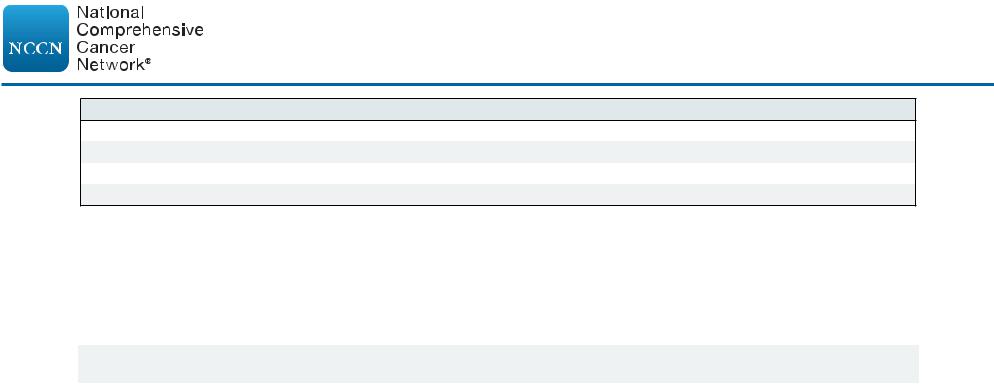
Printed by Ampleeva Olga on 3/26/2021 1:09:47 AM. For personal use only. Not approved for distribution. Copyright © 2021 National Comprehensive Cancer Network, Inc., All Rights Reserved.
NCCN Guidelines Version 3.2021
Hodgkin Lymphoma
NCCN Guidelines Index
Table of Contents
Discussion
NCCN Categories of Evidence and Consensus
Category 1 Based upon high-level evidence, there is uniform NCCN consensus that the intervention is appropriate. Category 2A Based upon lower-level evidence, there is uniform NCCN consensus that the intervention is appropriate. Category 2B Based upon lower-level evidence, there is NCCN consensus that the intervention is appropriate.
Category 3 Based upon any level of evidence, there is major NCCN disagreement that the intervention is appropriate.
All recommendations are category 2A unless otherwise indicated.
|
NCCN Categories of Preference |
|
Preferred intervention |
Interventions that are based on superior efficacy, safety, and evidence; and, when appropriate, |
|
affordability. |
||
Other recommended |
Other interventions that may be somewhat less efficacious, more toxic, or based on less mature data; |
|
intervention |
or significantly less affordable for similar outcomes. |
|
Useful in certain |
Other interventions that may be used for selected patient populations (defined with recommendation). |
|
circumstances |
||
|
All recommendations are considered appropriate.
Version 3.2021, 03/12/21 © 2021 National Comprehensive Cancer Network® (NCCN®), All rights reserved. NCCN Guidelines® and this illustration may not be reproduced in any form without the express written permission of NCCN.
CAT-1

Printed by Ampleeva Olga on 3/26/2021 1:09:47 AM. For personal use only. Not approved for distribution. Copyright © 2021 National Comprehensive Cancer Network, Inc., All Rights Reserved.
NCCN Guidelines Version 3.2021
Hodgkin Lymphoma
Discussion |
|
|
Hodgkin lymphoma. Last updated: April 17, 2020. |
|
|
|
This discussion corresponds to the NCCN Guidelines for |
|
Table of Contents |
|
|
Overview................................................................................................. |
MS-2 |
|
Literature Search Criteria and Guidelines Update Methodology ............. |
MS-2 |
|
Staging and Prognosis............................................................................ |
MS-3 |
|
The Role of PET Imaging in Patient Management.................................. |
MS-4 |
|
Interim PET Imaging ........................................................................... |
MS-4 |
|
Principles of Radiation Therapy .............................................................. |
MS-4 |
|
Treatment Guidelines.............................................................................. |
MS-5 |
|
Diagnosis and Workup ........................................................................ |
MS-5 |
|
Classic Hodgkin Lymphoma................................................................ |
MS-7 |
|
Stage I–II............................................................................................. |
MS-7 |
|
NCCN Recommendations for Stage I–II Favorable, Non-Bulky Disease |
||
........................................................................................................ |
|
MS-9 |
NCCN Recommendations for Stage I–II Unfavorable, Non-Bulky |
|
|
Disease ......................................................................................... |
MS-10 |
|
NCCN Recommendations for Stage I–II Unfavorable, Bulky Mediastinal |
||
Disease or Adenopathy >10 cm..................................................... |
MS-11 |
|
Stage III–IV ....................................................................................... |
MS-11 |
|
NCCN Recommendations for Stage III–IV Disease....................... |
MS-13 |
|
Management of Classic Hodgkin Lymphoma in Older Adults (>60 years) |
||
.......................................................................................................... |
|
MS-14 |
NCCN Recommendations for Older Adults (Age >60 years) with CHL |
||
...................................................................................................... |
|
MS-14 |
Nodular Lymphocyte-Predominant Hodgkin Lymphoma ................... |
MS-15 |
|
Follow-up After Completion of Treatment.......................................... |
MS-18 |
Monitoring for Late Effects ................................................................ |
MS-19 |
Secondary Cancers....................................................................... |
MS-19 |
Cardiovascular Disease................................................................. |
MS-19 |
Hypothyroidism.............................................................................. |
MS-20 |
Myelosuppression ......................................................................... |
MS-20 |
Infertility......................................................................................... |
MS-20 |
Pulmonary Toxicity ........................................................................ |
MS-20 |
Refractory or Relapsed Disease ....................................................... |
MS-20 |
Relapsed or Refractory Classic Hodgkin Lymphoma .................... |
MS-20 |
NCCN Recommendations for Refractory CHL .............................. |
MS-23 |
NCCN Recommendations for Relapsed CHL................................ |
MS-24 |
NCCN Recommendations for the Management of Relapsed or |
|
Refractory CHL in Older Adults (Aged >60 years)......................... |
MS-24 |
Relapsed or Refractory Nodular Lymphocyte-Predominant Hodgkin |
|
Lymphoma..................................................................................... |
MS-24 |
NCCN Recommendations for Refractory or Suspected Relapsed |
|
NLPHL........................................................................................... |
MS-25 |
Summary .............................................................................................. |
MS-25 |
References ........................................................................................... |
MS-27 |
Version 3.2021 © 2021 National Comprehensive Cancer Network© (NCCN©), All rights reserved. NCCN Guidelines® and this illustration may not be reproduced in any form without the express written permission of NCCN.
MS-1
